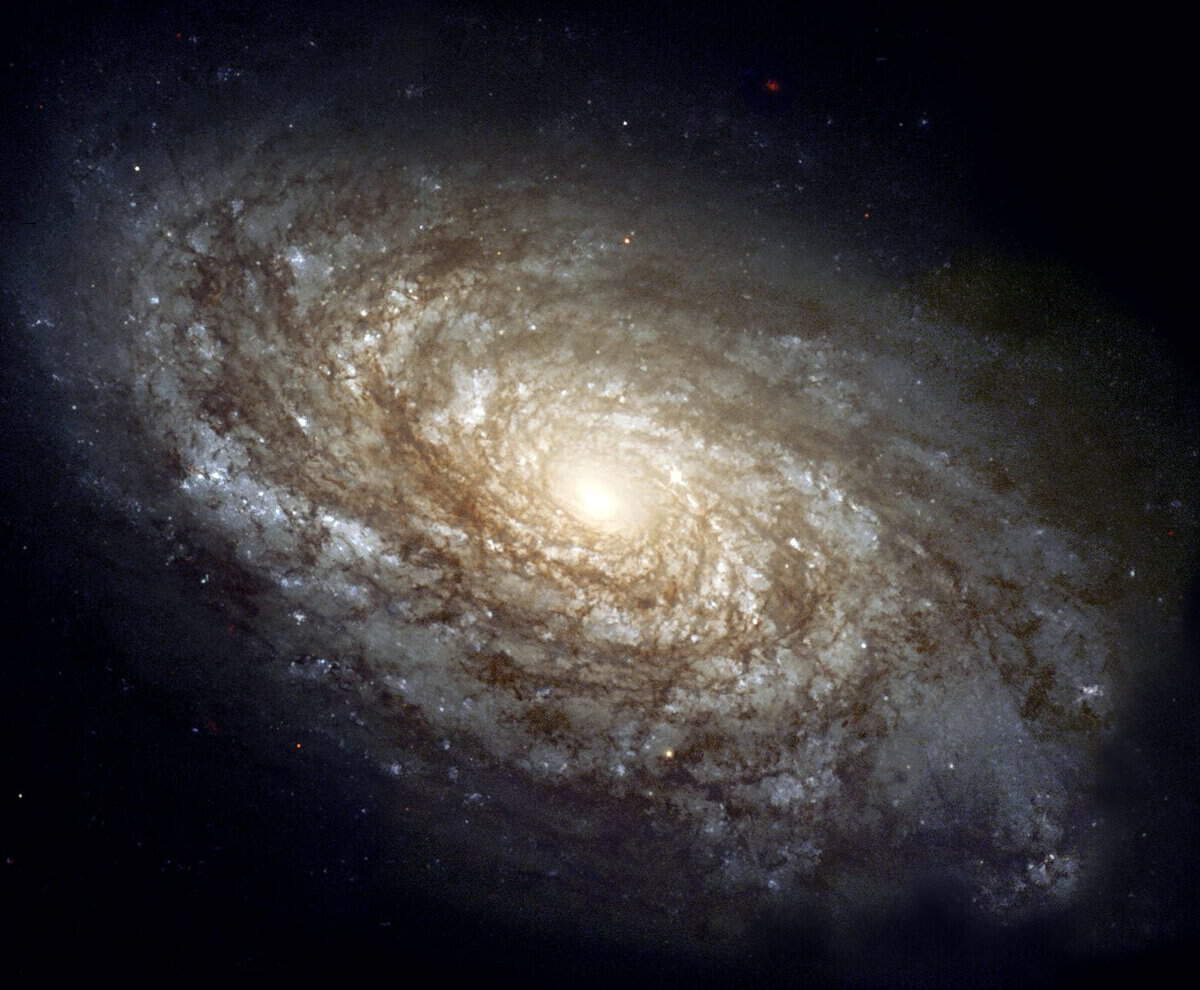A galaxy is a vast system of stars, planets, gas, and dust that are held together by gravitational forces. Galaxies are found throughout the universe and come in a variety of shapes and sizes. They can range from small dwarf galaxies with a few million stars to massive spiral or elliptical galaxies with billions of stars.
Galaxies are not isolated entities, but often exist in clusters or groups. These clusters can contain hundreds or even thousands of galaxies, all bound together by their mutual gravitational attraction. The Milky Way, the galaxy that contains our solar system, is part of a small group of galaxies known as the Local Group.
Galaxies are also incredibly old, with some of the oldest known galaxies dating back to just a few hundred million years after the Big Bang. They have been evolving and changing over billions of years, with new stars forming and old stars dying. The study of galaxies, known as galactic astronomy, helps us understand the history and structure of the universe.
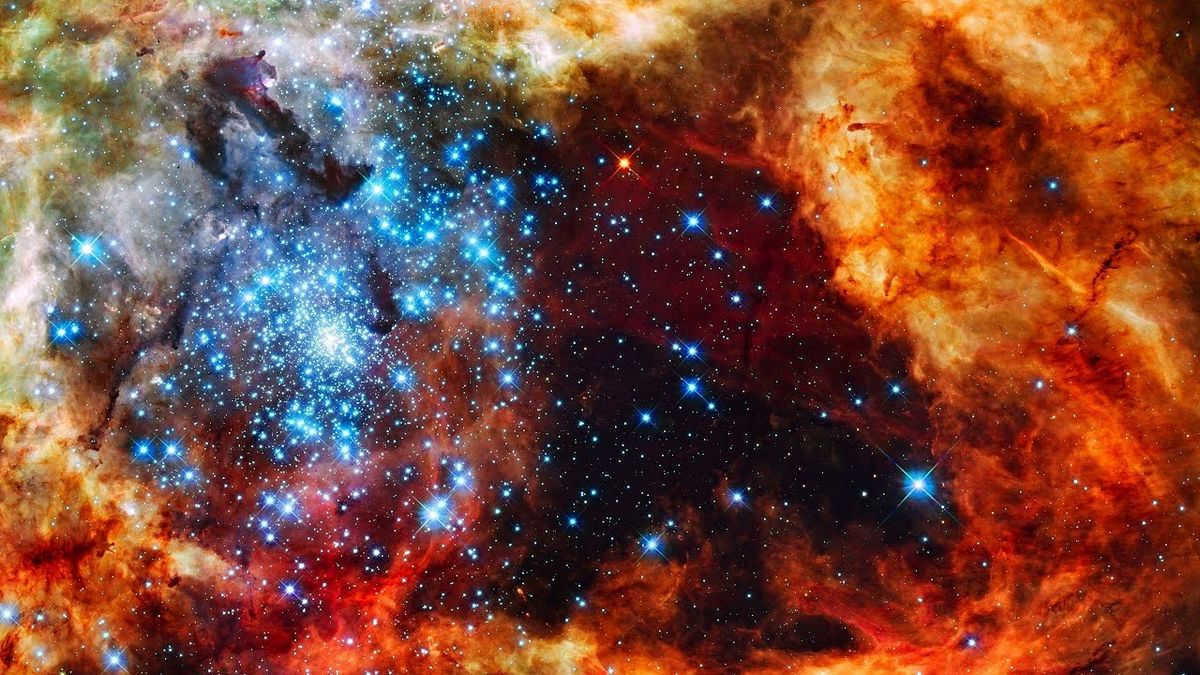
The universe is a vast and incredible place, teeming with wonders. Within our solar system lies the Milky Way galaxy, a collection of stars, planets, and celestial matter that stretches across billions of light-years. And yet, this is just a fraction of what exists out there, as there are an estimated two trillion galaxies in the universe, each with its own unique characteristics and discoveries.
One of the most fascinating aspects of galaxies is their varied shapes and patterns. While the Milky Way is known for its spiral shape, many other galaxies possess irregular or elliptical forms. These shapes are the result of gravitational interactions that bind the galaxies together, creating a tapestry of cosmic beauty.
Today, we will explore some of the most extraordinary galaxies that have been discovered by astronomers. Each one offers a glimpse into the vastness and complexity of the universe, showcasing its endless wonders.
1. The Sombrero Galaxy (M104).
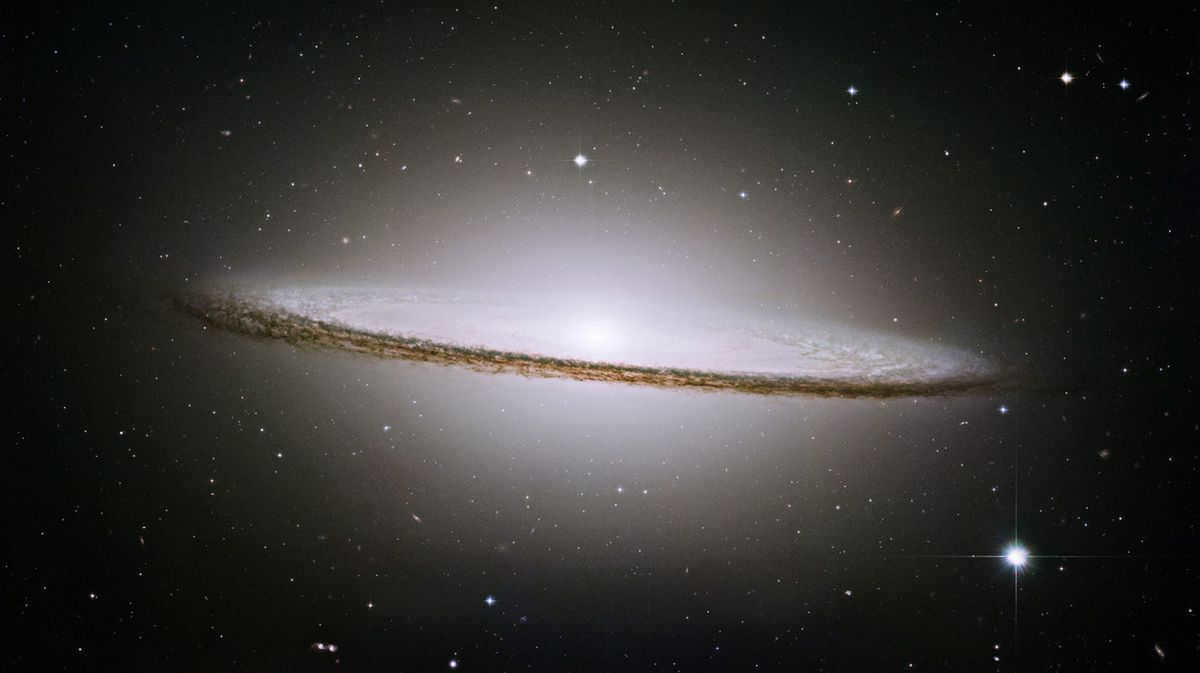
The Sombrero Galaxy, also known as NGC 4594 or Messier 104, is renowned for its exquisite beauty among galaxies in the vast universe. It boasts a dazzling central nucleus accompanied by a substantial central bulge. Moreover, a distinctive sloping disk formed by a dark dust lane adds to its unique appearance, giving it the resemblance of a sombrero. With a magnitude of +9.0, the Sombrero Galaxy can be easily observed using a basic telescope, making it a popular target for amateur stargazers.
2. The Black Eye Galaxy (M64).
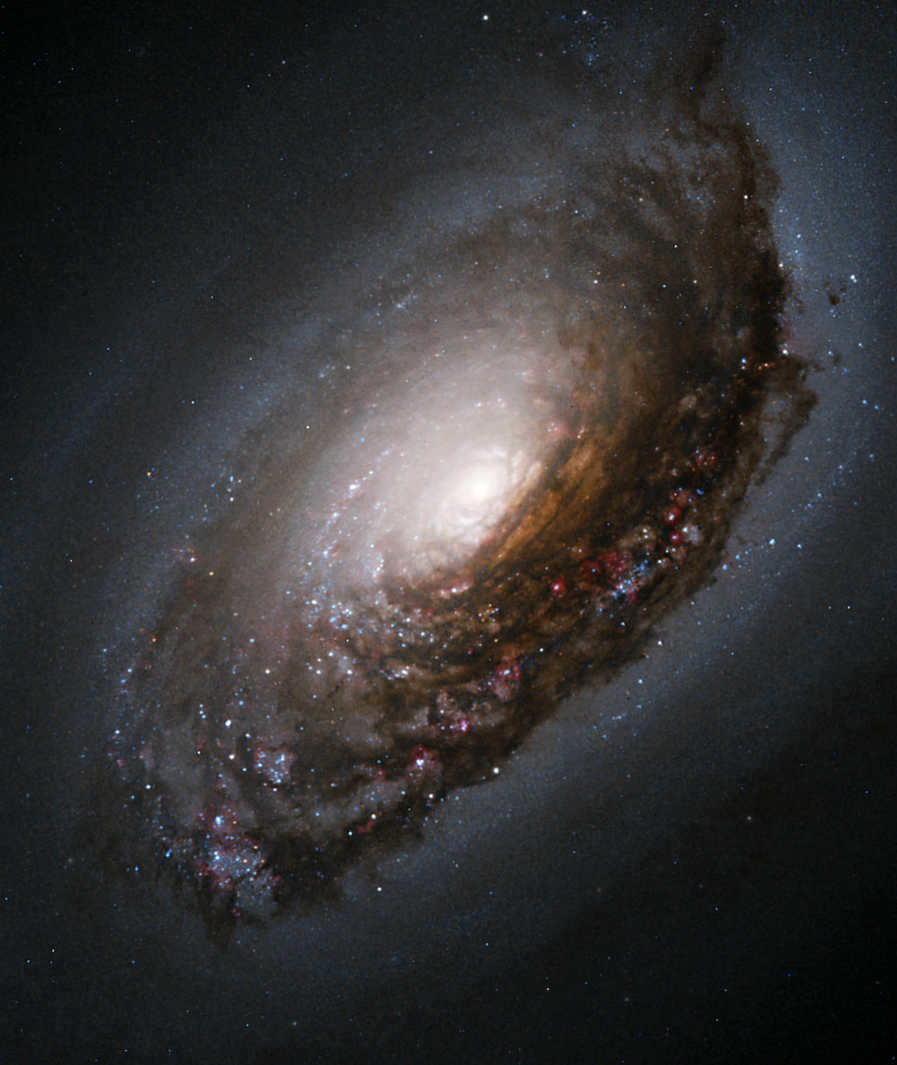
The Black Eye Galaxy, also known as the Sleeping Beauty Galaxy, is situated at a distance of approximately 17 million light years from our planet Earth. The galaxy is comprised of a vast array of stars which, when combined, create hydrogen gas. This phenomenon causes the central region of the galaxy to possess a reddish appearance. Interestingly, the interior of the Black Eye Galaxy rotates uniformly in one direction, while the stars and dust located 40,000 light years away rotate in the opposite direction.
3. M51: The Magnificent Whirlpool Galaxy.
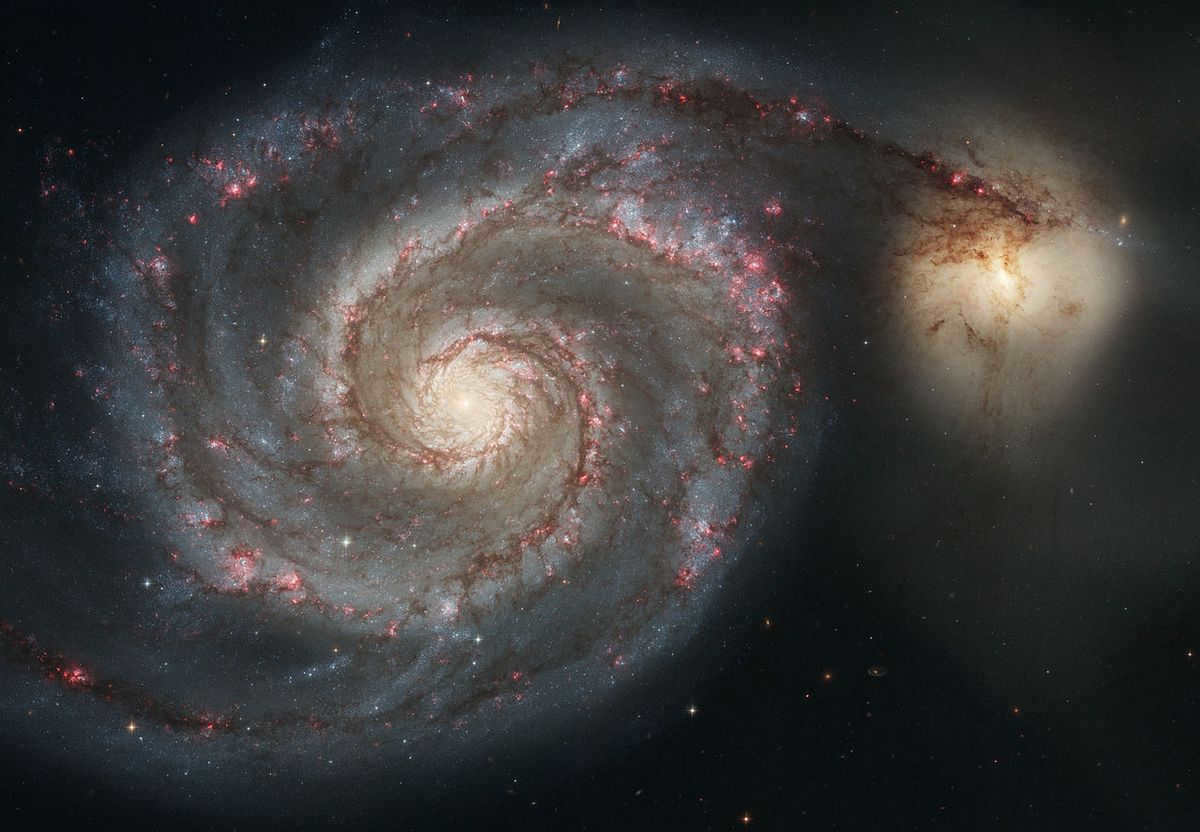
The Whirlpool Galaxy, also referred to as Messier 51 or NGC 5194, stands out as a renowned celestial body within the night sky. This awe-inspiring spiral galaxy, positioned roughly 23 million light years away in the Hound Dog constellation, can be readily observed using binoculars. Consequently, scientific researchers extensively examine the structural composition and interstellar interactions within this extraordinary galaxy.
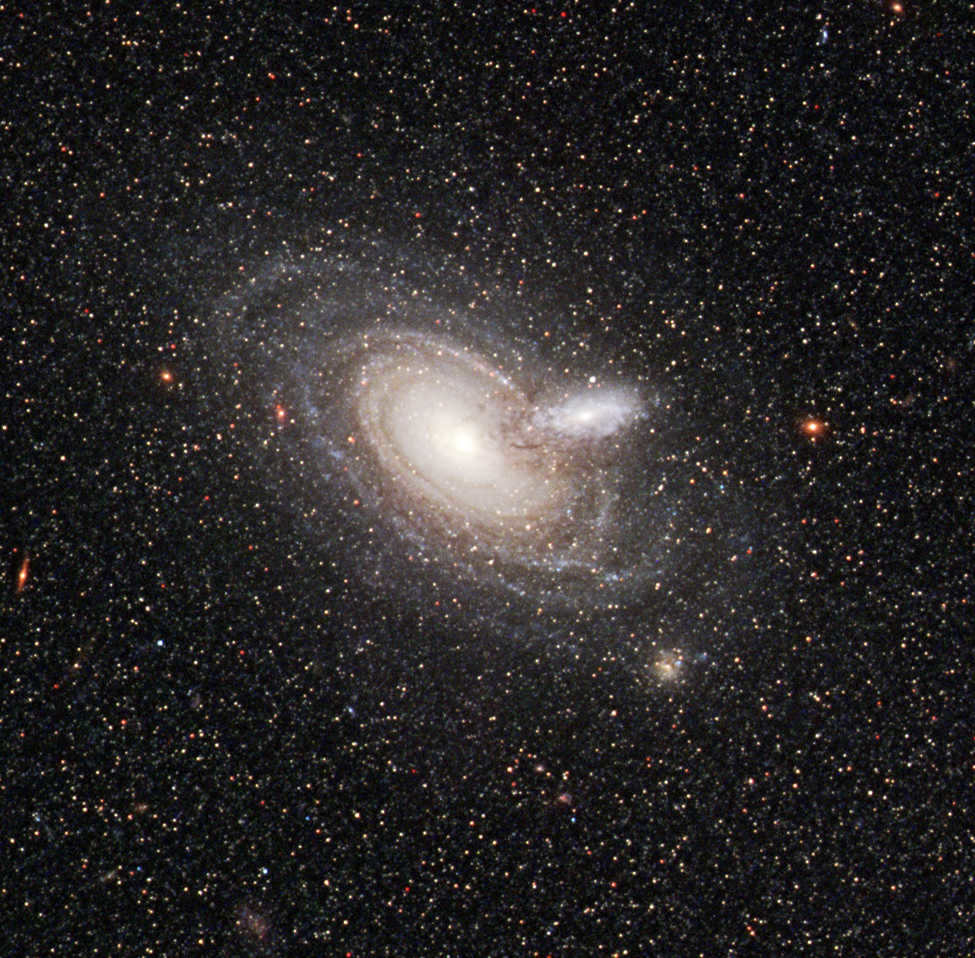
The Pair Galaxy of Enigma is comprised of a duo of intersecting spiral galaxies. It is positioned approximately 800 million light-years distant from the Milky Way galaxy. Extending galactic particles beyond the perceptible appendages of the spiral galaxy. Through which it is illuminated.
The particulate appendages of the galaxy are 6 times the radii of the galaxy’s star appendages. This is the reason why it is evidently observable in Hubble Space Telescope (HST) photographs against the central backdrop. It can also be perceived in the central regions of the backdrop galaxy.
5. Double ring structure of NGC 1512 spiral galaxy

NGC 1512, a galaxy situated in the Clock constellation, is positioned 30 million light years away from Earth. Scientists estimate its size to be approximately 70,000 light-years, similar to the dimensions of our own Milky Way Galaxy. Due to its vastness, NGC 1512 can be easily observed using amateur telescopes. Notably, it showcases a captivating dual ring configuration, with one encircling the galaxy’s nucleus and the other adorning its primary disk.
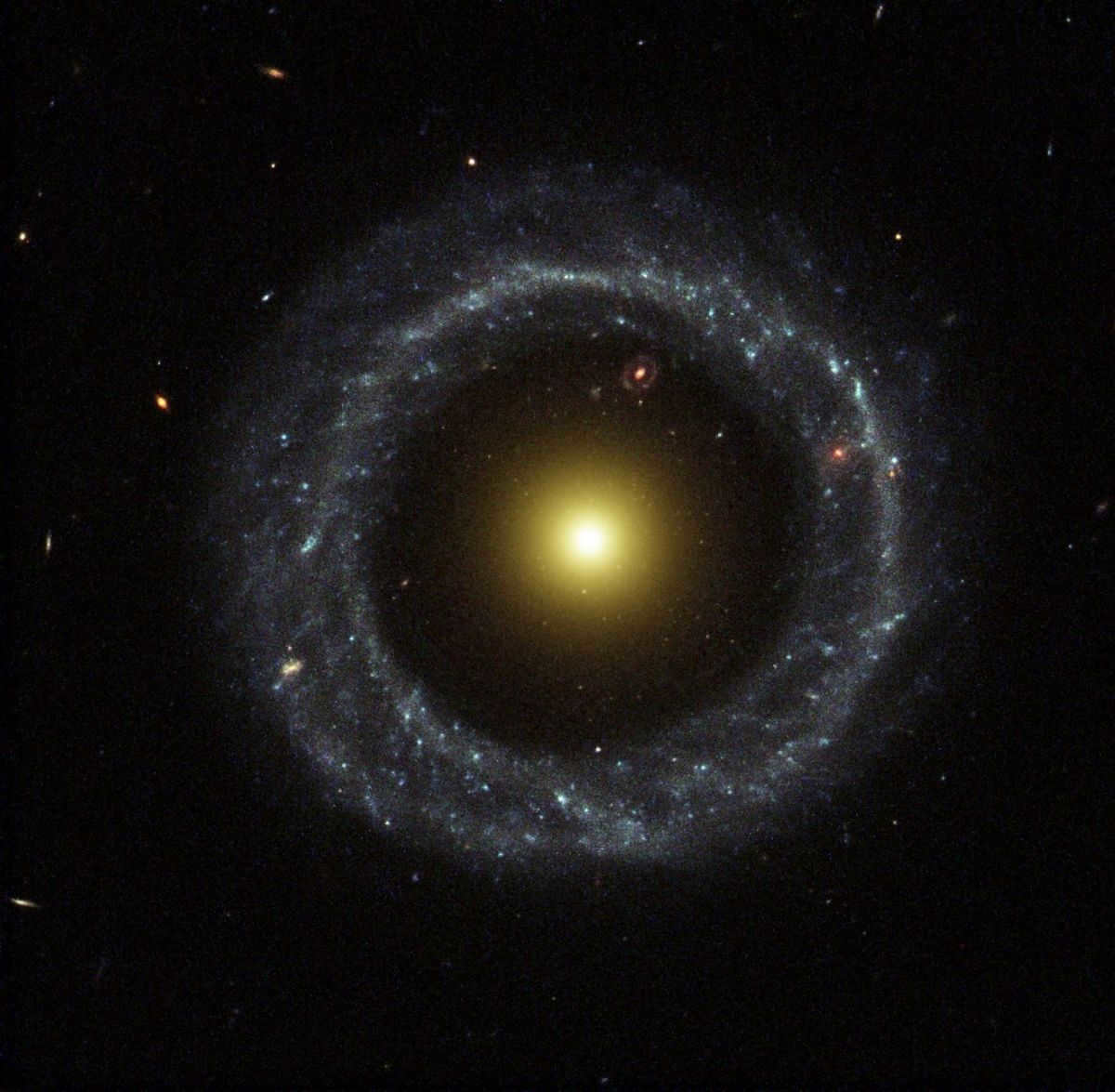
The discovery of the ring galaxy dates back to 1950 when Arthur Hoge first spotted it. For this reason, it is commonly referred to as Hoge’s Object. This peculiar celestial formation is often classified as either a planetary nebula or an anomalous galaxy. The outer circumference of the galaxy is adorned with vibrant blue stars, while a cluster of much redder stars occupies the central region, indicating that they are likely much older than their blue counterparts. Notably, a distinct dark void separates the outer ring from the galaxy’s core.
7. Bode Galaxy (Messier 81)
The Bode Galaxy, also known as Messier 81, is a spiral galaxy located in the constellation Ursa Major. It is one of the brightest galaxies visible from Earth and is a popular target for amateur astronomers. The galaxy was discovered by the German astronomer Johann Elert Bode in 1774 and was later included in Charles Messier’s famous catalog of nebulous objects. Messier 81 is approximately 12 million light-years away from Earth and has a diameter of about 90,000 light-years. It is believed to contain a massive black hole at its center, which is surrounded by a dense concentration of stars. The Bode Galaxy has been the subject of much scientific study and observation, and its unique features continue to fascinate astronomers and researchers.
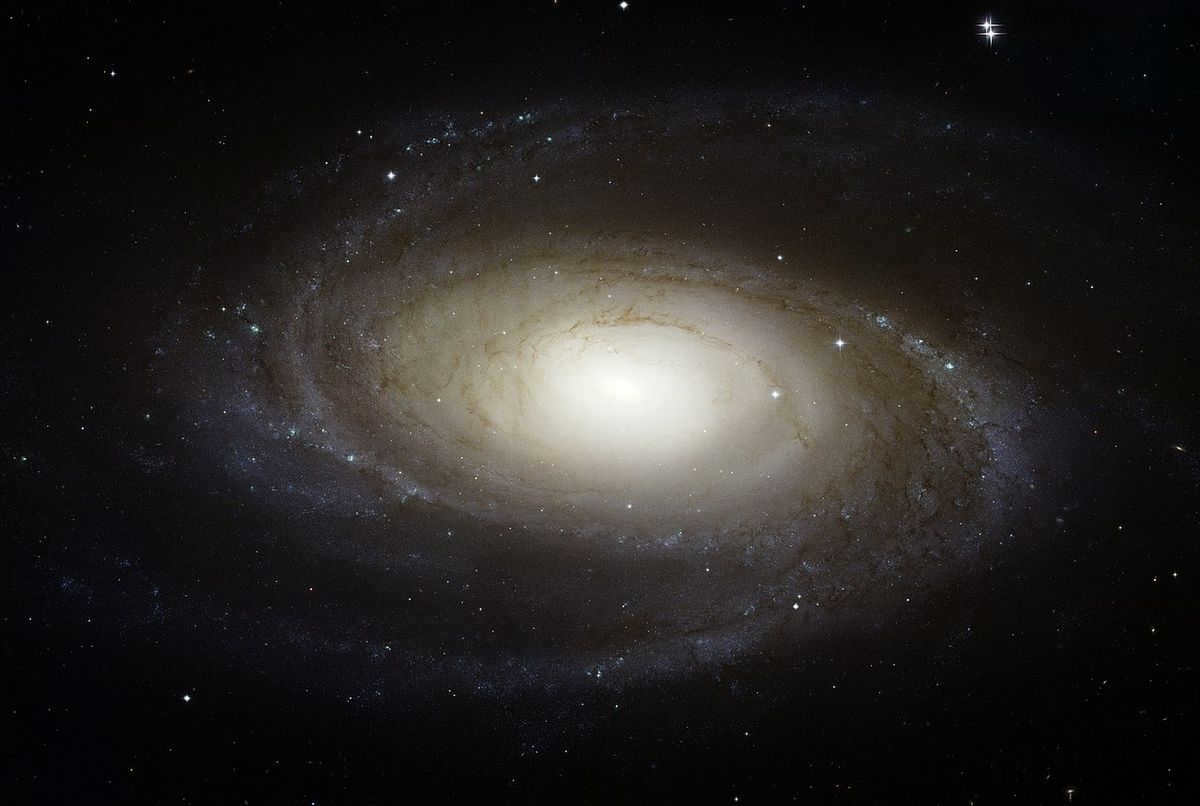
Messier 81 is a magnificent galaxy that stands out due to its immense size and stunning appearance. With its spiral shape, it captivates observers with its sheer beauty. Situated in the constellation Big Dipper, this celestial wonder lies approximately 8.5 ± 1.3 million light-years away from our planet. At the heart of this galaxy, there is a luminous nucleus that shines brightly. Moreover, its grand spiral arms and extensive bands of interstellar dust contribute to its overall allure and enchantment.
8. Supernova Galaxy SN 1987A
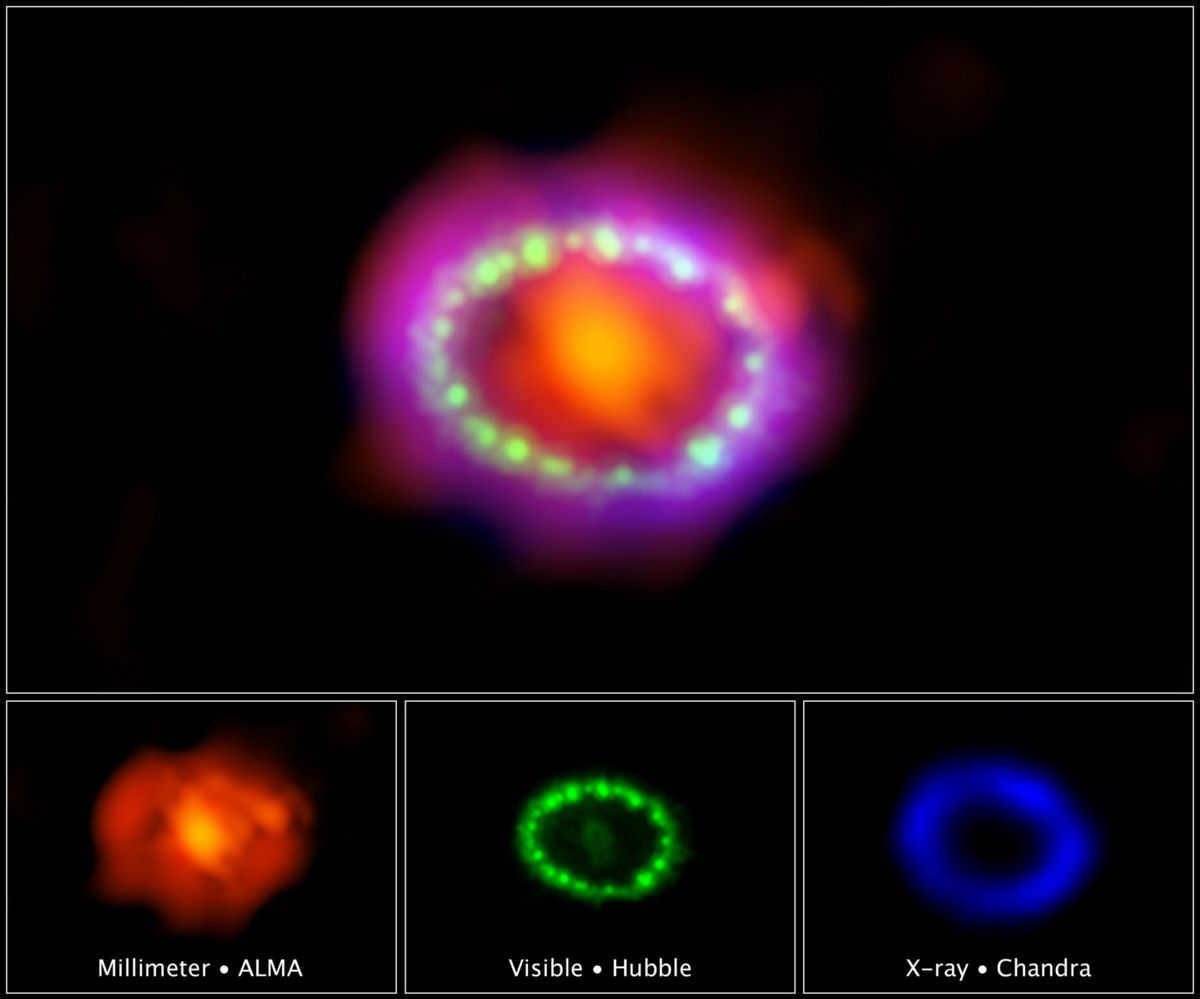
Located in the Large Magellanic Cloud, the galaxy SN 1987A can be found on the outskirts of the Tarantula Nebula. In February 1987, light from this galaxy first reached our planet. Its brightness reached its peak in May of the same year, registering an apparent magnitude of approximately 3.
Visible to the naked eye, this galaxy is easily observable from the Southern Hemisphere.
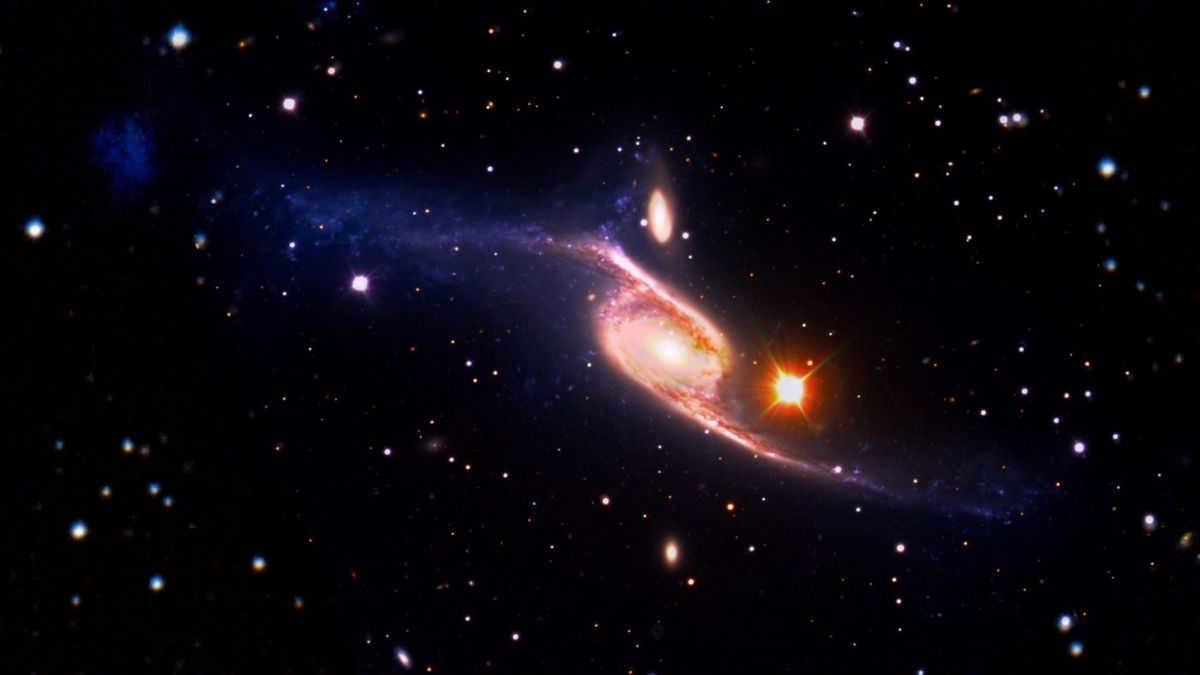
The Large Spiral Galaxy is a stunning celestial body in the vastness of the cosmos, showcasing its distinct spiral arms. These spiral arms gracefully stretch across the galaxy, encompassing various radii. Additionally, this awe-inspiring galaxy is adorned with an abundance of stars and mysterious dark dust.
Both the stars and dark dust are held together by the powerful force of gravity, as they orbit around the central core of the galaxy. It is noteworthy to mention that, as of 2002, approximately 10% of all known spiral galaxies have been classified as grand spirals.
10. NGC 3370 Galaxy
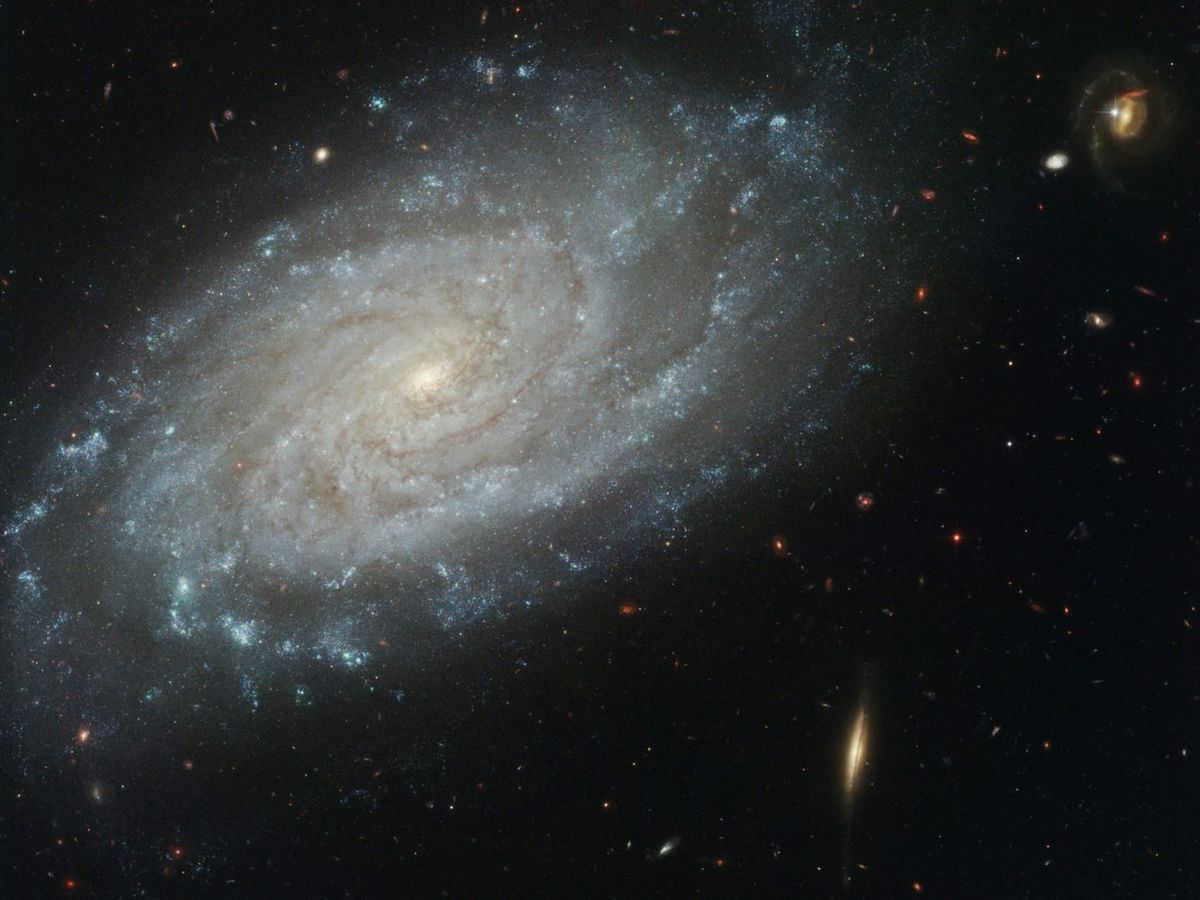
The galaxy NGC 3370 is renowned for its breathtaking beauty and abundance of interstellar dust, making it a truly unique phenomenon in the vast expanse of the universe. Situated in the Leo constellation, approximately 100 million light years away, this celestial marvel has been captured in all its splendor by the Hubble Space Telescope, utilizing state-of-the-art cameras to immortalize its magnificence. Furthermore, the images have allowed scientists to identify individual Cepheid variable stars within this galaxy, which play a crucial role in determining extragalactic distances between celestial bodies.
With a rich background spanning over 7 years in the field of journalism, I possess a deep understanding of media dynamics and possess exceptional skills in analyzing foreign sources of information.
Expert – Margarita Lopukhova
As a seasoned family psychologist, I have dedicated 8 years to salvaging and rejuvenating “family units” on the brink of disintegration. My expertise lies in guiding couples towards rediscovering love and fostering mutual understanding.
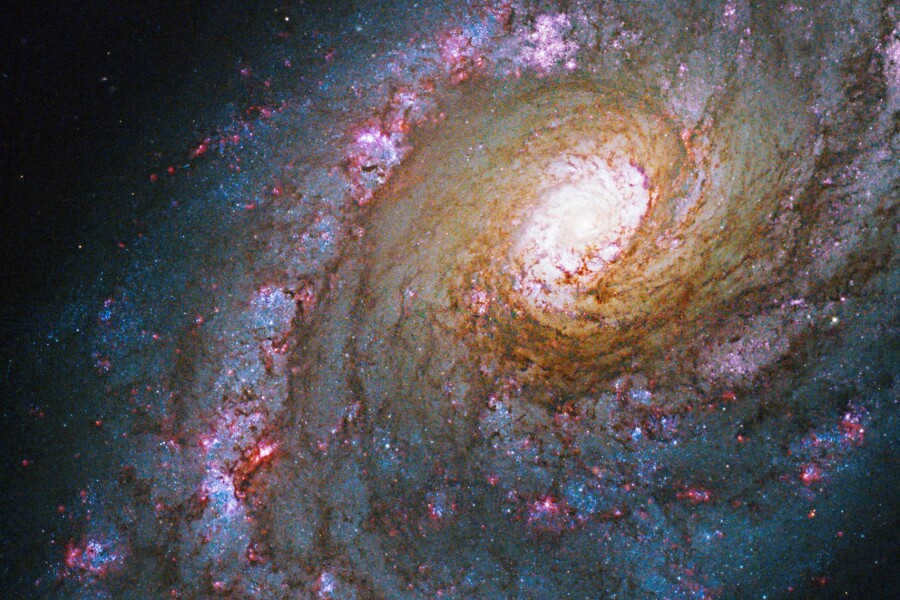
Within the expansive cosmos, an abundance of galaxies exists – massive conglomerations of stars radiating within the enigmatic obscurity of the Universe. Ranging from spiral to elliptical and even irregular formations, every galaxy displays a distinctive representation of the cosmic evolution. In this piece, we shall examine the various classifications of galaxies and endeavor to comprehend the true quantity within the boundless expanse of the Universe.
What types of galaxies are there in the Universe?
A galaxy is a massive collection of stars, planets, gas, dust, and dark matter that are held together by gravity. It is a vast system that serves as the fundamental building blocks of the Universe.
When we look up at the night sky on Earth, we can see numerous bright points of light – these are stars that belong to various galaxies. Many of these galaxies are so distant that it takes millions or even billions of years for their light to reach us.
- Spiral galaxies. These are among the most prevalent forms of galaxies. They boast prominent spiral arms comprised of vibrant young stars and regions of active star formation, as well as gas and dust. Our Milky Way serves as a typical exemplar of a spiral galaxy.
- Flat galaxies (ribbon galaxies). These galaxies possess a flattened structure with lengthy and slender arms that bear a resemblance to ribbons. They harbor star-forming gas and dust.
- Spiral barges. These are galaxies that exhibit spiral arms but also feature a bar, a luminous band of stars and gas that spans the center of the galaxy. This galaxy type amalgamates the characteristics of spiral and barred galaxies.
- Irregular galaxies. This variety of galaxy lacks a definitive shape and often appears disordered. They encompass substantial amounts of gas and dust and actively partake in star formation.
- Elliptical lenticular galaxies. This is a unique type of galaxy that combines the characteristics of both elliptical and lenticular galaxies. They possess a luminous central region surrounded by a ring-like formation.
- Quasars. Quasars are active nuclei of galaxies that emit massive amounts of energy, often in the form of intense radio waves and light. They are considered to be some of the most brilliant and distant objects in the entire universe.
- Interacting galaxies. These galaxies are currently engaged in the process of interaction and merging. As a consequence of this phenomenon, they have the ability to alter their shape and structure.
- Ring galaxies. These galaxies exhibit a distinctive ring structure composed of luminous stars and gas.
Spiral galaxies. These galaxies have a distinct spiral shape and are characterized by their prominent spiral arms. They contain a mix of young and old stars, as well as substantial amounts of gas and dust. Spiral galaxies are commonly found in less dense regions of space.
Counting the Galaxies
Pinpointing the exact quantity of galaxies in the universe remains an elusive task due to the ever-expanding nature of space and our limited knowledge of its vast reaches. Nevertheless, scientific estimates posit that the observable universe hosts a staggering range of 100 billion to 200 billion galaxies.
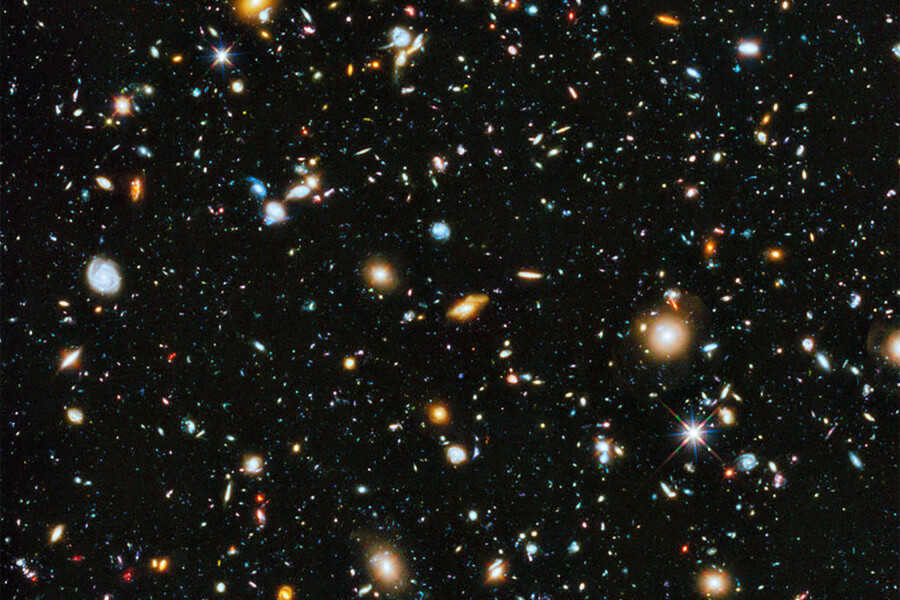
This estimation is based on data gathered by large telescopes and research on the cosmic background. However, considering the presence of numerous small, distant, and challenging-to-observe galaxies, the actual total may be even greater.
Myths and legends surrounding the galaxies of the universe
- Star Trek. In ancient cultures, such as the Aboriginal culture of Australia, there exists a legend called Star Trek. It recounts the tale of the Milky Way being a celestial pathway left behind by a woman as she traversed the sky, leaving stars in her wake.
- Star Bridge. In certain myths, like those found in Japanese culture, the Milky Way galaxy is depicted as a “Star Bridge”. According to this legend, two gods in love are separated by a river and can only reunite once a year when swallows create a bridge with their wings.
Exploring Galaxies through Scientific Research
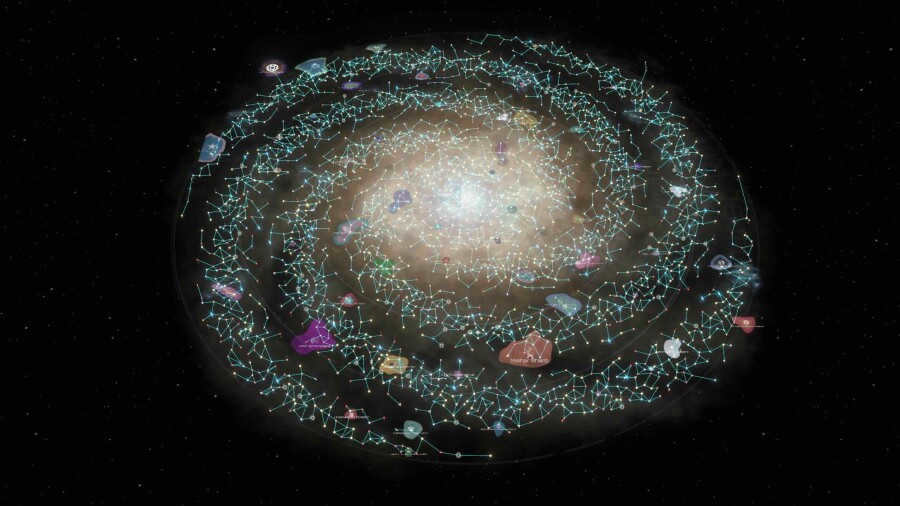
- The study of the black hole in the M87 galaxy by the M87 Event Horizon Telescope (EHT) was published in April 2019. The EHT is an international collaboration involving numerous astronomers and astrophysicists. This groundbreaking project utilized data from eight radio telescopes across the globe to create a virtual telescope the size of Earth. The findings from this research have provided new insights into the behavior and physics of black holes.
- In June 2020, the EHT conducted a study on the spiral arms within our own Milky Way galaxy. By analyzing data from various radio telescopes, astronomers were able to identify and examine intricate spiral arm structures. This research has significantly contributed to our understanding of the overall structure of our home galaxy.
- The publication date of the Galaxy Zoo survey, which explored the diversity of galaxies, was in 2008. This project involved members of the public who assisted researchers in classifying galaxies by examining images from space surveys. Thanks to the dedicated efforts of numerous volunteers, researchers were able to uncover the various shapes and types of galaxies present in the universe.
- There have been multiple studies conducted at different times that have focused on galaxy collisions. One notable study was the Antennas galaxy collision study, which was published in 2005. Scientists investigated the processes involved in the formation of new stars and the evolution of galaxies resulting from these collisions.
- The Milky Way (Milky Way) is our own galaxy, where the solar system is situated. The term Milky Way refers to the hazy striped path seen in the night sky, which is created by numerous stars.
- Andromeda (Andromeda) is the closest spiral galaxy to the Milky Way and can be seen with the naked eye in the night sky. It is named after Andromeda, the goddess from Greek mythology.
- Triangulum is another nearby spiral galaxy that is named after its location in the Triangulum constellation.
- The Large Magellanic Cloud (LMC) and the Small Magellanic Cloud (SMC) are galaxies named after the explorer Fernan Magellan. They can be observed from the southern hemisphere of Earth.
- The Sombrero Galaxy (M104) is an elliptical galaxy with a prominent ring-like arrangement of stars and dust that resembles a hat.
- The M74 galaxy, also known as The Beast, is named for its distinctive and luminous spiral shape.
- The NGC 4319 and Markarian 205 galaxies, collectively referred to as the Vertunya Galaxy, have attracted attention due to their apparent gravitational interaction or collision.
What would occur if these galaxies vanished?
- Lack of stars and planets. Galaxies contain numerous stars, which in turn give rise to planets. Without galaxies, there would be no stars and planets, and the conditions necessary for life as we know it would not exist.
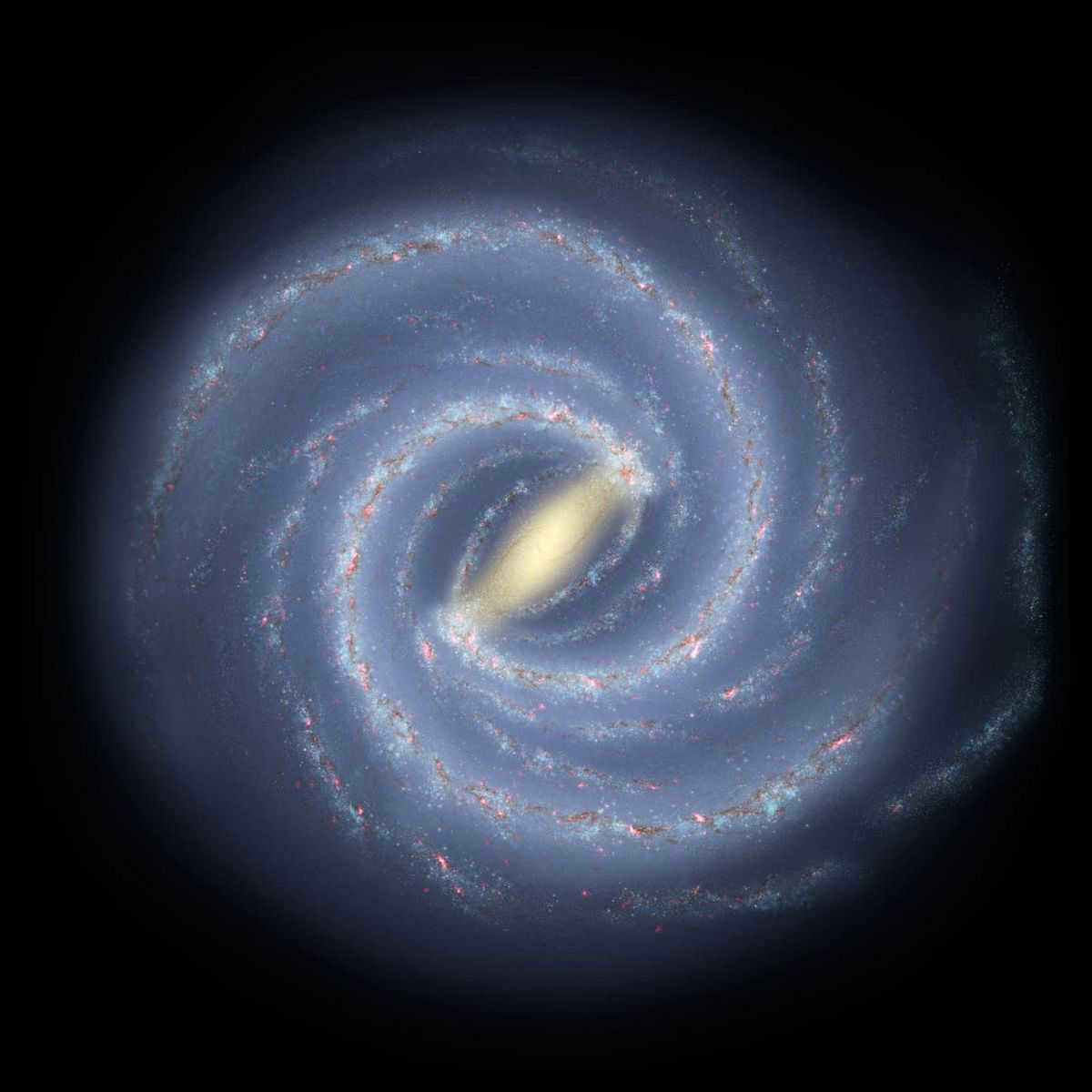
Galaxies are among the most stunning and magnificent celestial entities in the cosmos.
These gatherings of stars, dust, and gas serve as the cradles of stars and planets. They are akin to the continents of Earth in the vast expanse of the Universe. Without any more delay, here is a compilation of the most exquisite galaxies in the Universe, accompanied by captivating photographs.
The galaxy known as Arp 273
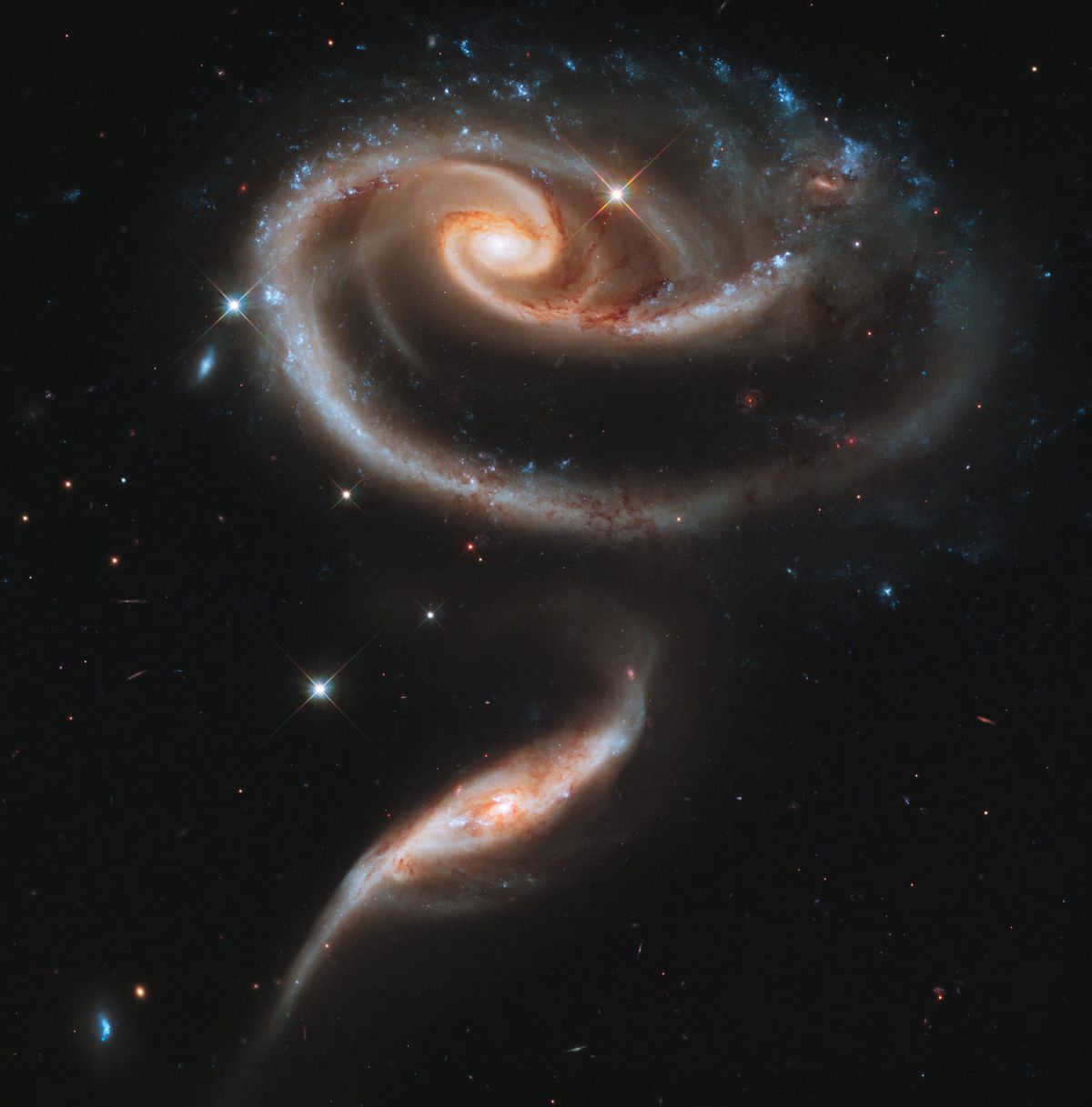
The Arp 273 galaxy consists of two separate galaxies, known as UGC 1810 and UGC 1813, which are situated within the Andromeda constellation.
These galaxies are positioned approximately 300 million light years away from our planet.
Astronomers have hypothesized that the smaller galaxy, UGC 1813, passed through the outer arms of UGC 1810, resulting in their distinctive rose-like shape.
This interaction caused a significant accumulation of gas within the UGC 1810 galaxy. This influx of new material and gas facilitated the formation of numerous young stars. The presence of these newly formed stars is evident through the abundance of blue hues, which indicate regions rich in vibrant, hot, and youthful stars.
This pair of galaxies was initially documented in the Atlas of Special Galaxies, a publication released in 1966. Created by the American astronomer Halton Arp, this catalog aimed to showcase extraordinary and peculiar galaxies.
Further investigations into this matter, as well as the analysis of Hubble images in the 1990s, have revealed that the morphology of numerous galaxies can be attributed to the interactions and collisions of two separate galaxies, leading to their distortion or merging into a single entity.
The Sombrero Spiral Galaxy
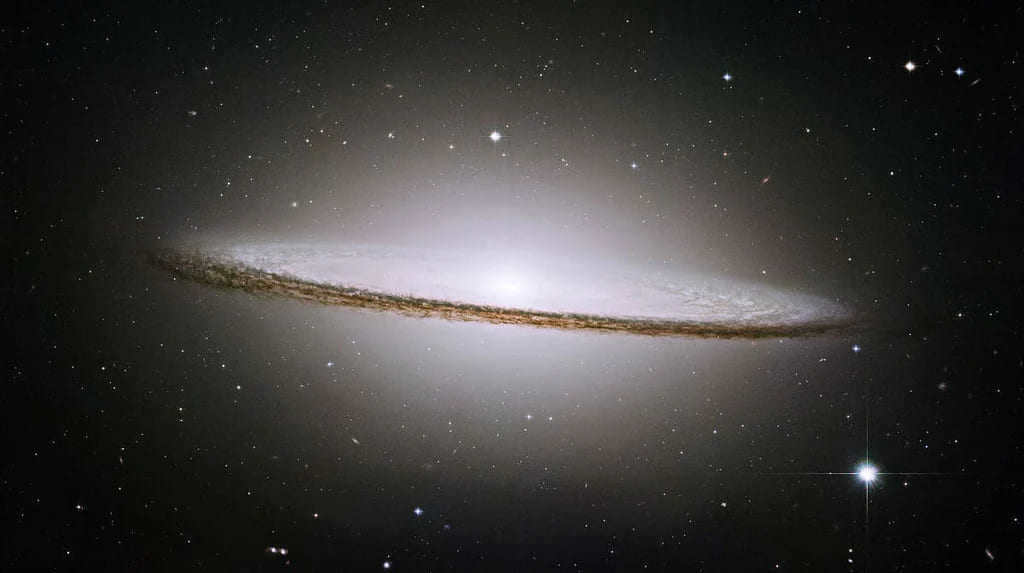
The spiral galaxy M104, also known as the Sombrero Galaxy, was first discovered in 1781 by French astronomer Pierre Mechene, who was working with astronomer Charles Messier.
Located in the Virgo constellation, the Sombrero Galaxy is approximately 28 million light-years away from Earth. It has a diameter of 49,000 light-years, making it slightly smaller than our Milky Way.
The distinctive appearance of this galaxy is attributed to the dense dust cloud that forms its outer ring.
This region, which is rich in stars, is experiencing a high level of star formation.
Images captured by the Hubble Space Telescope reveal the presence of a supermassive black hole at the center of this galaxy, estimated to have a mass 1 billion times that of our Sun.
Galaxy M 106
can be rephrased as
Galaxy M 106
is a smartphone model.
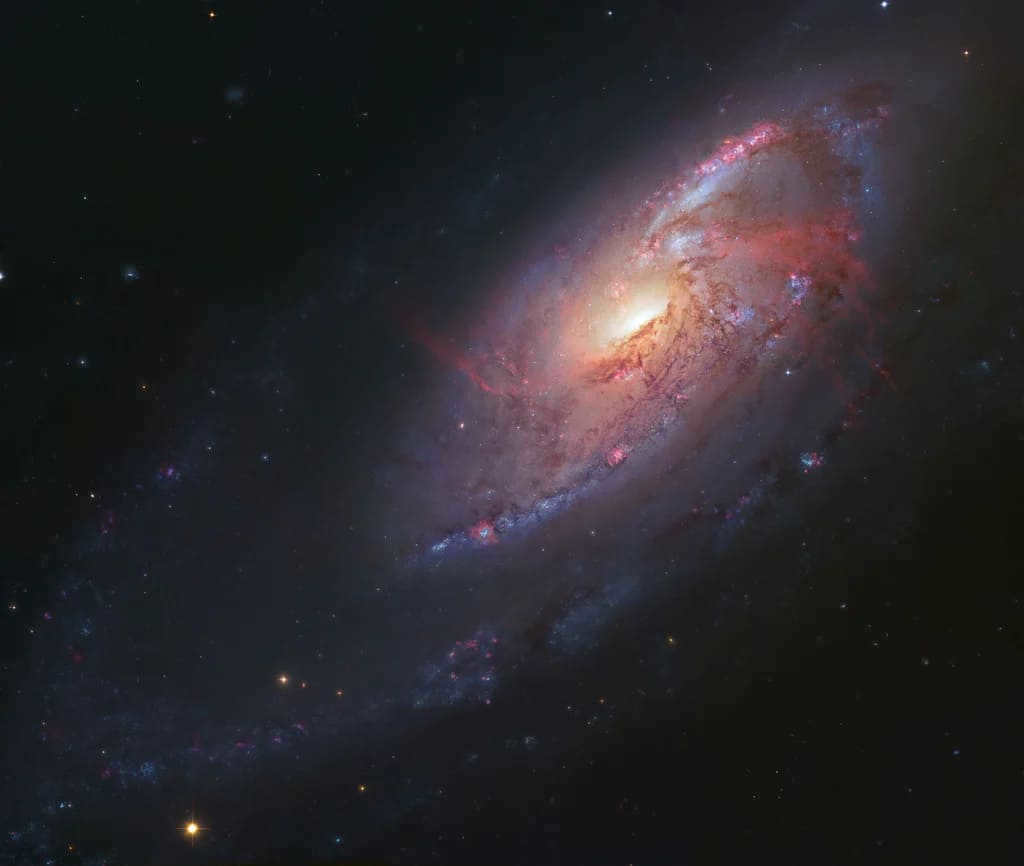
Galaxy M106, also known as NGC4258, was first discovered in 1781 by French astronomer Pierre Mechene, who was an assistant to Charles Messier. Unlike the other nebulae in Messier’s catalog (which includes galaxies with names starting with M), this one was added much later, in 1947, by Canadian astronomer Helen Sawyer Hogg.
M106 can be found in the Hound Dog constellation. With a diameter of approximately 130,000 light years, it is quite similar in size to our own Milky Way galaxy.
It is located approximately 23.5 million light-years away from Earth.
Infrared images of this galaxy have revealed an additional set of arms, which can be seen as red in the image. Astronomers believe that these arms are caused by the presence of a supermassive black hole at the center of this galaxy.
The M 100 spiral galaxy with a unique jumper
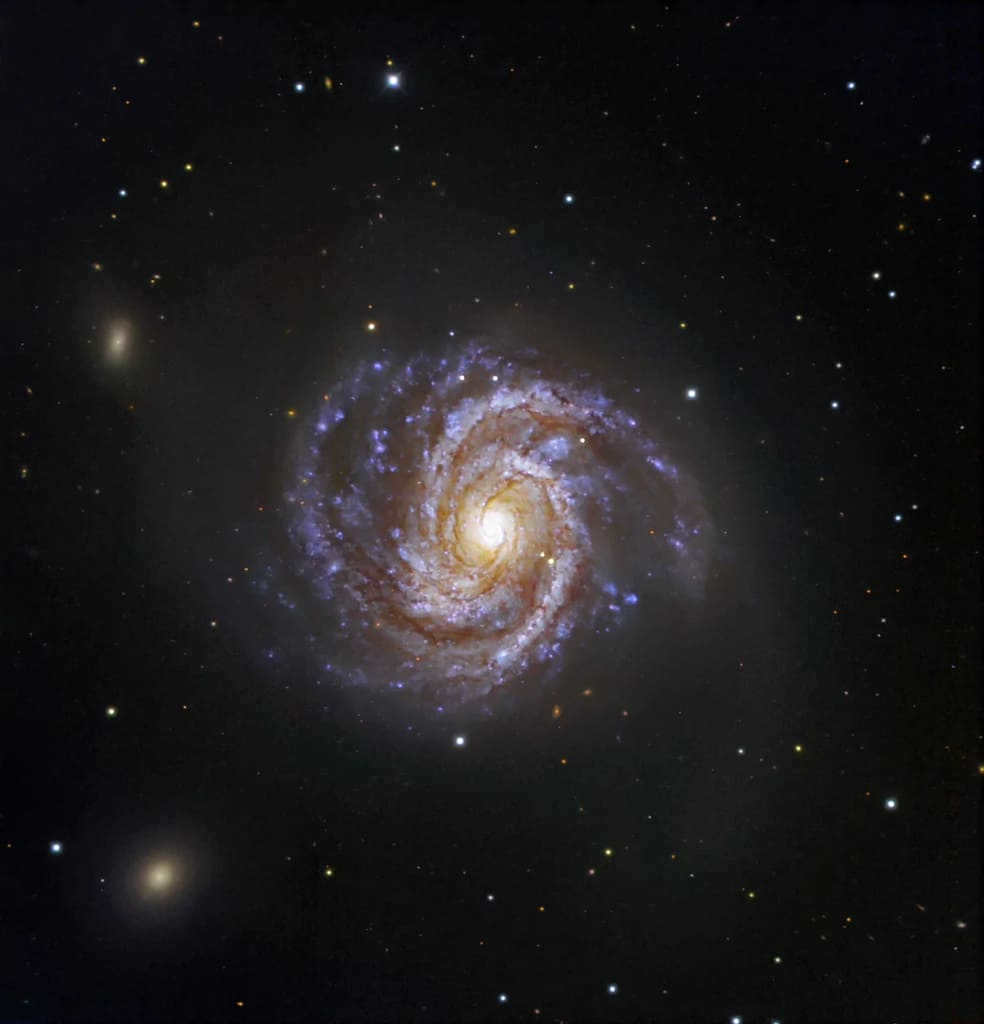
This incredible galaxy, known as M100, was famously discovered on March 15, 1781, by the renowned French astronomer Pierre Mechene. His close associate Charles Messier observed it just a month later and promptly added it to his comprehensive catalog of nebulae and celestial objects.
The M100 galaxy can be found in the constellation of Veronica’s Hair, and it is estimated to be approximately 66 million light-years away from our planet.
Scientists have estimated that the diameter of M100 is about 145,000 light years, making it strikingly similar in size to our very own Milky Way.
Tucked away at the heart of this extraordinary galaxy lies a supermassive black hole, thought to have a mass ranging between 3.4 and 7.4 million times that of our Sun. That is an absolutely mind-boggling 3.4 to 7.4 million solar masses!
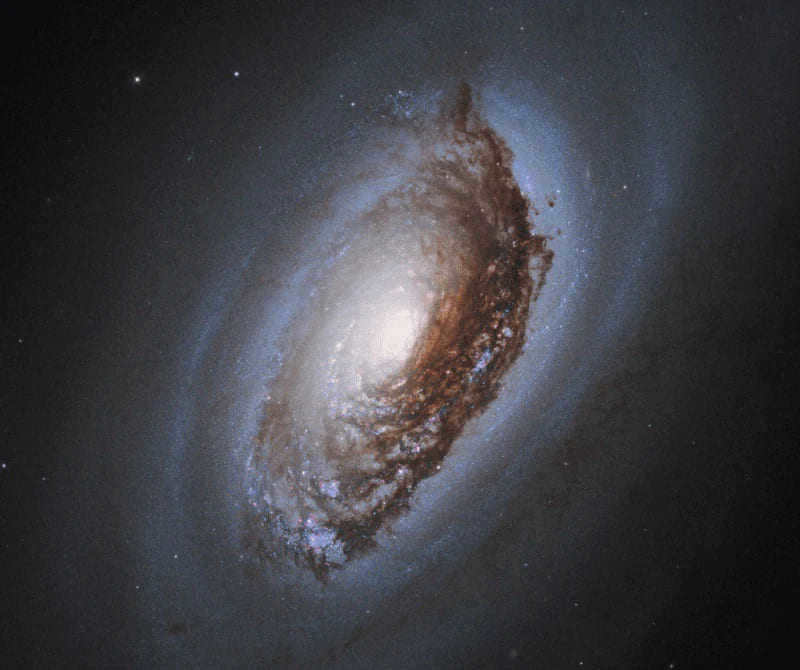
The discovery of the Black Eye Galaxy (Messier 64) is credited to Edward Pigott, an astronomer from Britain, who made the observation in March 1779.
Situated in the constellation known as Veronica’s Hair, this galaxy is estimated to be located approximately 17 million light-years away.
One of the defining features of the Black Eye Galaxy is the presence of opaque gas clouds, which obscure the view of billions of stars that exist within it.
Additionally, this galaxy exhibits a peculiar phenomenon where its inner and outer disks rotate in opposite directions, resulting in the formation of regions with dense gas and active star formation.
The Andromeda Galaxy
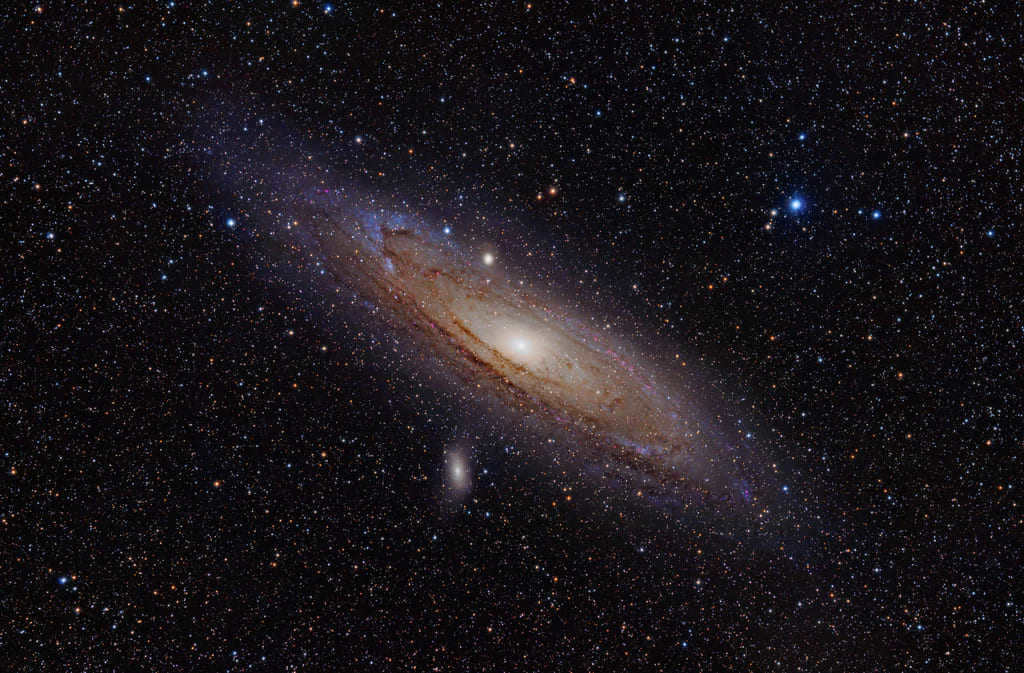
The M31 galaxy, also known as the Andromeda Galaxy, is the closest neighbor to our Milky Way. Situated approximately 2.5 million light-years away from Earth, it is a breathtaking sight.
Spanning an impressive 220,000 light-years from one end to the other, the Andromeda Galaxy boasts an astonishing one trillion stars. This makes it a whopping 25% larger than our very own Milky Way.
In a cosmic dance that will take place in approximately 4.5 billion years, the Andromeda Galaxy is expected to collide with our own Milky Way. Moving at a speed of just over 110 kilometers per second, this collision will be a truly spectacular event.
The spiral galaxy NGC 2207, also known as IC 2163
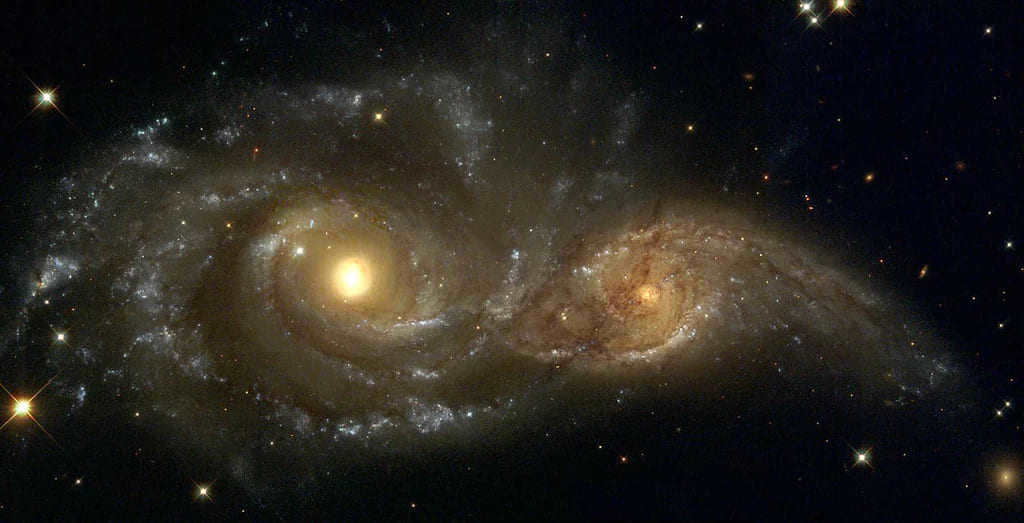
As depicted in the image, the two galaxies captured in the photograph are currently locked in an epic confrontation.
NGC 2207 and IC 2163, known as the Galaxies, are currently engaged in a mesmerizing collision within a cosmic whirlpool.
According to astronomical projections, in a few billion years, it is anticipated that only a single galaxy will endure from this cataclysmic encounter.
Situated approximately 130 million light-years distant from our planet, these two galaxies can be found within the constellation Canis Major, also known as the Big Dog.
UGC 2885: An Extraordinary Spiral Galaxy
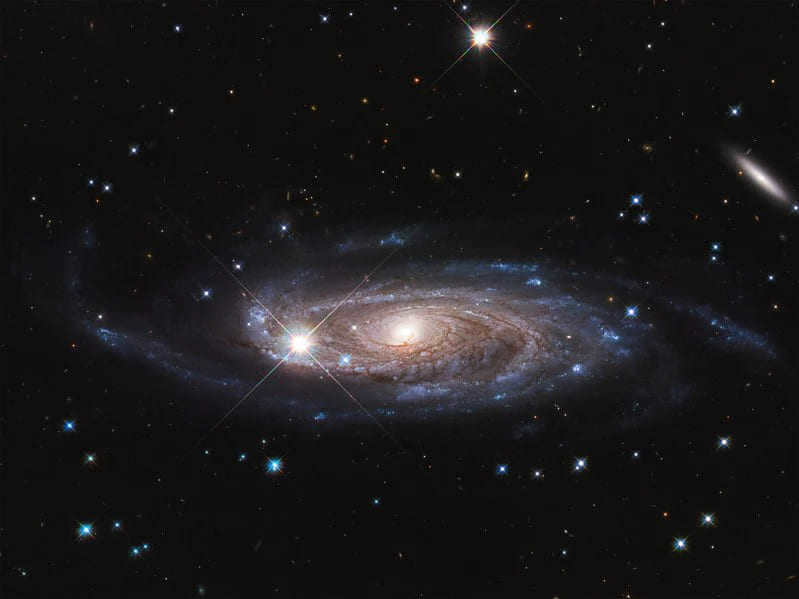
UGC 2885, a galaxy situated in the Perseus constellation, lies approximately 232 million light years away from our planet.
This particular galaxy boasts an immense size, measuring 416,000 light-years in diameter, which is twice the size of the Milky Way and harbors about 1 trillion stars, making it ten times more star-rich.
UGC 2885 is recognized as one of the most colossal spiral galaxies ever observed.
In the night sky, it can be found within the Perseus constellation.
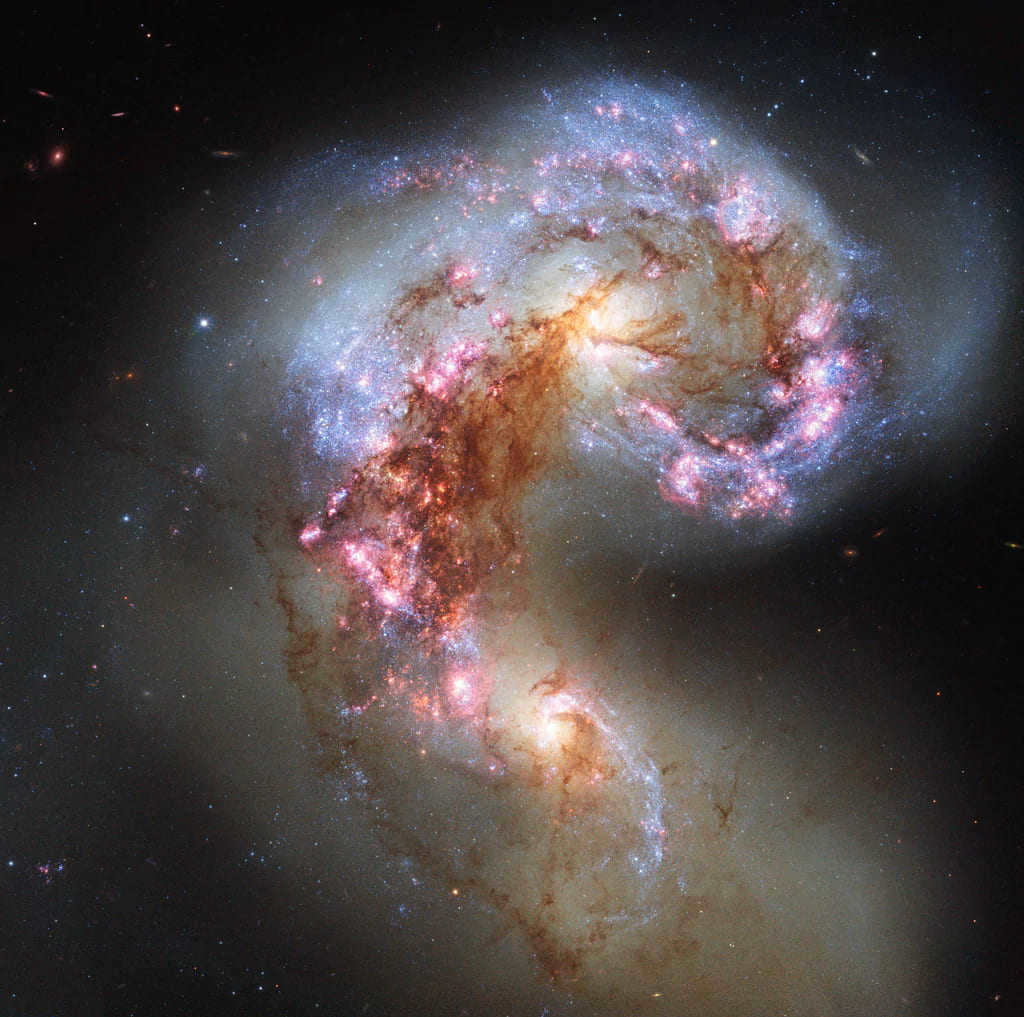
These magnificent photographs of the Antennae galaxies (NGC 4038/NGC 4039) were captured by the Hubble, Chandra, and Spitzer space telescopes.
British astronomer William Herschel first spotted this duo of galaxies in 1785.
Situated 45 million light-years away from our own Milky Way, this pair of galaxies is composed of two galaxies that collided millions of years ago.
In just a few million years, the cores of these two galaxies will merge, resulting in the formation of an elliptical galaxy.
The Cartwheel lenticular galaxy.
The galaxy known as the Cartwheel is a lenticular galaxy with a unique structure.
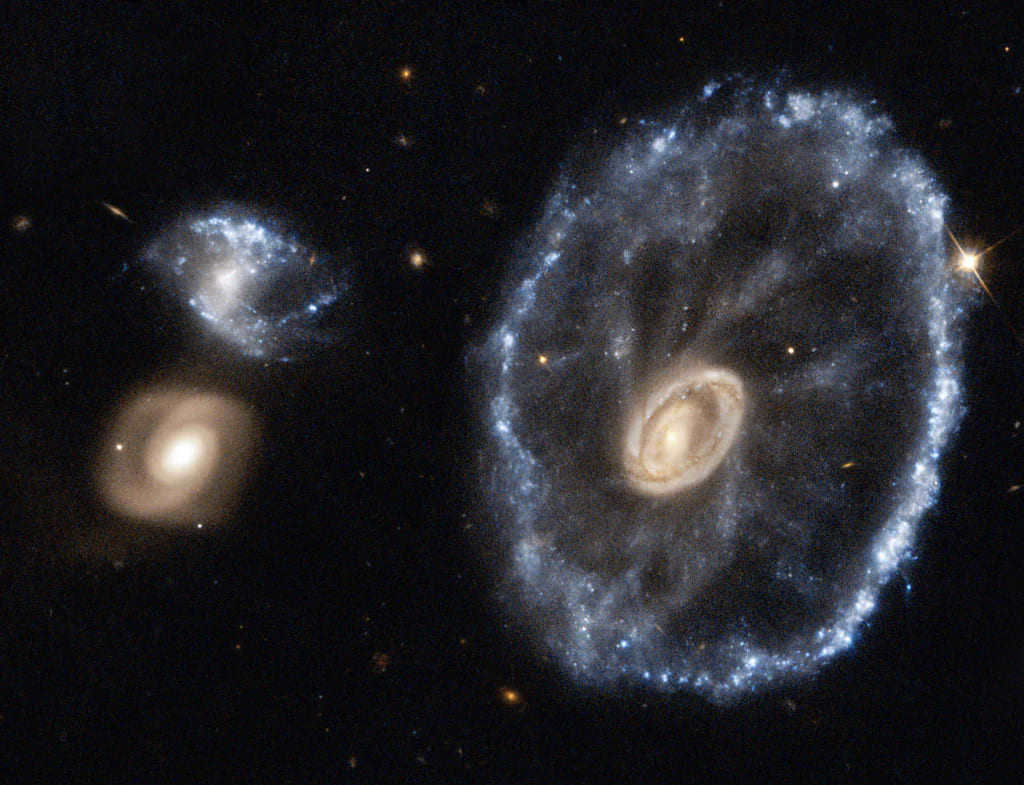
The Cartwheel Galaxy (ESO 350-40) was first identified by astrophysicist Fritz Zwicky in 1941. Its distinctive shape is believed to be the result of a collision between two galaxies that occurred approximately 200 million years ago.
A shock wave generated by the collision propagated through the galaxy, creating an outer ring with spiral arms extending from the center, resembling the spokes of a wheel.
The Cartwheel galaxy has a diameter of approximately 150,000 light years, making it comparable in size to our own Milky Way. It is located approximately 500 million light years away from Earth.
NGC 3147: A Fascinating Galaxy in the Cosmos
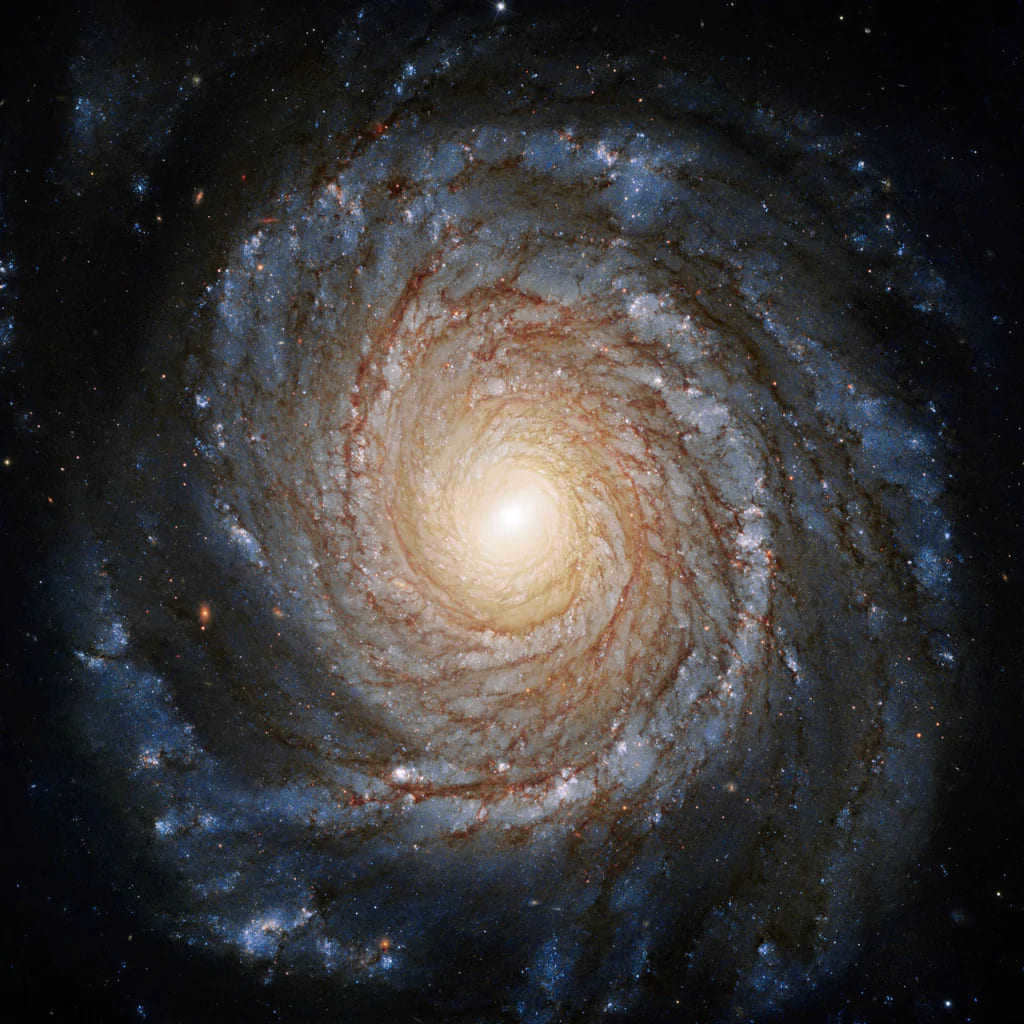
NGC 3147 is a spiral galaxy that showcases its various features due to its orientation. The discovery of this galaxy dates back to 1785 when British astronomer William Herschel first observed it.
Located in the constellation Dragon, NGC 3147 graces the night sky.
With a diameter of approximately 145,000 light years, this galaxy is comparable in size to our very own Milky Way. Its distance from Earth is estimated to be around 130 million light-years.
Although the intensely luminous center of NGC 3147 may not give it away, a massive supermassive black hole resides at its core. The brightness visible in the image is a distinct characteristic of active galaxies.
Centaurus A: A Unique Lenticular Galaxy
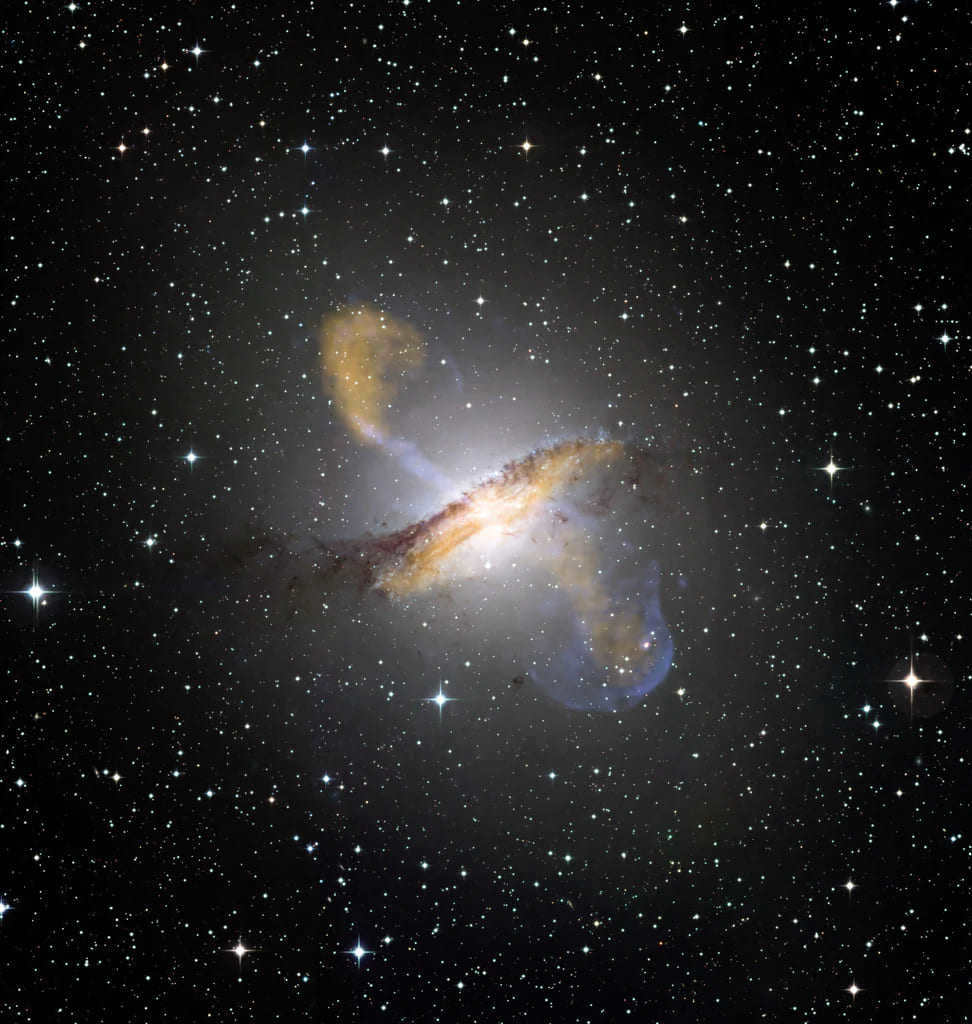
The Centaurus A galaxy, also known as NGC 5128, was first observed by James Dunlop, a Scottish astronomer, in 1826.
This captivating galaxy, located just 11 million light years away from Earth, never fails to amaze.
The extraordinary brightness displayed in this image is not a mere illusion. In fact, it is the fifth brightest galaxy visible in the night sky.
Astronomers hypothesize that the unique shape of this galaxy is the result of a collision with another galaxy.
Centaurus A is classified as a radio galaxy, which means it predominantly emits energy in the form of X-rays and radio waves. This sets it apart from classical galaxies, which derive most of their energy from the matter, gas, and dust they contain.
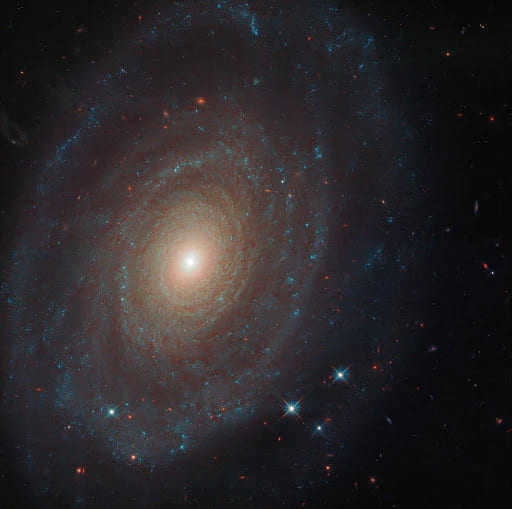
The galaxy NGC 691 was observed by astronomer William Herschel in 1786 and is situated in the constellation Aries, approximately 120 million light-years away.
With a diameter of approximately 130,000 light-years, NGC 691 is considered to be quite large.
NGC 1559, on the other hand, is a spiral galaxy that features a junction.

The astronomer James Dunlop discovered this particular galaxy in 1826.
It can be found in the Setka constellation and is situated approximately 50 million light-years from our planet.
What sets this galaxy apart is its lack of affiliation with any galaxy cluster, meaning it remains unaffected by the gravitational forces exerted by neighboring galaxies.
The NGC 2608: A Spiral Galaxy with a Connection
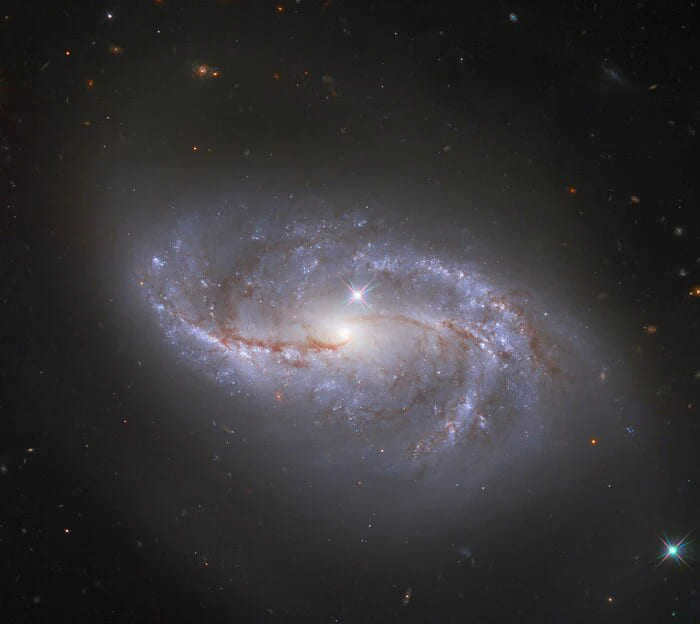
NGC 2608, a spiral galaxy resembling our Milky Way, showcases the presence of arms connected to a stellar bar that runs through the galaxy’s center.
NGC 2608 is situated approximately 93 million light-years away from our planet.
The discovery of NGC 2608 dates back to March 1785 when the German-born British astronomer William Herschel first observed it.
This galaxy measures around 62,000 light years in diameter.

NGC 5468, which was first observed in March 1785 by astronomer William Herschel, is a spiral galaxy.
This galaxy can be found in the constellation Virgo and is situated approximately 140 million light-years from Earth.
With an estimated diameter of around 110,000 light-years, NGC 5468 is comparable in size to our own Milky Way galaxy.
NGC 5643 is a spiral galaxy that has a convergence point.

NGC 5643 is situated in the Wolf constellation and is approximately 60 million light-years away from Earth.
Astronomer James Dunlop first identified this galaxy in 1826.
To capture this stunning image, Hubble needed to direct its mirror towards NGC 5643 for a total duration of nine hours.
The spiral galaxy NGC 2525 in the intersection
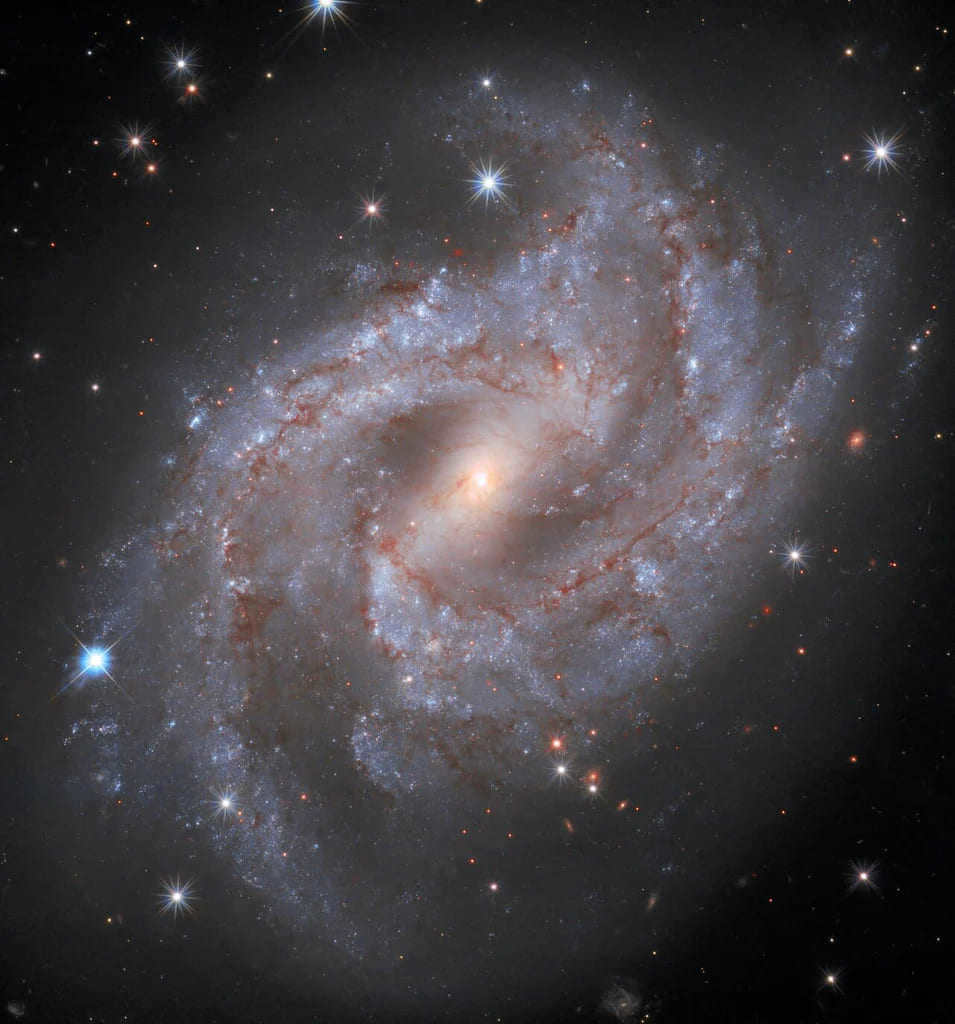
The discovery and classification of NGC 2525, a spiral galaxy, dates back to 1791 when astronomer William Herschel first observed it.
Situated in the constellation Corma, this galaxy is approximately 70 million light years distant from Earth.
NGC 2525 boasts a size of around 63,000 light years.
Notably, in 2018, it became the focal point of an extraordinary supernova event, which is visible on the left side of the photograph.
The M51 Spiral Galaxy
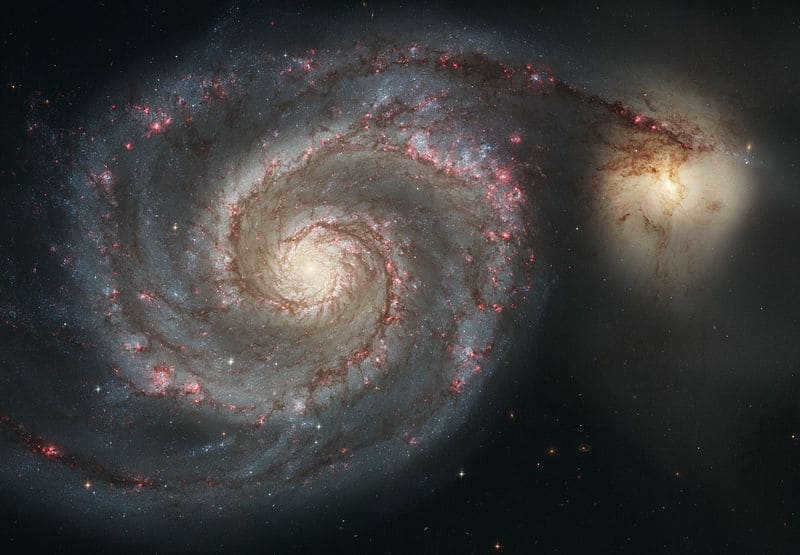
Galaxy M51, also known as the Whirlpool Galaxy, can be found in the Hound Dog constellation and is situated approximately 23 million light-years away from Earth.
This stunning spiral galaxy was first observed by Charles Messier, a French astronomer, in 1774.
Adjacent to M51 is the dwarf galaxy NGC 5195 or M51b.
Both of these galaxies are located in the Hound Dog constellation in the night sky.
The larger of the two galaxies has an estimated diameter of around 76,000 light-years.
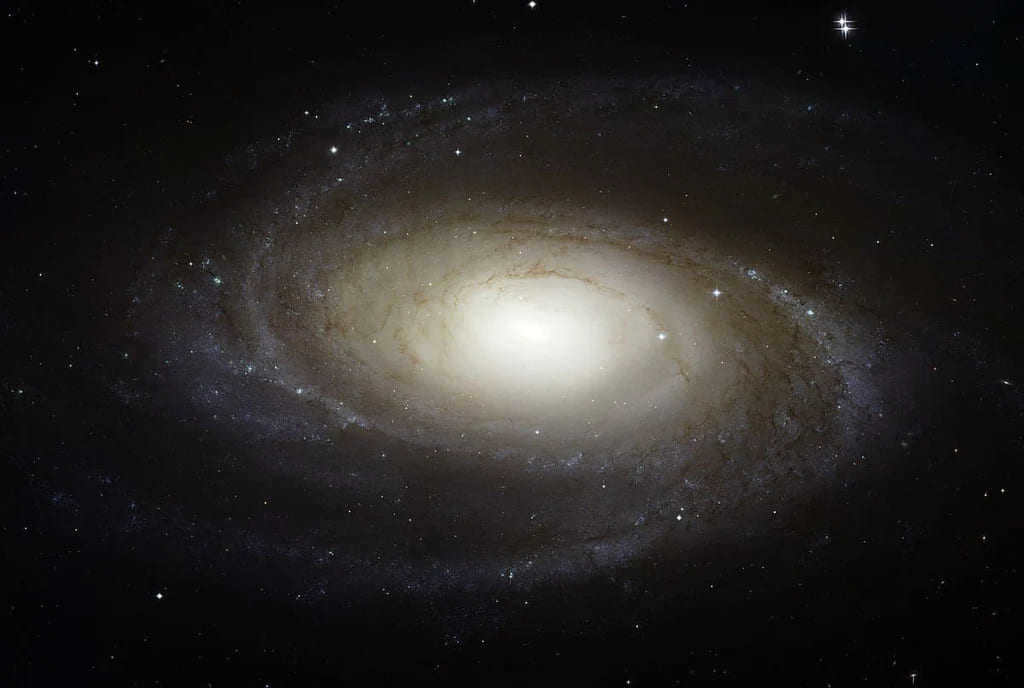
This stunning spiral galaxy was initially observed in 1774 by German astronomer Johann Ehlert Bode. However, it has been included in Messier’s catalog since its rediscovery in 1780 by Pierre Méchain, an assistant to French astronomer Charles Messier.
The galaxy is relatively compact, measuring approximately 87,000 light-years in diameter, which is slightly more than half the size of our own Milky Way.
Situated around 12 million light-years away from Earth in the night sky, it resides within the constellation of Ursa Major, also known as the Big Dipper.
According to NASA, the center of this galaxy harbors a supermassive black hole with a mass 70 million times greater than that of our Sun.
M82, the spiral galaxy
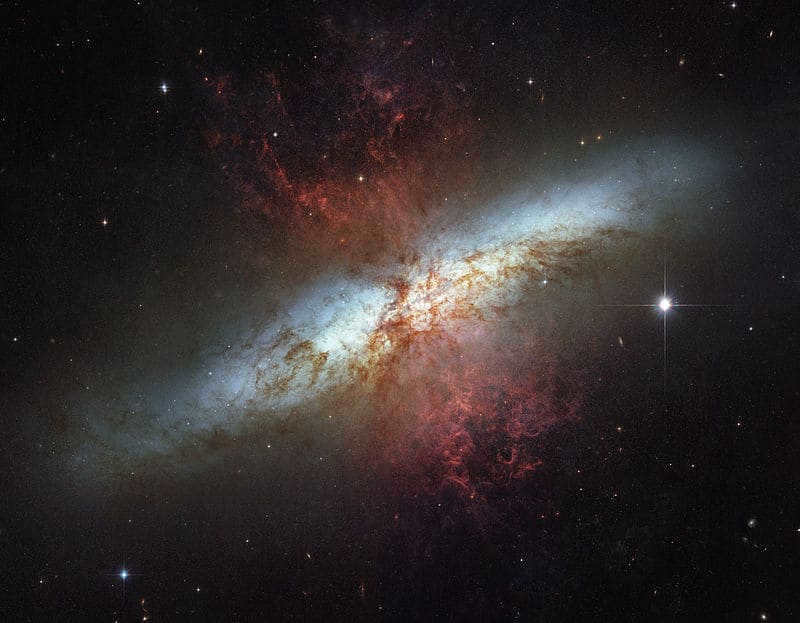
Due to their close proximity, M82 was actually discovered on the same evening as the previous galaxy. With a diameter of 42,000 light-years, it is approximately half the size of M81.
M82, which happens to be M81’s neighboring galaxy, is situated about 13 million light-years away from Earth.
Based on data gathered by the Hubble Space Telescope, it has been determined that the central regions of this particular galaxy are experiencing a high level of star production. In fact, these regions are generating new stars at a rate that is 10 times faster than the Milky Way galaxy.
The striking red glow that can be seen in the image is a clear indication of the presence of hydrogen clouds.
Galaxy M96
can be paraphrased as follows:
Galaxy M96
is the name of a smartphone model.
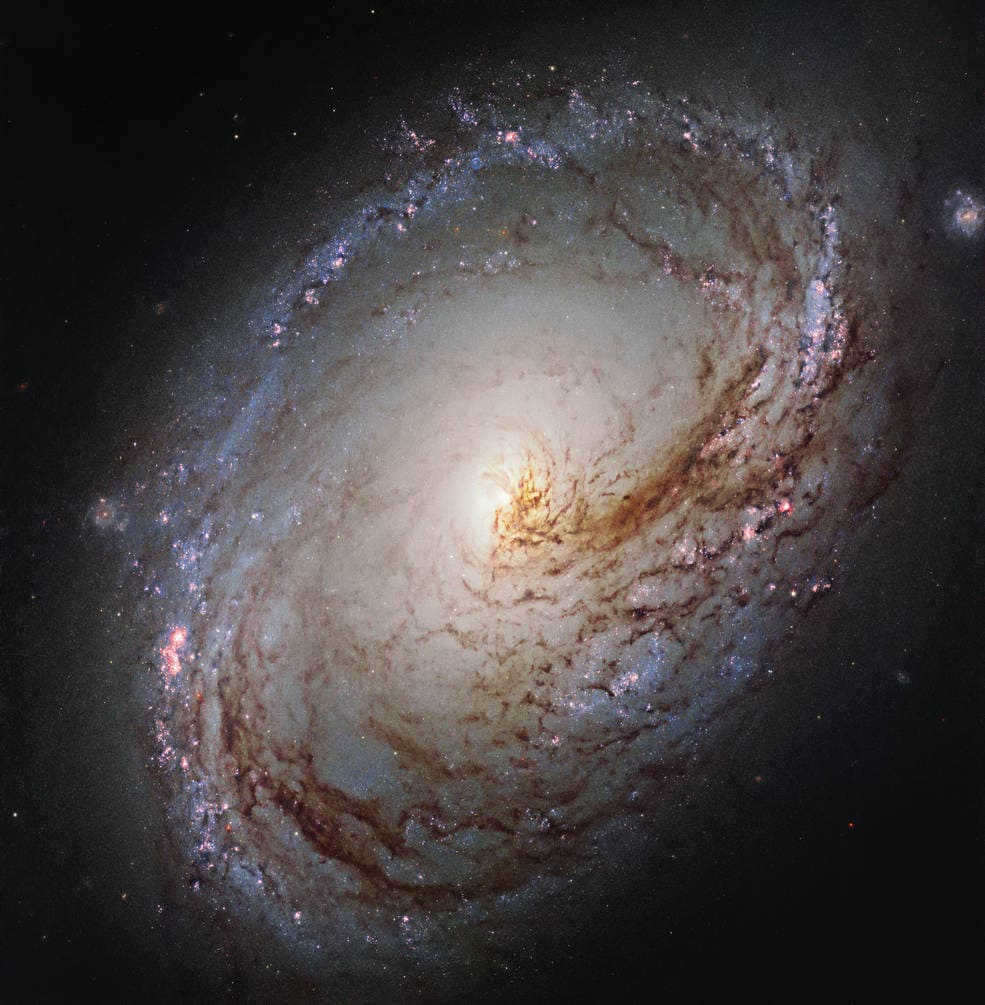
NGC 3368, also referred to as M96, is a spiral galaxy situated approximately 41 million light-years distant from our own galaxy.
It was first identified in 1781 by Pierre Mechene, a French astronomer.
M96 has a diameter of around 93,000 light-years and can be seen in the Leo constellation.
Scientists speculate that a supermassive black hole resides at the core of this galaxy.
The Milky Way Galaxy

Let’s not forget to mention our magnificent abode, the Milky Way. This is the galaxy that birthed us into existence. Scientists estimate that it is approximately 13.5 billion years old, making it quite ancient. (For reference, the age of the universe is about 13.8 billion years).
According to current models, our galaxy falls into the category of spiral galaxies.
It is home to a staggering number of stars, ranging between 100 and 400 billion.
Stretching between 100,000 and 150,000 light years in size, it truly is a cosmic giant.
In a few billion years, a cosmic event will occur when the Andromeda Galaxy and our own galaxy collide. This collision will result in the formation of a single elliptical galaxy.
A table presenting the characteristics of the primary categories of galaxies
| Spheroidal component | Whole galaxy | Yes | Very faint |
| Stellar disk | None or weak | Main component | Main component |
| Gas-dust disk | No | Yes | Yes |
| Spiral branches | No or only near the core | Yes | No |
| Active nuclei | Occur | Occur | No |
| Percentage of total number of galaxies | 20% | 55% | 5% |
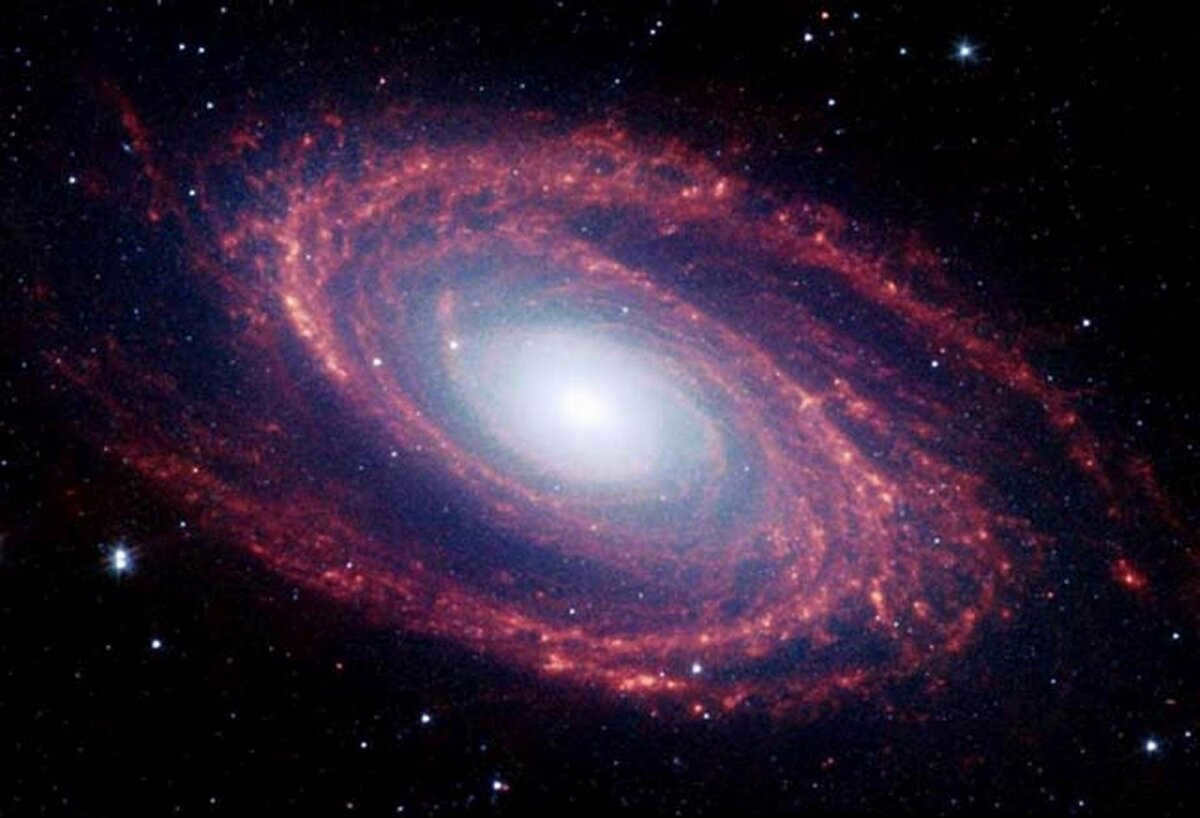
The Milky Way Galaxy
The Milky Way galaxy, which includes our solar system, is home to billions of stars, with the Sun being the closest one to us. When gazing at the night sky filled with stars, it is impossible to miss the vast expanse of stars. This collection of stars was referred to as the Galaxy by the ancient Greeks.
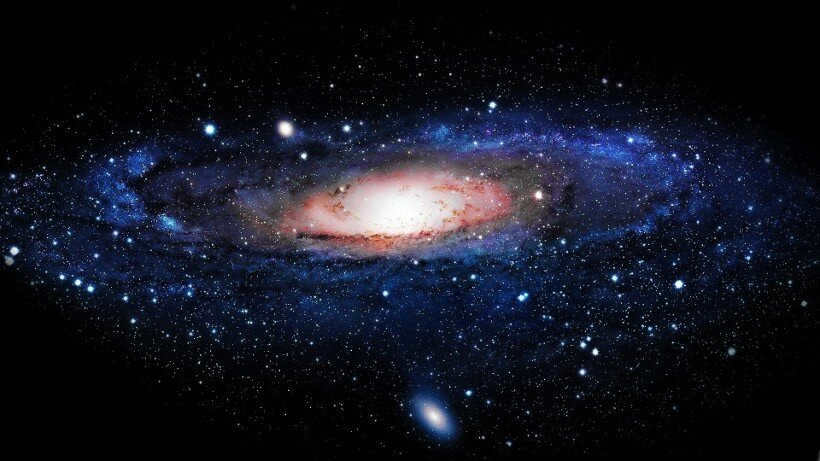
If we were given the chance to observe this stellar system from an external perspective, we would witness a flattened mass of over 150 billion stars. The vastness of our galaxy is incomprehensible to the human mind. It would take a beam of light a hundred thousand Earth years to travel from one side to the other! The central region of our galaxy serves as the core, from which extend enormous spiral arms teeming with stars. The distance between the Sun and the Galactic core spans 30,000 light years. The solar system resides at the outer reaches of the Milky Way.
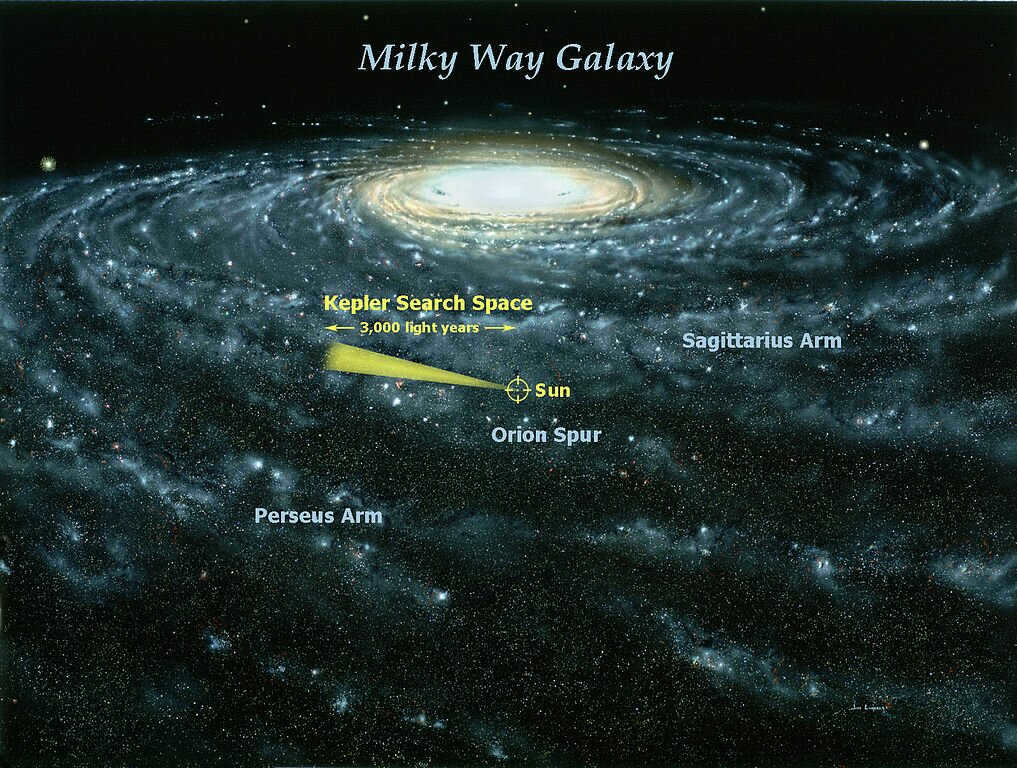
Stars are not evenly distributed throughout the galaxy. Despite the vast number of celestial bodies in the universe, stars are actually quite rare. The distance between the closest stars is tens of millions of times greater than their own diameters. This means that stars are not randomly scattered in the universe, but rather their positions are influenced by gravitational forces that keep them in a specific plane. These star systems, along with their gravitational fields, are known as galaxies. In addition to stars, galaxies also contain gas and interstellar dust, making up their composition.
The components of galaxies.
There are numerous other galaxies that compose the entirety of the universe. The galaxies nearest to us are situated at a distance of 150 thousand light years away. These galaxies can be observed in the sky of the southern hemisphere as small, hazy spots. Initially documented by Pigafett, a participant of the Magellanic expedition that circumnavigated the globe, these celestial bodies are scientifically recognized as the Large and Small Magellanic Clouds.
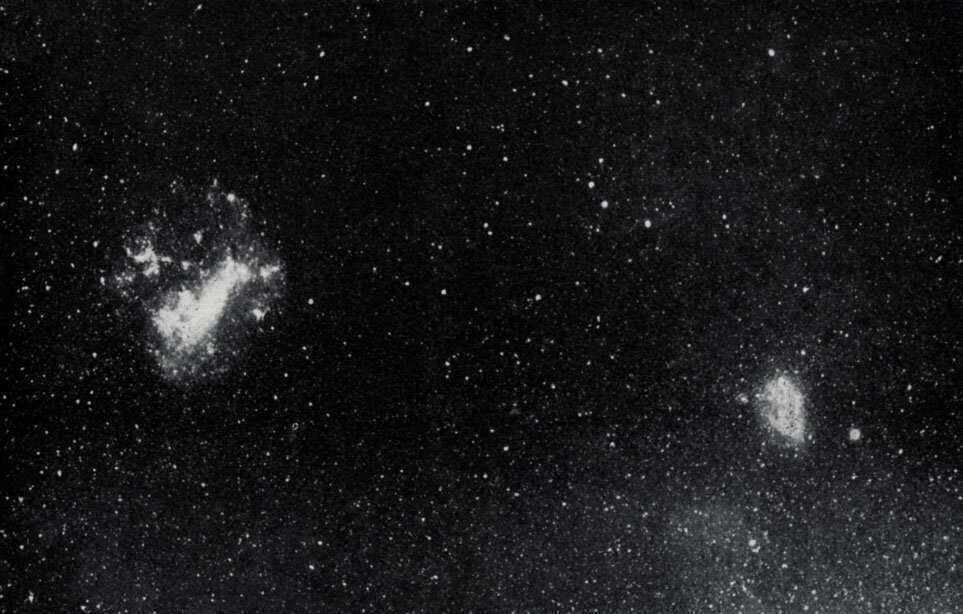
One of the galaxies that is nearest to our own is known as the Andromeda Nebula. It possesses an immense size, making it observable from the Earth using regular binoculars, and under clear conditions – even with the unaided eye.
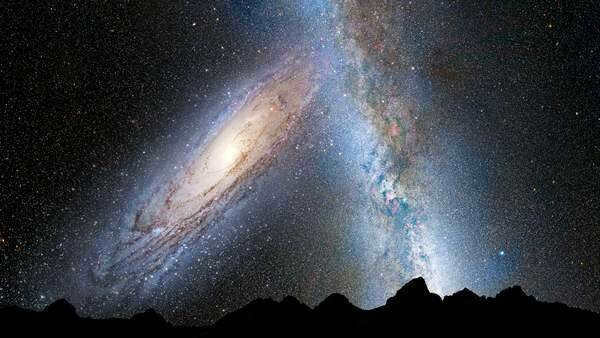
The galaxy is shaped like a massive spiral winding through space. Positioned on one of the winding arms, about three-quarters of the way from the center, lies the Solar System. Every object within the galaxy orbits around a central core and is influenced by its gravitational pull. Back in 1962, astronomer Edwin Hubble categorized galaxies based on their form. He classified them into four types: elliptical, spiral, irregular, and leaping galaxies.

Within the portion of the cosmos available for astronomical investigation, there exist billions of galaxies. Astronomers collectively refer to them as the Metagalaxy.
Galactic Structures of the Cosmos
Galactic structures are vast assemblages of stars, gas, and dust that remain conjoined through the forces of gravity. They can exhibit a wide range of shapes and sizes. The majority of celestial bodies are affiliated with some form of galactic structure. This includes entities such as black holes, asteroids, stars accompanied by their own satellites and planets, nebulae, and neutron satellites.
Most galaxies in the Universe contain vast amounts of imperceptible dark energy. Because the void between the various galaxies is considered empty, they are often referred to as oases in the expanse of space. For instance, the Milky Way galaxy, where our solar system resides, is home to billions of stars, including one called the Sun. The solar system is positioned about three-fourths of the way from the center of this spiral galaxy. Within this galaxy, everything is in constant motion around a central nucleus, which is influenced by its own gravity. However, the nucleus itself also moves along with the galaxy. Furthermore, all galaxies are moving at extremely high speeds.
In 1962, astronomer Edwin Hubble made a logical categorization of the galaxies in the Universe based on their shape. Nowadays, galaxies are classified into four main groups: elliptical, spiral, barred (lenticular) galaxies, and irregular galaxies.
What is the largest galaxy in our Universe?
The largest galaxy in the Universe is a lenticular galaxy of immense size situated in the Abell 2029 cluster.
Spiral galaxies: A Unique Cosmic Phenomenon

There exist galaxies that exhibit the form of a planar spiral disk with a luminous core (nucleus). Our Milky Way galaxy is a representative example of a spiral galaxy. These types of galaxies are often labeled with the letter S and can be further categorized into four subgroups: Sa, So, Sc, and Sb. Galaxies belonging to the Sao subgroup possess nuclei that have a light hue and lack spiral arms. On the other hand, Sa galaxies are characterized by tightly coiled spiral arms encircling a central nucleus. The spiral arms of Sc and Sb galaxies, in contrast, seldom encompass the nucleus.
Spiral galaxies from the Messier catalog
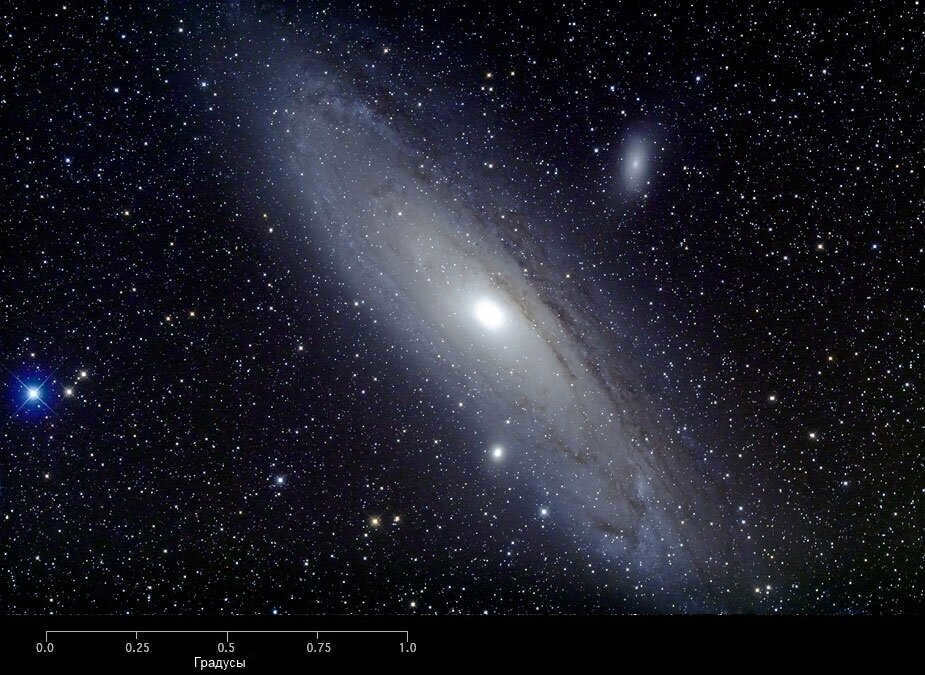
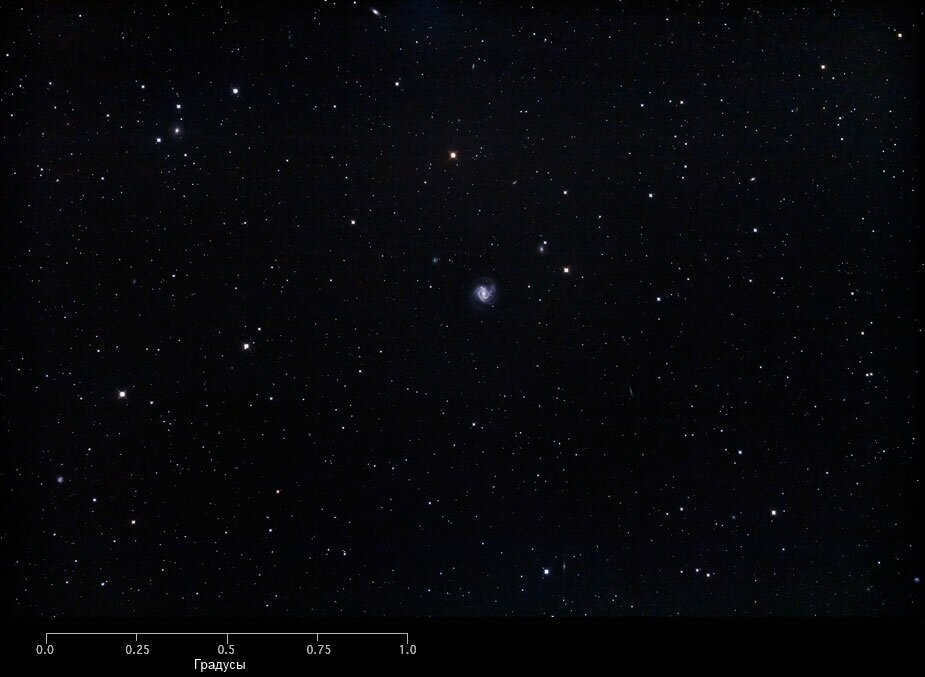
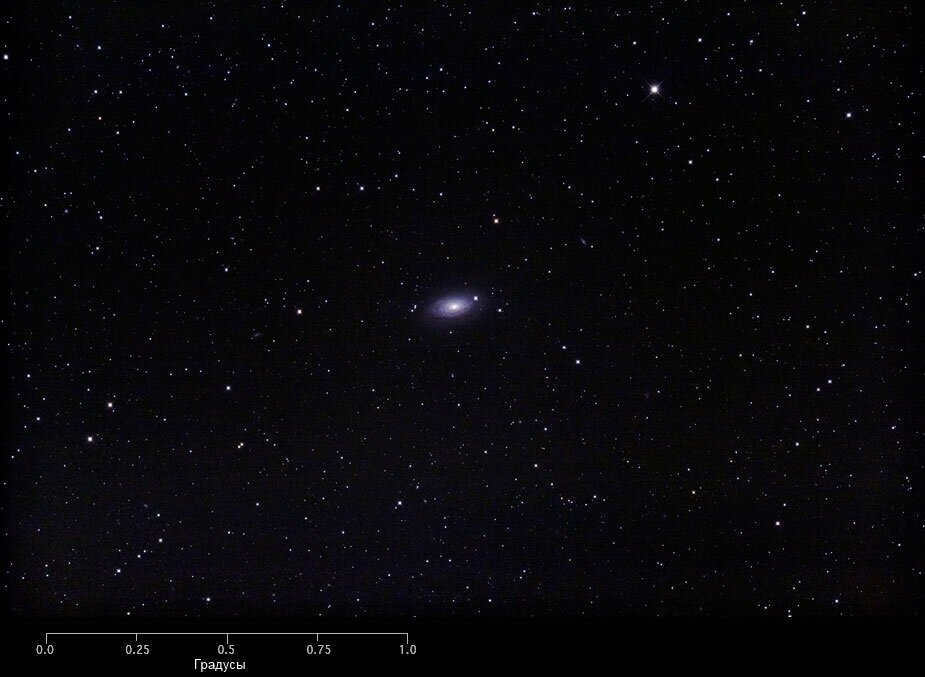
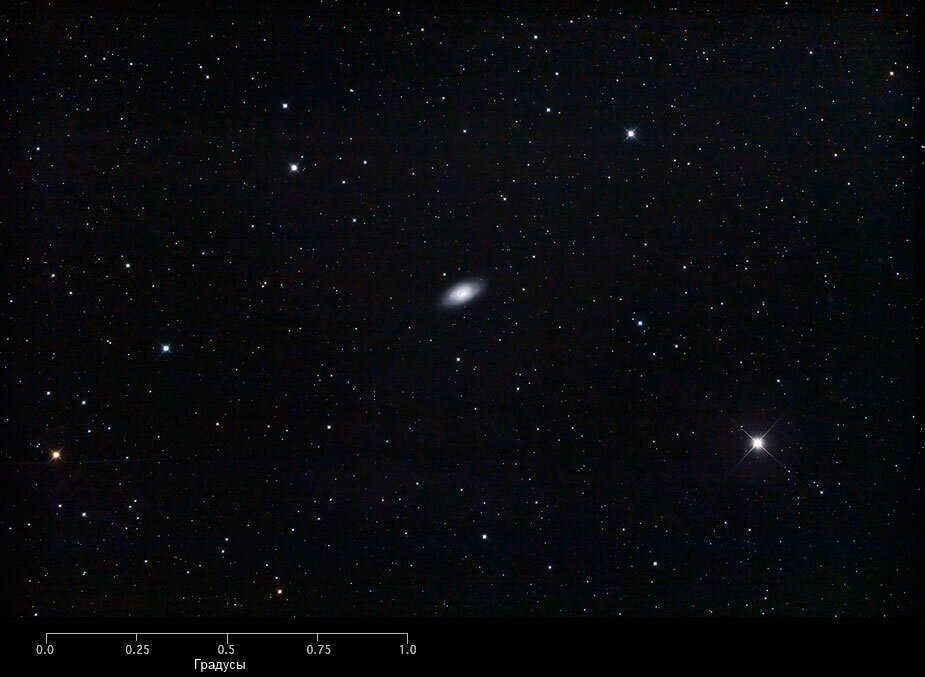
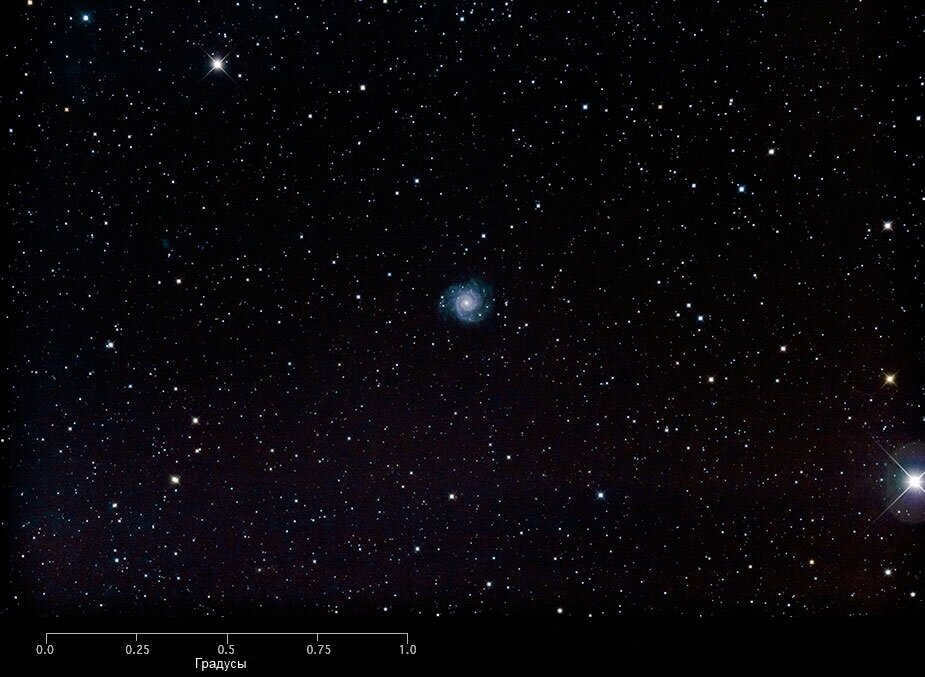
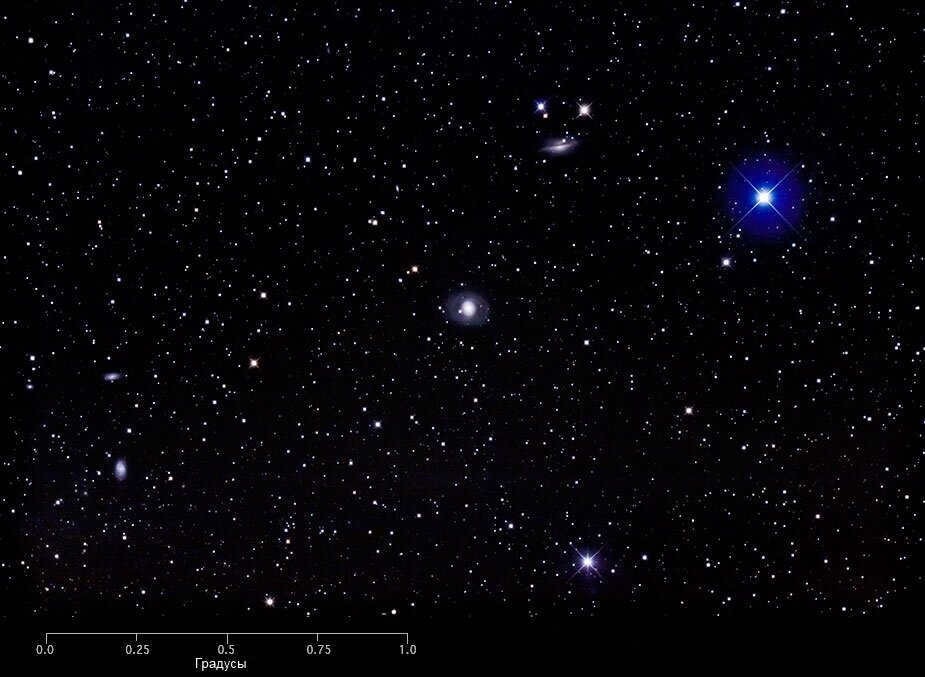
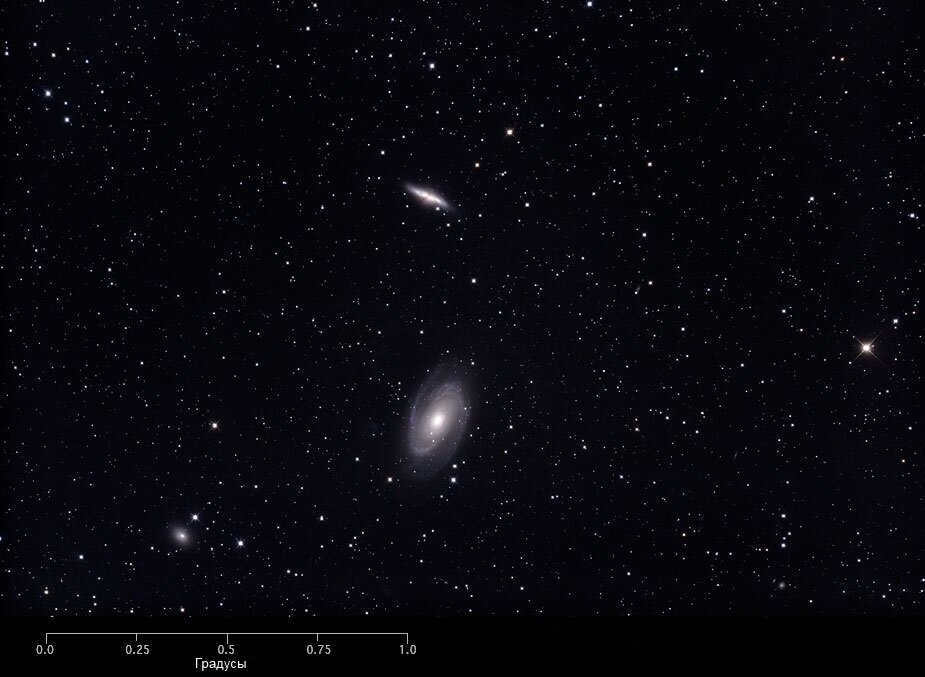

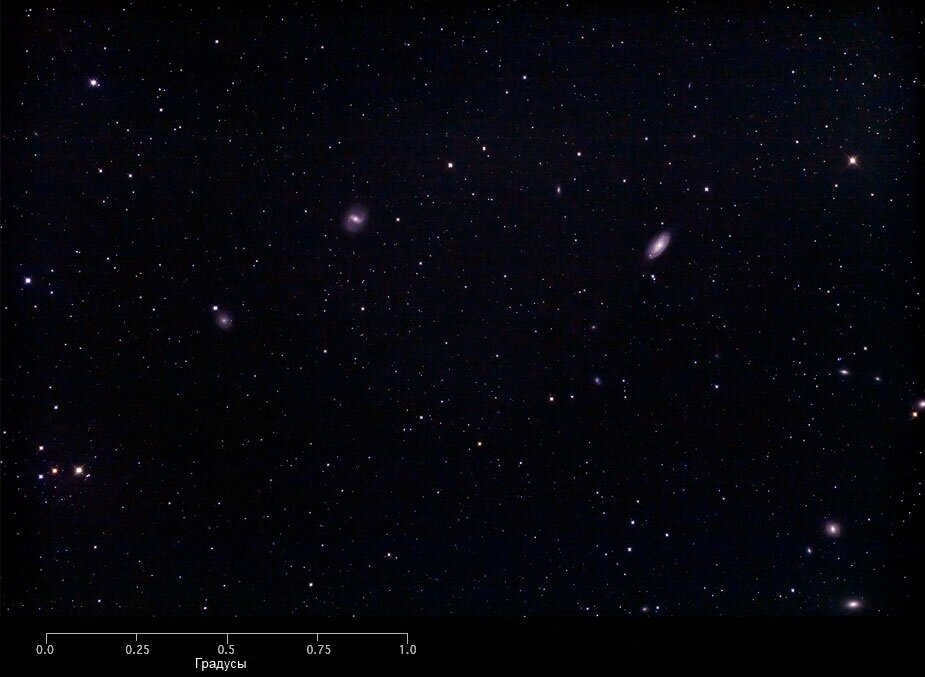
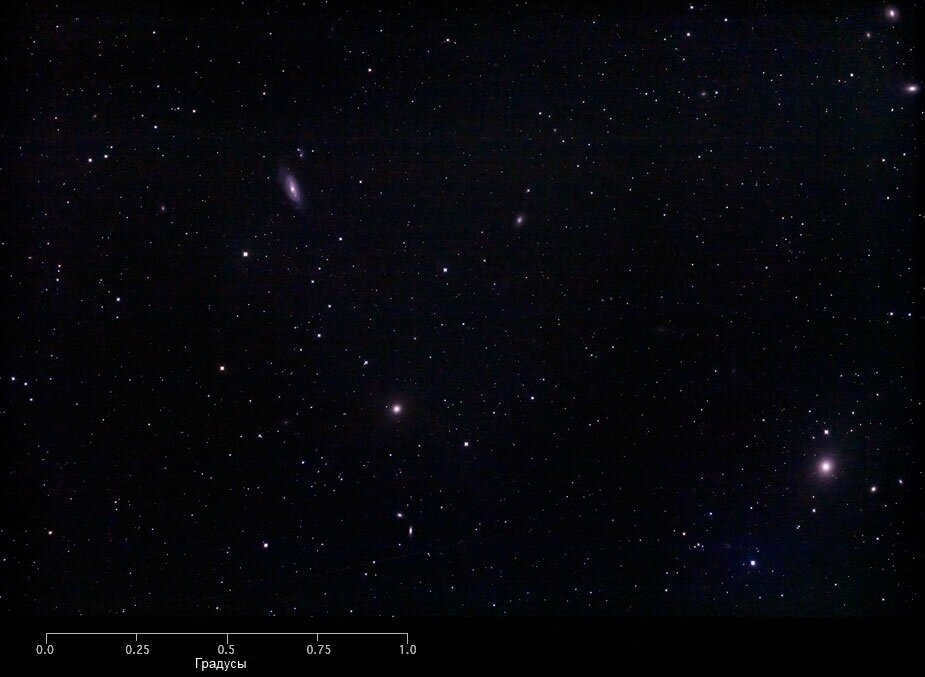
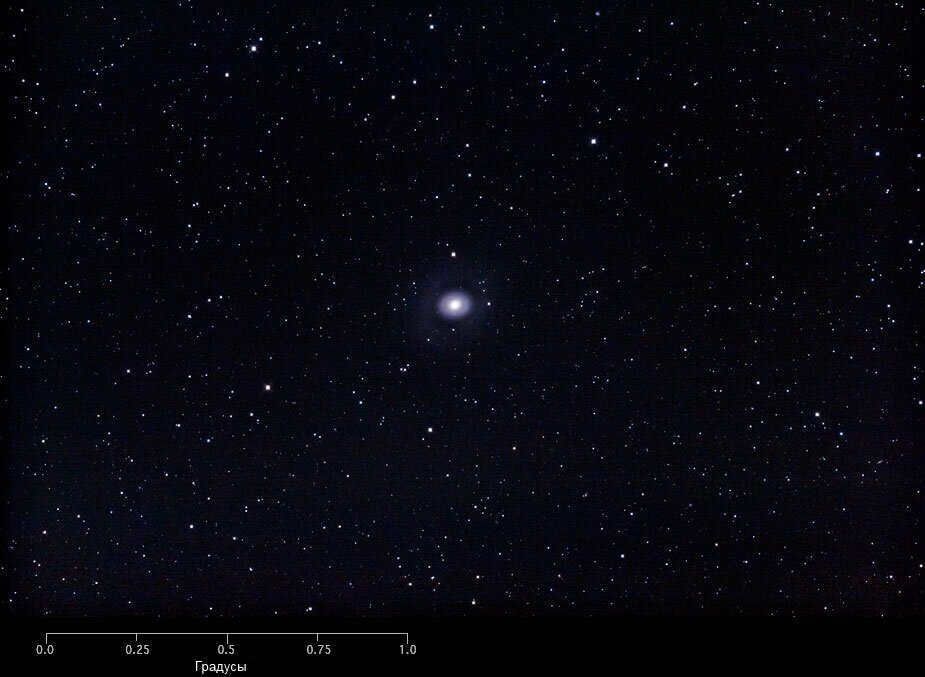

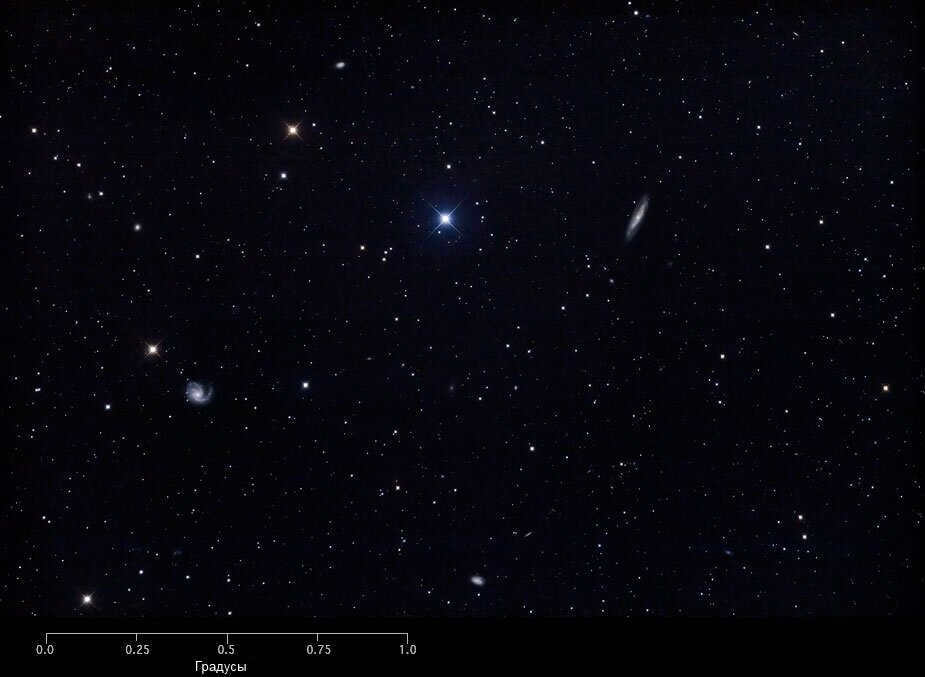
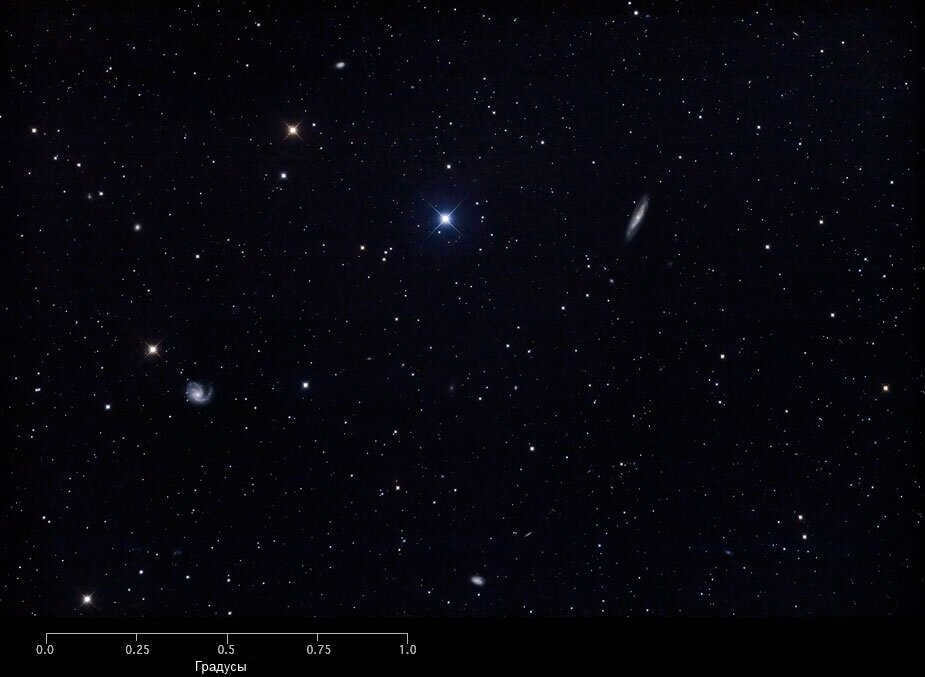
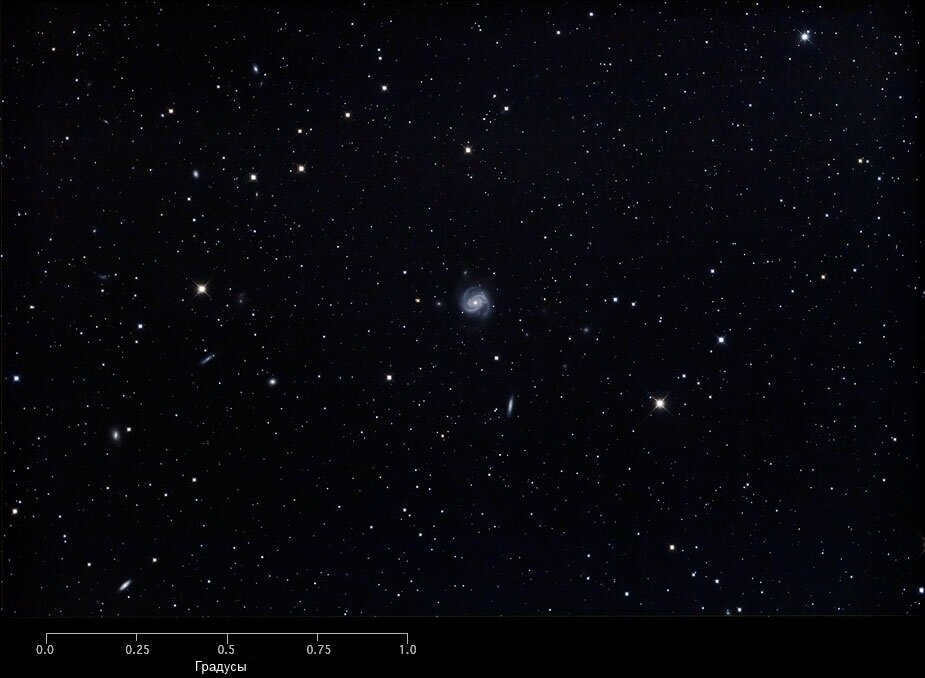
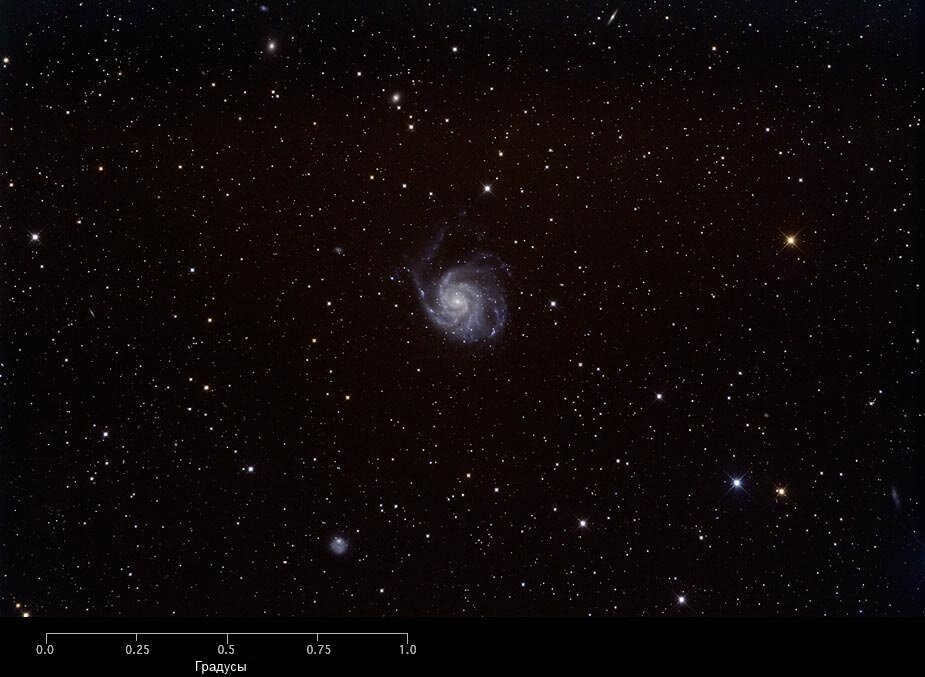
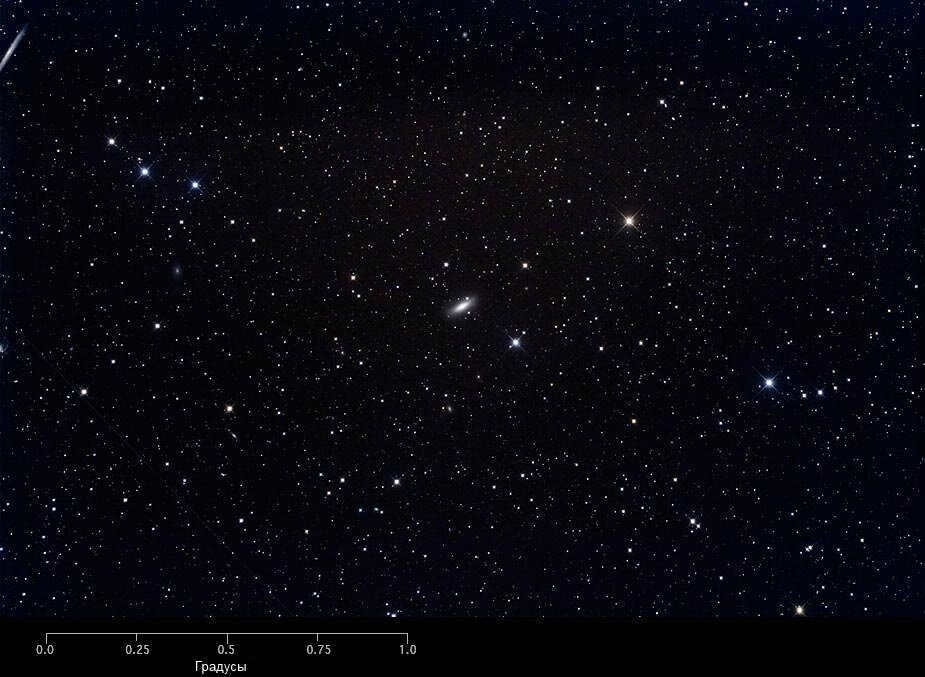
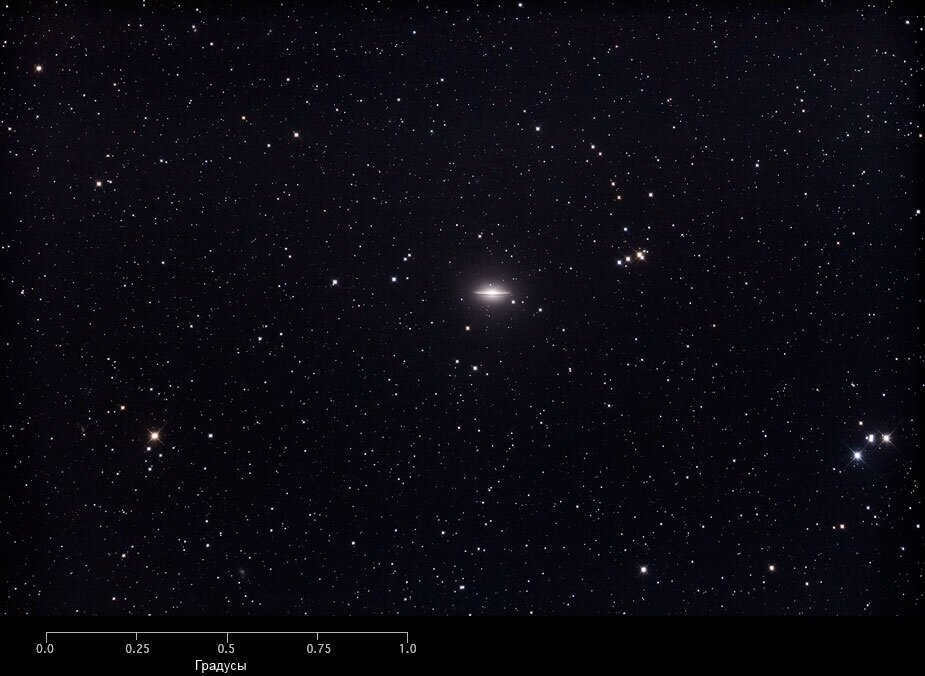

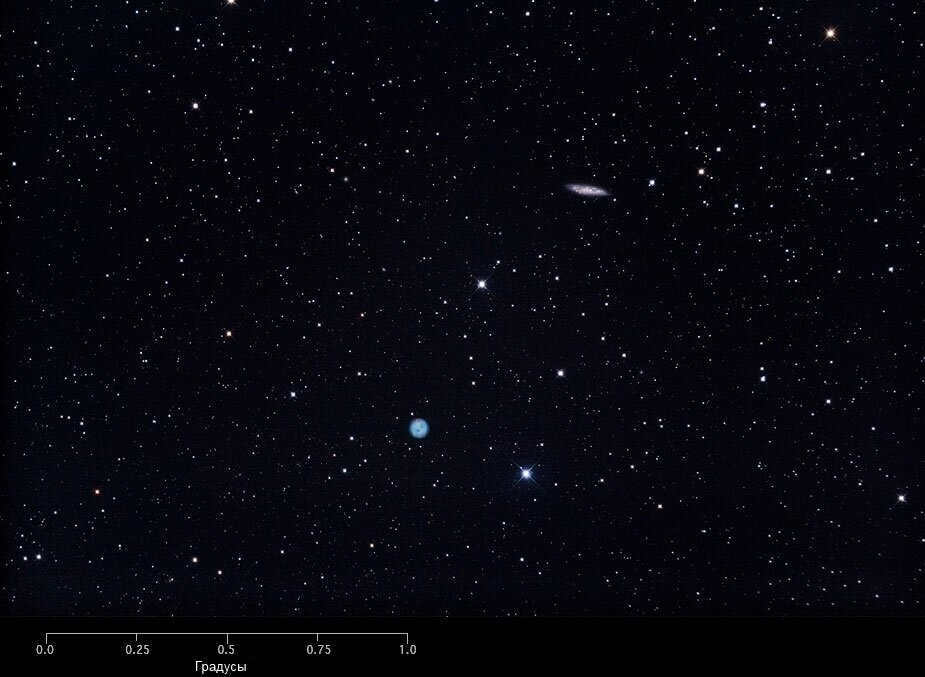
Galactic Structures Featuring a Bar
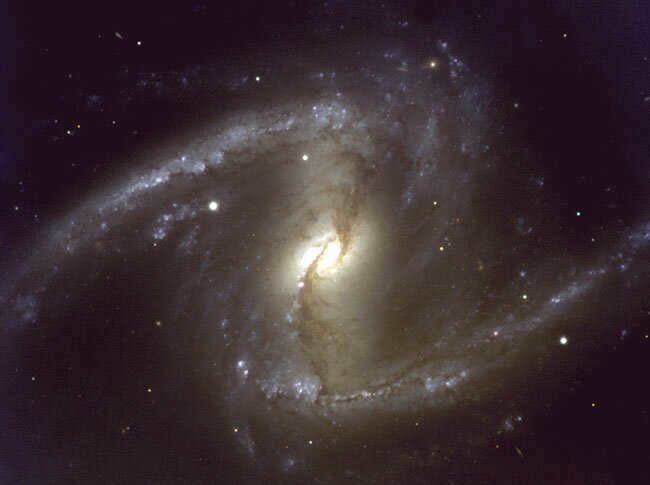
Barred (jumper) galaxies resemble spiral galaxies, but they have one distinguishing feature. Instead of the spirals originating from the nucleus, they start from the junctions. This category encompasses approximately one-third of all galaxies and is typically denoted by the letters SB. Furthermore, they can be further divided into three subgroups: Sbc, SBb, and SBa. The variation among these groups is defined by the shape and length of the jumpers, which mark the actual starting points of the spiral arms.
Spiral galaxies featuring the Messier catalog jumper
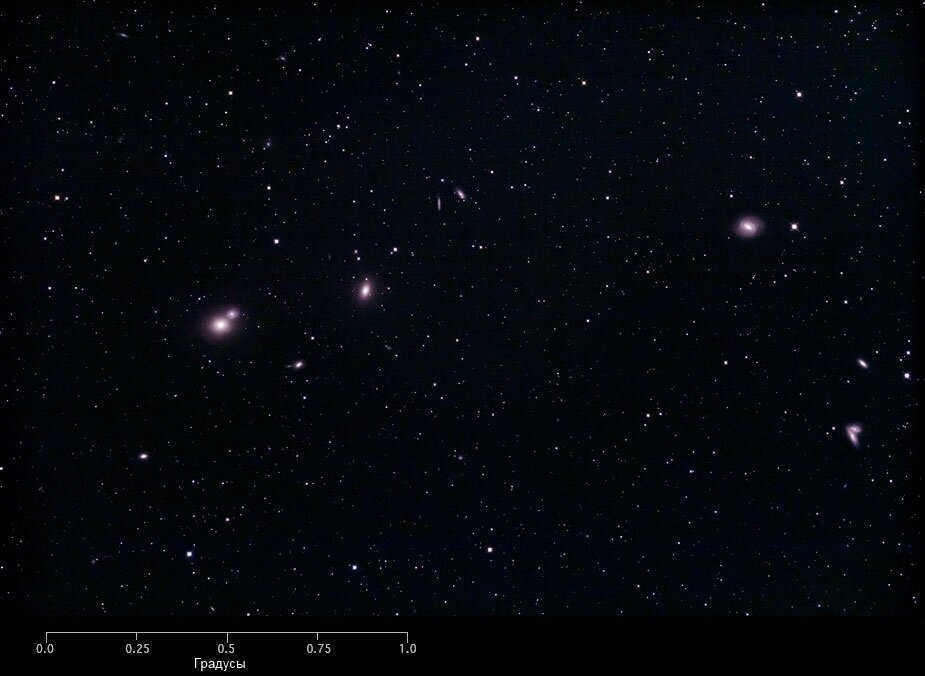
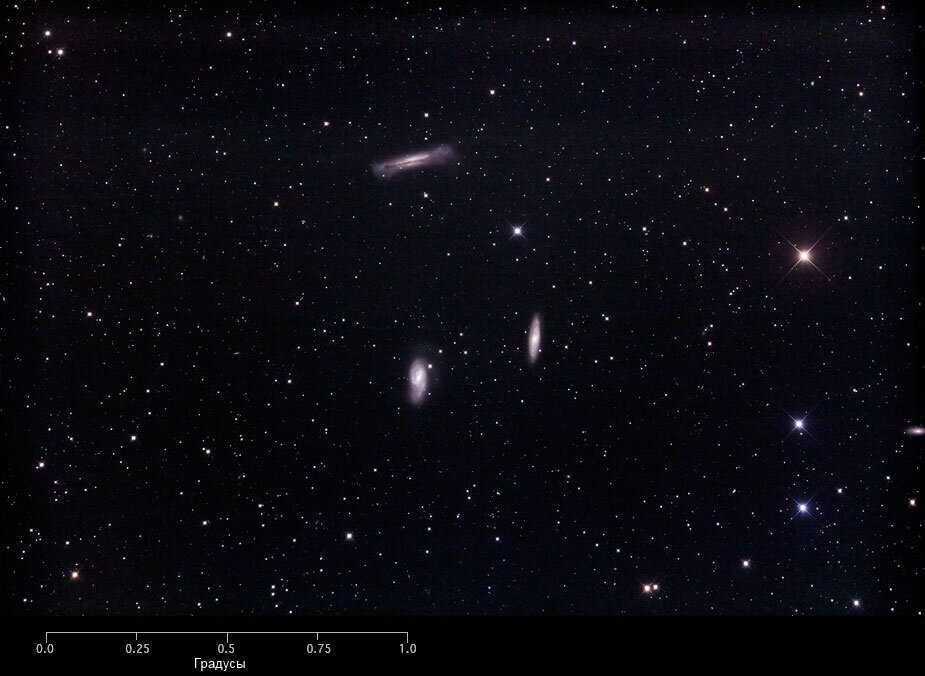
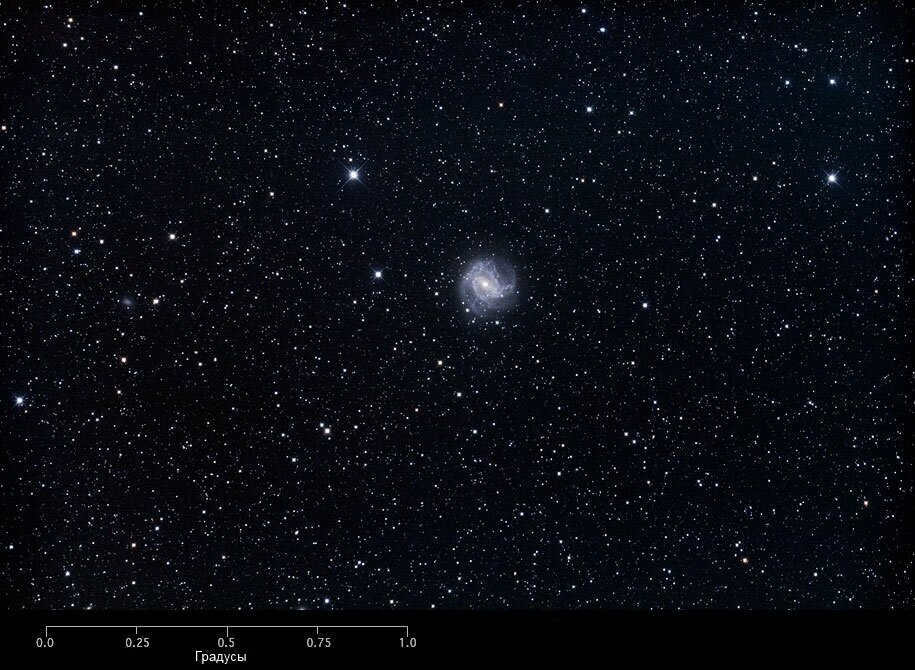
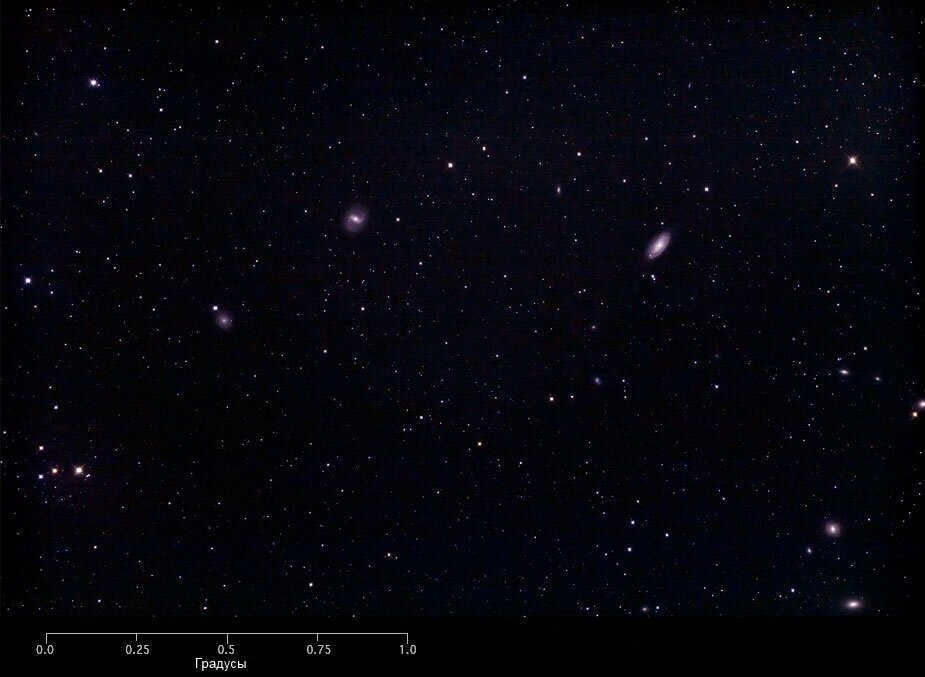
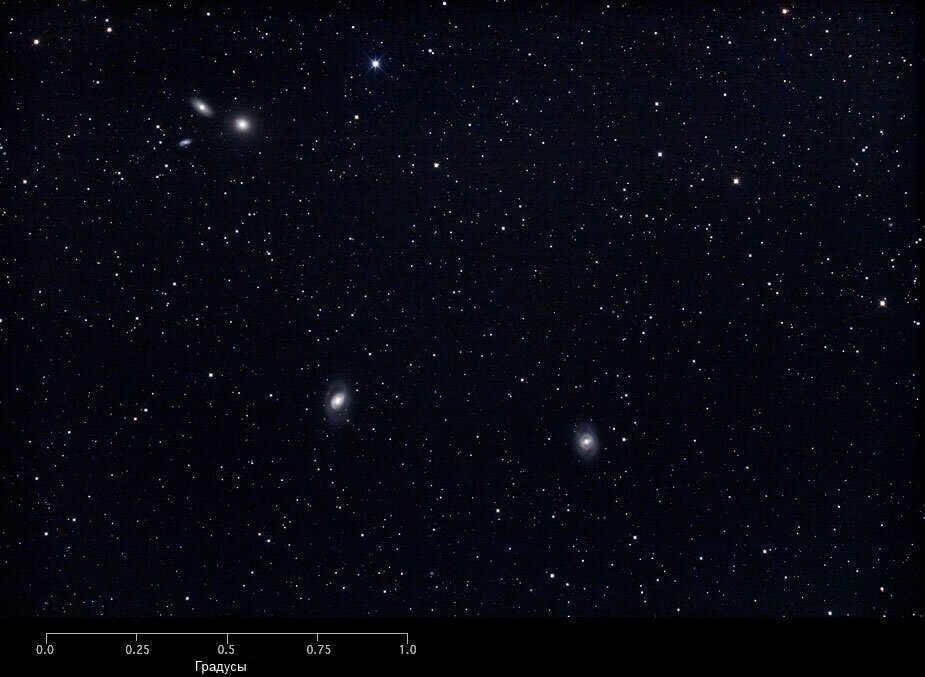
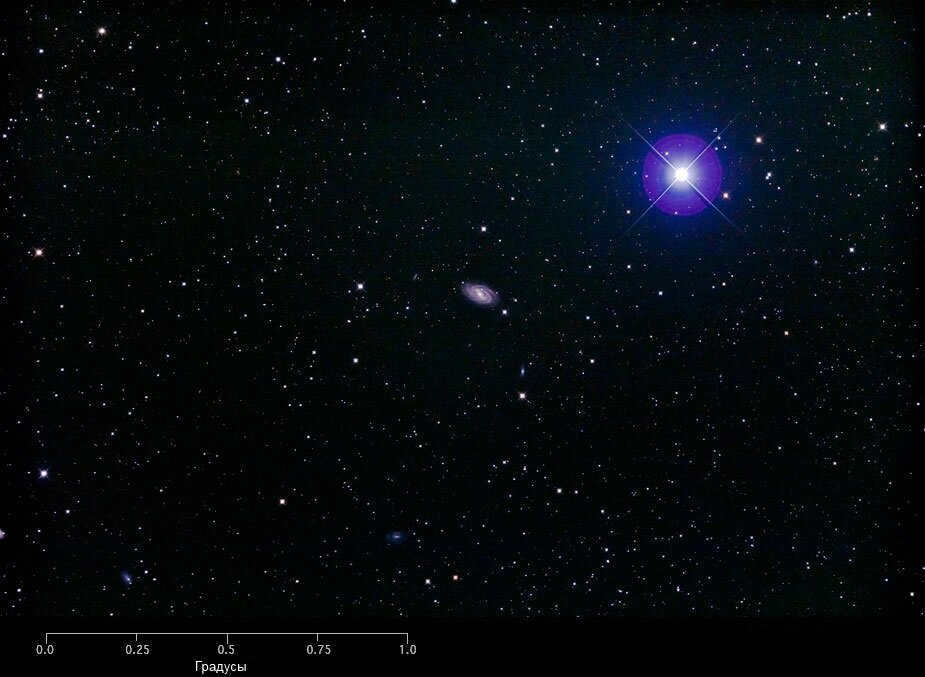
Elliptical galaxies
can be rephrased as
Elliptical galactic formations
.
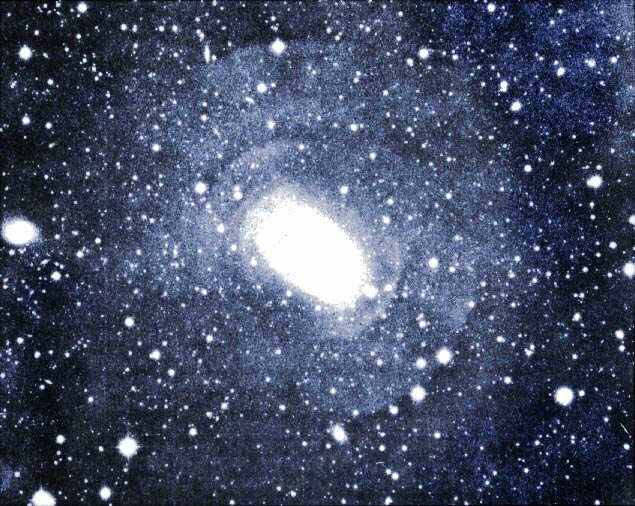
Galaxies come in a range of shapes, ranging from perfectly spherical to elongated ovals. What sets them apart is the lack of a bright central core. They are designated by the letter E and are categorized into 6 subgroups based on their shape. These shapes are identified as E0 to E7. The E0 galaxies have a nearly circular shape, while the E7 galaxies have an incredibly elongated form.
Elliptical galaxies in the Messier catalog

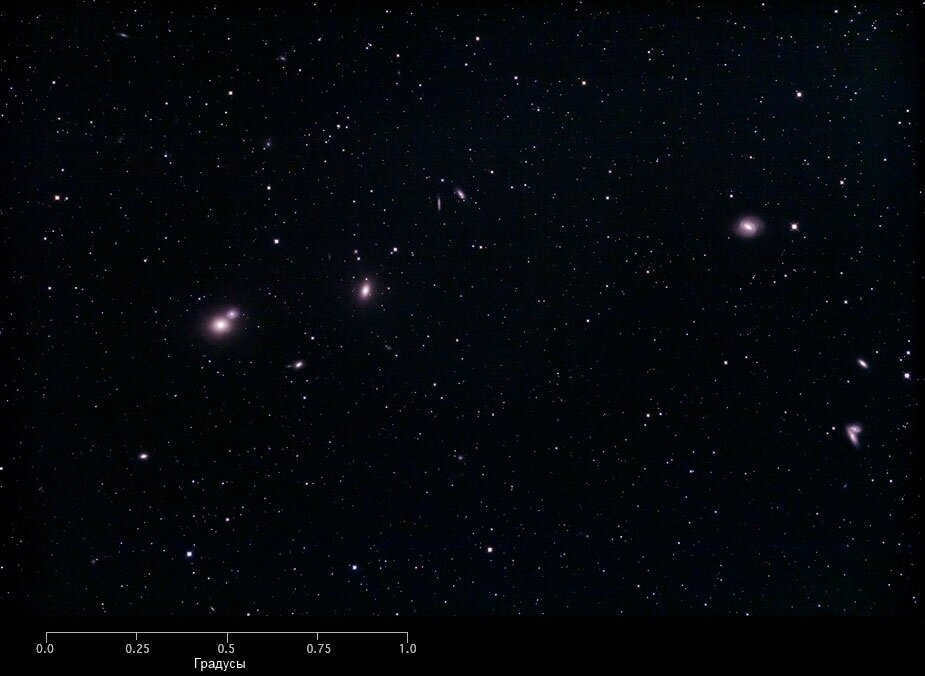

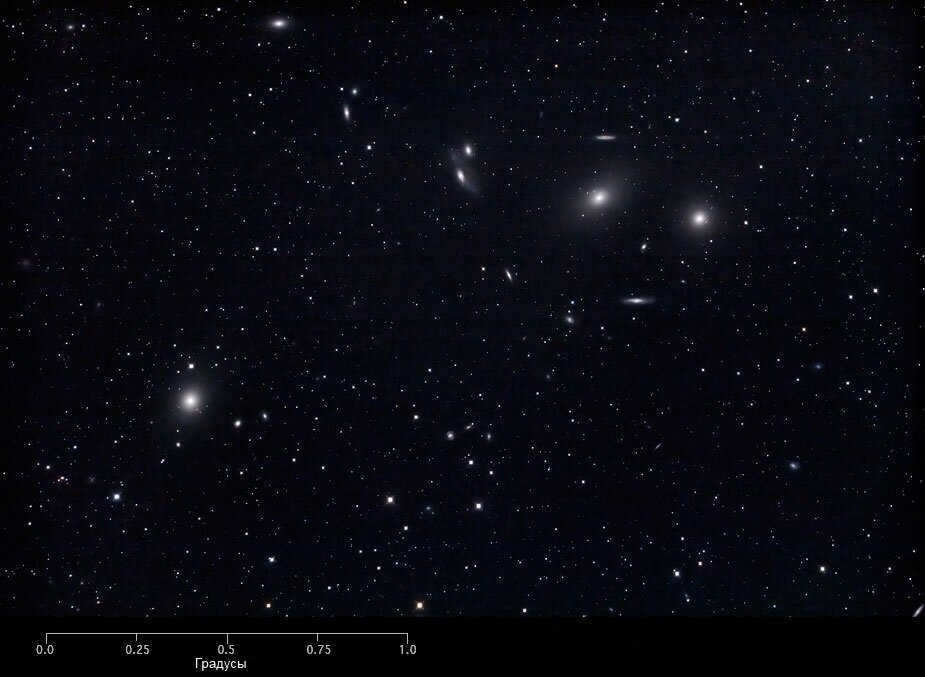
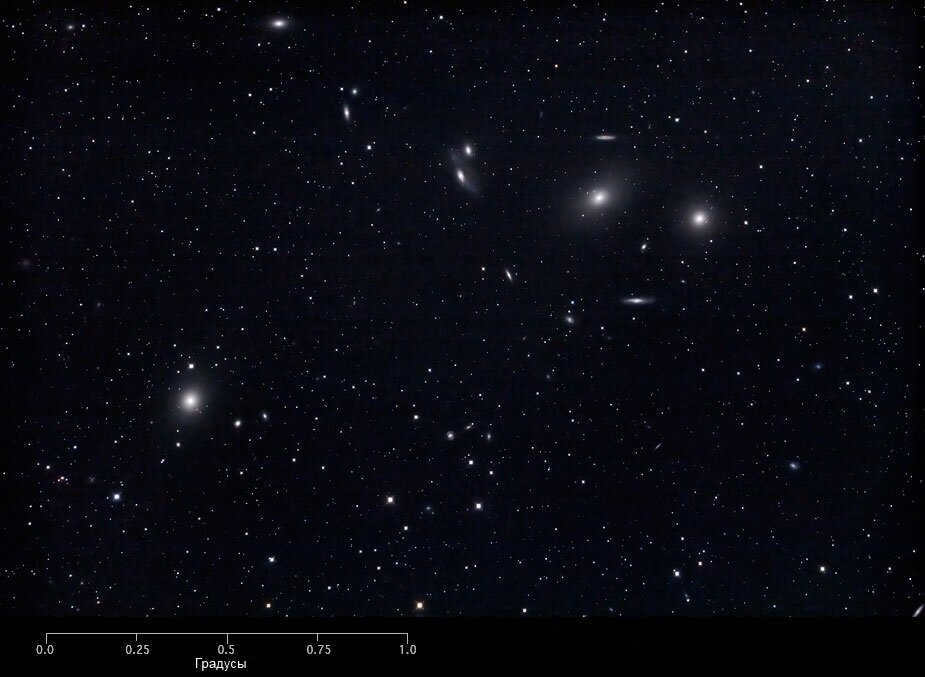
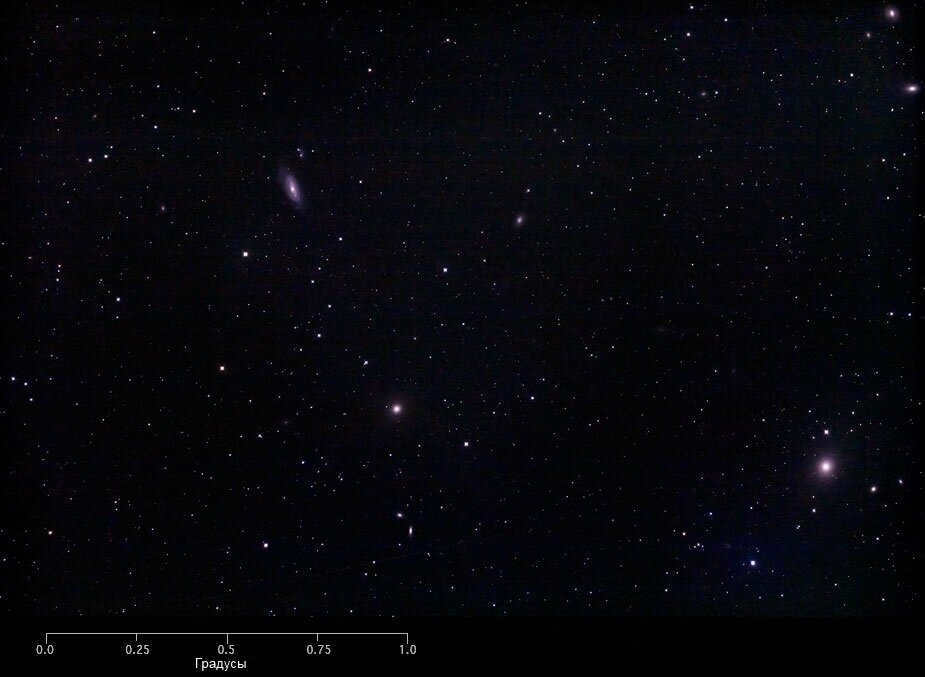
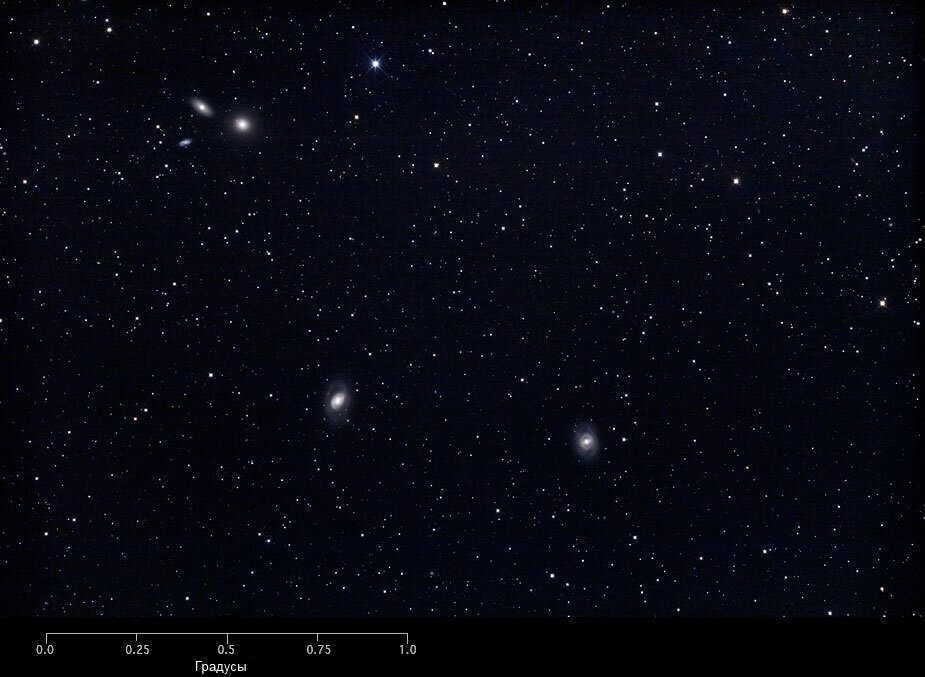
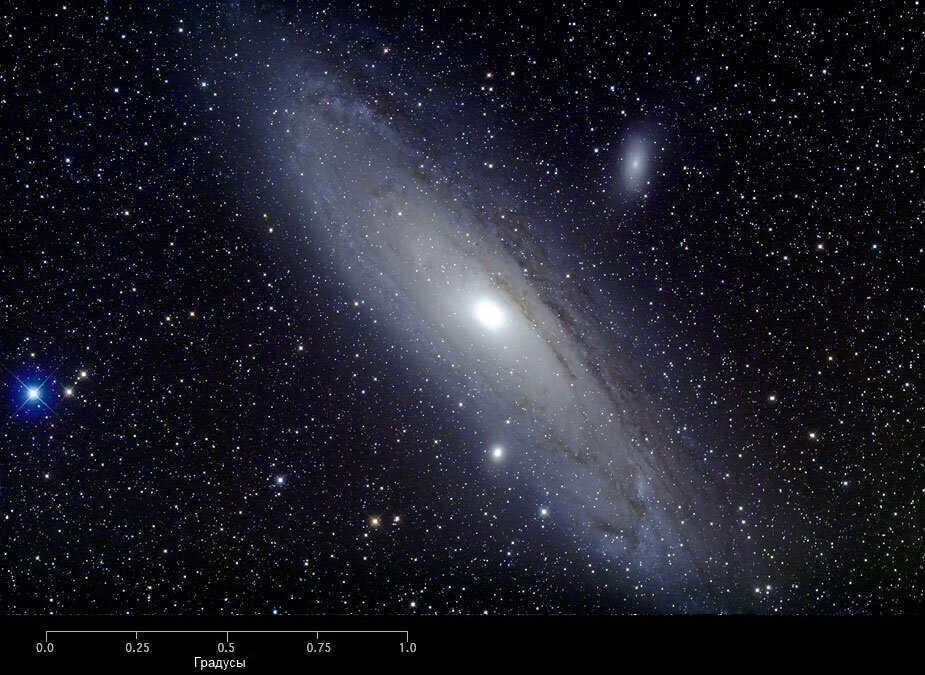
Irregular galaxies
Irregular galaxies are a type of galaxy that do not have a defined shape or structure. They are often characterized by their chaotic and disorganized appearance. Irregular galaxies can vary greatly in size and can be found in various regions of the universe. These galaxies are believed to have formed through different processes, such as interactions with other galaxies or the result of gravitational disturbances. Despite their irregular shape, these galaxies can still contain a significant amount of stars and other celestial objects. Scientists continue to study irregular galaxies in order to better understand their formation and evolution.
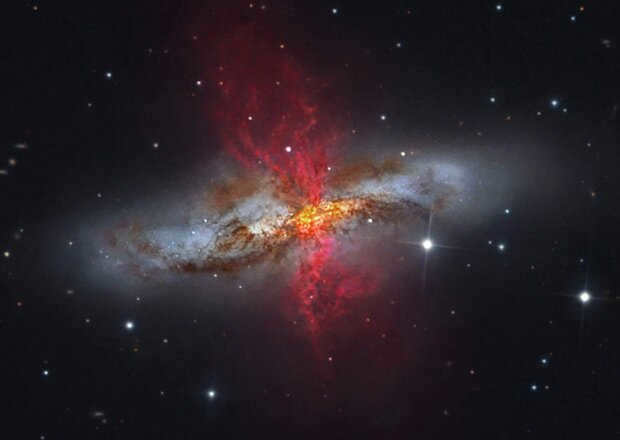
Irregular galaxies lack a specific structure or form. They can be categorized into two classes: IO and Im. Im galaxies are the most prevalent and have a minimal hint of structure. In certain instances, remnants of spirals can be observed. IO galaxies, on the other hand, are characterized by their chaotic shape. The Small and Large Magellanic Clouds serve as a notable example of the Im class.
The Messier catalog’s irregular galaxies

Table comparing the characteristics of different types of galaxies
| Elliptical galaxy | Spiral galaxy | Irregular galaxy | |
| Spheroidal shape | No spiral arms | Very faint | |
| No stellar disk | Weak or no stellar disk | Main component | |
| No gas-dust disk | Yes | Yes | |
| No or only near the core | Yes | No | |
| Active nuclei | Present | Present | None |
| Percentage of total number of galaxies | 20% | 55% | 5% |
Recently, a team of astronomers embarked on a joint venture aimed at uncovering the precise whereabouts of galaxies across the vast expanse of the Universe. Their ultimate objective is to gain a more intricate understanding of the overall structure and configuration of the Universe on a grand scale. Regrettably, comprehending the sheer enormity of the Universe proves challenging for many individuals. Consider, for instance, our own galaxy, which encompasses over a hundred billion stars. To add to that, there exist billions upon billions of galaxies in the Universe. While astronomers have managed to identify galaxies situated at great distances, the light we perceive from them actually originated nearly 9 billion years ago (such is the immense span that separates us).
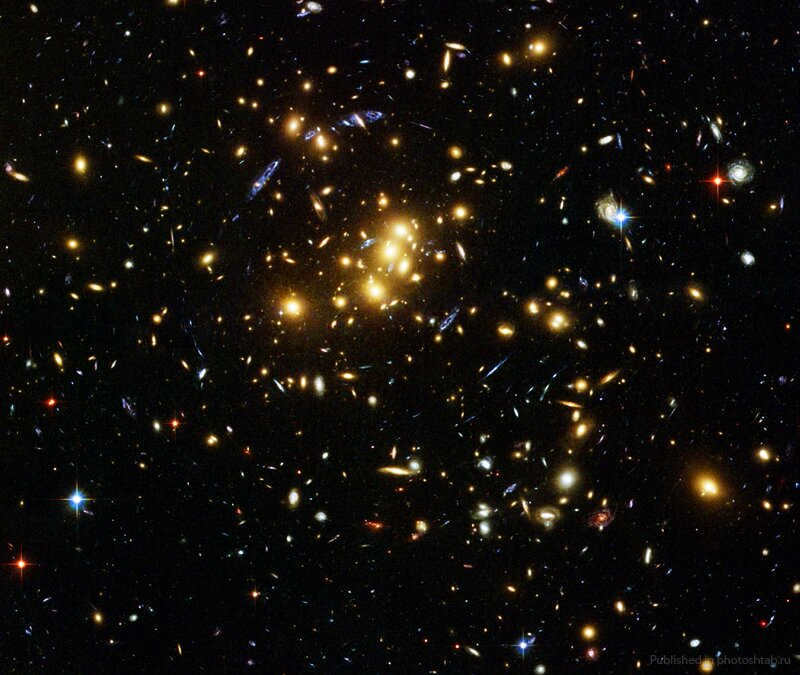
Scientists have acquired knowledge that the majority of galaxies are members of a specific assemblage (known as a “cluster”). The Milky Way is among the members of a cluster, which comprises forty identified galaxies. In general, these clusters are often part of an even more extensive collection called superclusters.
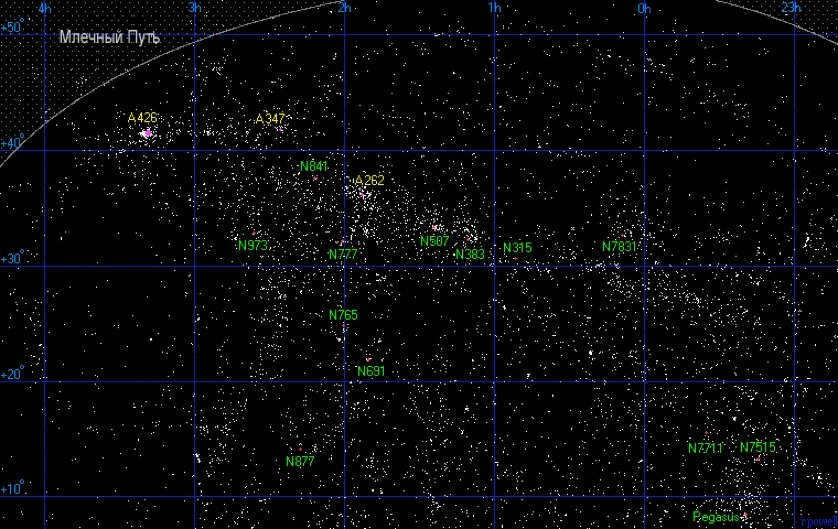
The Virgo cluster, to which our cluster belongs, is known as a supercluster. This enormous cluster is comprised of over 2,000 galaxies. When astronomers mapped out the positions of these galaxies, they noticed that the superclusters formed distinct shapes. The larger superclusters seemed to gather around what appeared to be enormous bubbles or voids. The exact nature of these structures remains a mystery. Scientists are unsure of what could be inside these voids. One hypothesis suggests that they could contain unknown dark matter, while another suggests that they may simply be empty space. It will likely take a significant amount of time before we can fully understand the nature of these voids.
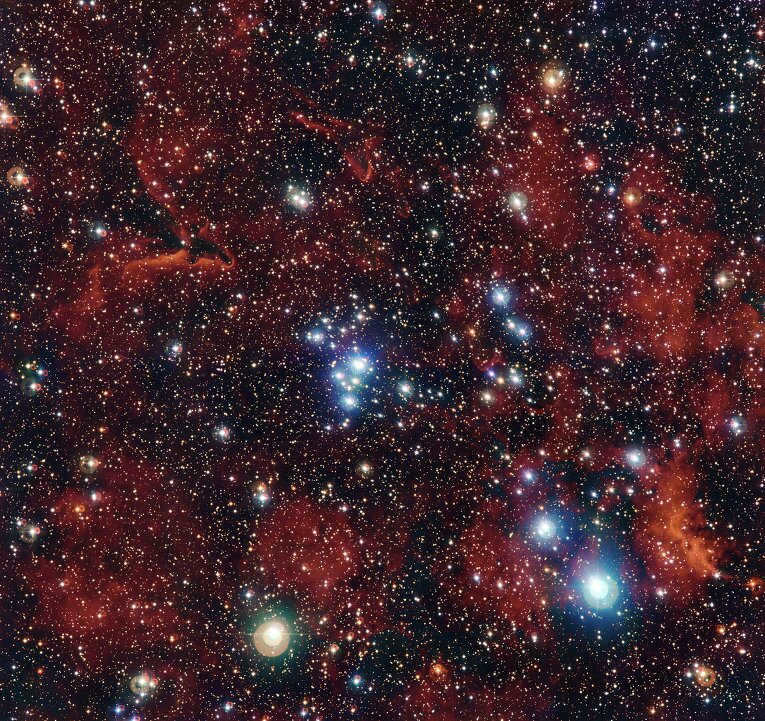
Galactic computation
Edwin Hubble is credited with pioneering galactic investigation. He was the first to devise a method for accurately calculating the distance to a galaxy. His inquiry relied on the utilization of pulsating stars, commonly known as Cepheids. By observing the relationship between the duration of a single brightness pulsation and the energy emitted by the star, Hubble was able to derive precise measurements. These findings represented a significant advancement in the realm of galactic research. Additionally, Hubble discovered a correlation between the red spectrum emitted by a galaxy and its distance, which came to be known as the Hubble constant.
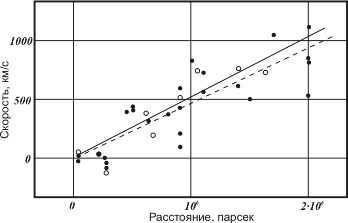
Currently, astronomers have the ability to calculate the distances and speeds of galaxies by examining the degree of redshift in their spectra. It is a universal fact that all galaxies are in a state of continuous movement away from one another. The velocity of a galaxy’s motion increases proportionally with its distance from Earth.

We have recently acquired advanced tools to assist scientists in their quest to discover undiscovered galaxies. Thanks to the remarkable capabilities of the Hubble Space Telescope, scientists are now able to observe phenomena that were once only a figment of their imagination. The impressive magnification power of this telescope enables them to clearly discern intricate details within nearby galaxies, while also extending their reach to previously uncharted regions of the universe. Furthermore, cutting-edge instruments designed for cosmic observation are currently in the works, promising to unlock even greater insights into the intricacies of the cosmos in the not-too-distant future.
Categories of galactic structures
- Spiral structures. These structures have a flat disk shape with a prominent central region known as the nucleus. Our own Milky Way galaxy falls into this classification. Within this section of the Kvant.Space portal, you will find numerous articles detailing various celestial objects within our galaxy.
- Intersecting galaxies. These formations resemble spirals but differ in one significant aspect. The arms do not originate from the nucleus but instead from what are known as lintels. One-third of all galaxies in the known Universe belong to this category.
- Elliptical galaxies exhibit diverse shapes, ranging from perfectly round to elongated ovals. Unlike spiral galaxies, they lack a bright central nucleus.
- Irregular galaxies do not have a distinct shape or structure. They cannot be classified into any of the aforementioned categories. There are significantly fewer irregular galaxies in the vast expanse of the Universe.
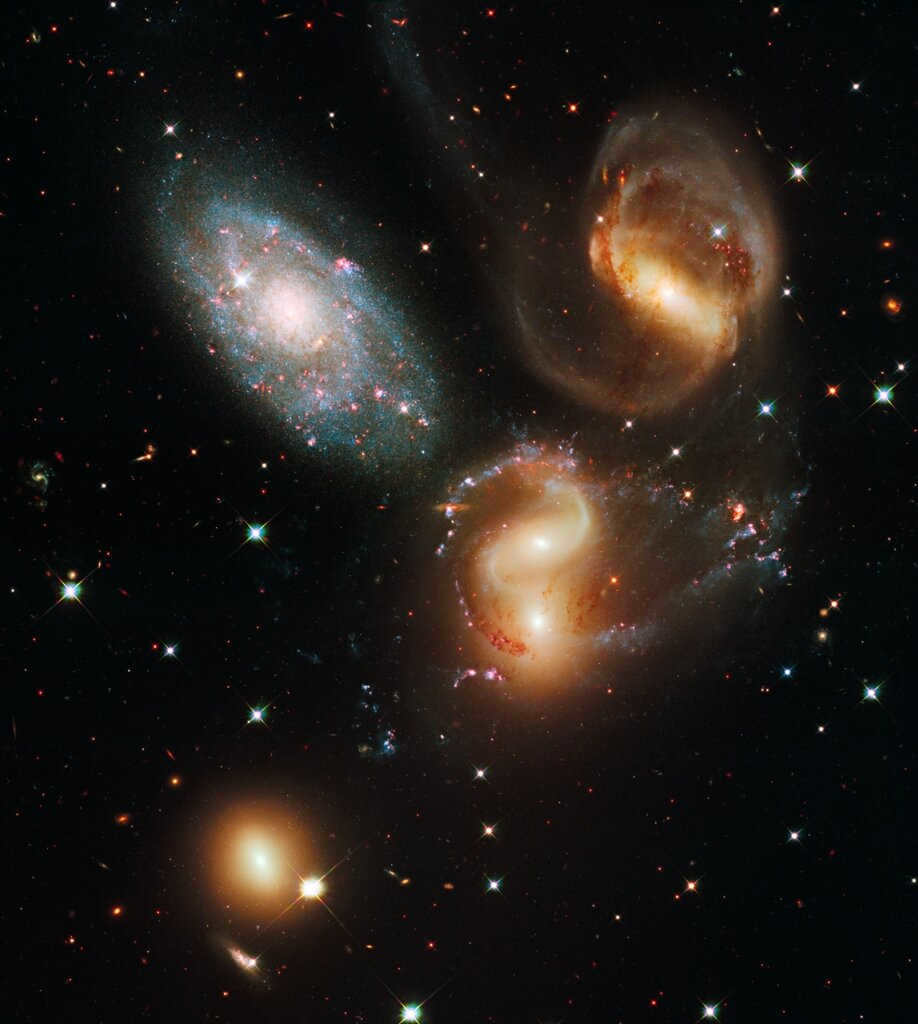
Astronomers have recently initiated a collaborative endeavor aimed at determining the precise locations of all the galaxies in the Universe. The objective of this project is to gain a more comprehensive understanding of the Universe’s structure on a grand scale. The vastness of the Universe is beyond the grasp of human cognition and comprehension. Our galaxy alone is a confluence of billions upon billions of stars, and there are billions more galaxies like ours. Although we are able to observe the light emitted by distant galaxies, it is difficult to fathom that we are essentially peering into the past, as it takes tens of billions of years for the light to reach us due to the immense distances involved.
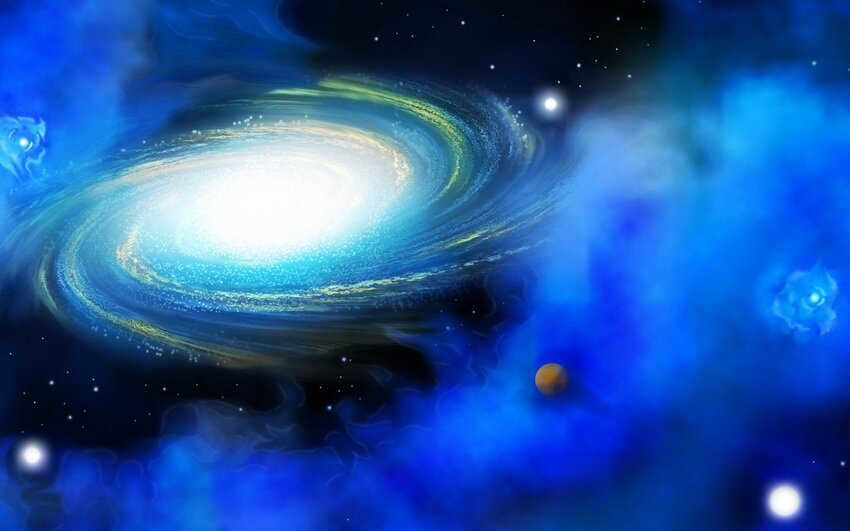
Astronomers categorize most galaxies into specific clusters. Our Milky Way is a member of a cluster containing 40 explored galaxies. These clusters are then organized into larger groupings known as superclusters. The cluster that includes our galaxy is part of the Virgo supercluster, which contains over 2,000 galaxies. As scientists mapped out the locations of these galaxies, the superclusters revealed distinct shapes. Many of these galactic superclusters are surrounded by enormous voids. The contents of these voids remain a mystery, whether they are filled with interplanetary-like space or a new form of matter. Unraveling this enigma will likely take a considerable amount of time.
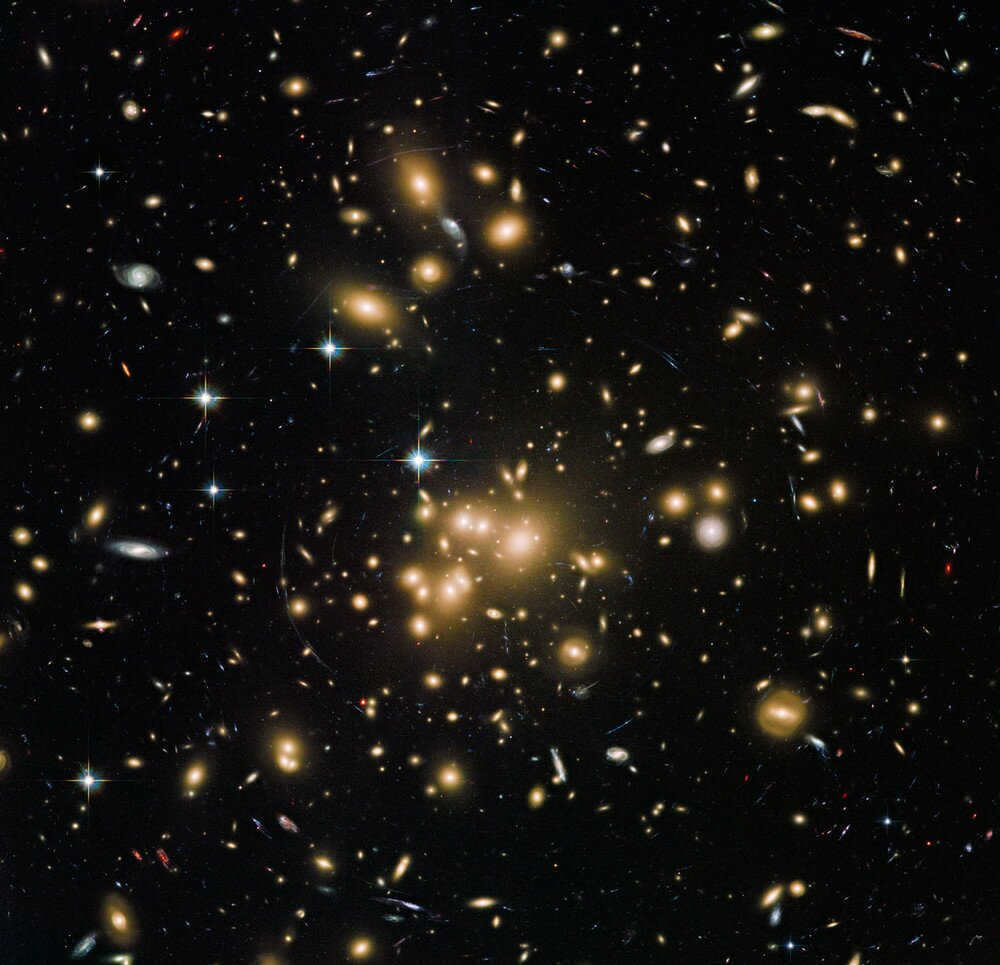
Galaxy interactions
The question of the interaction of galaxies as components of cosmic systems is of great interest to scientists. It is well known that space objects are constantly moving, and galaxies are no exception. Certain types of galaxies can cause the collision or merger of two cosmic systems. Understanding what these cosmic objects are like helps to explain the significant changes that occur as a result of their interaction. When two cosmic systems collide, a tremendous amount of energy is released. In fact, the meeting of two galaxies in the vast expanse of the Universe is even more common than the collision of two stars. However, not all galaxy collisions result in explosions. Sometimes, a smaller space system can pass by its larger counterpart without much change to its own structure.
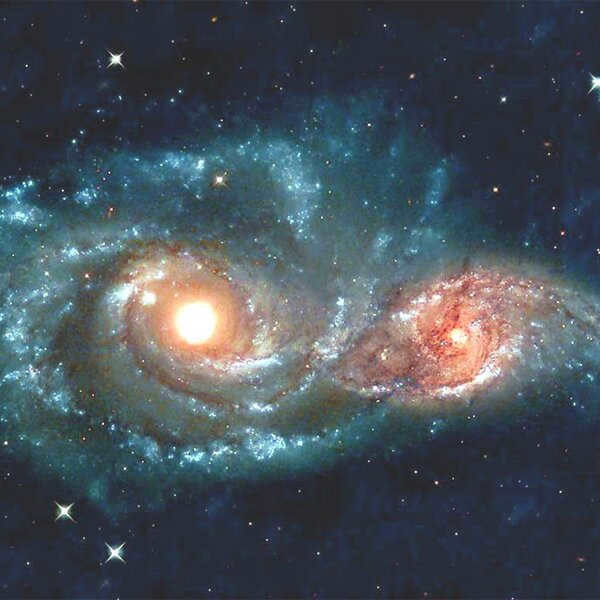
Hence, formations resembling elongated corridors come into existence. These formations exhibit distinct compositions of stars and gas zones, often giving rise to new celestial bodies. In some instances, galaxies do not collide head-on, but rather make slight contact with each other. Nevertheless, even such interactions set off a series of irreversible processes that result in significant alterations to the structure of both galaxies.

What lies ahead for our galaxy?
According to scientists, there is a possibility that in the distant future, the Milky Way may assimilate a small satellite system of cosmic proportions, located 50 light years away from us. Research indicates that this satellite has the potential for a long lifespan, but when it eventually collides with its colossal neighbor, it is expected to cease its independent existence. Astronomers also foresee a collision between the Milky Way and the Andromeda Nebula. These galaxies are converging towards each other at the speed of light. The anticipated collision is estimated to occur around three billion Earth years from now. However, the actual likelihood of this event taking place is difficult to speculate due to the limited data available on the movement of both cosmic systems.
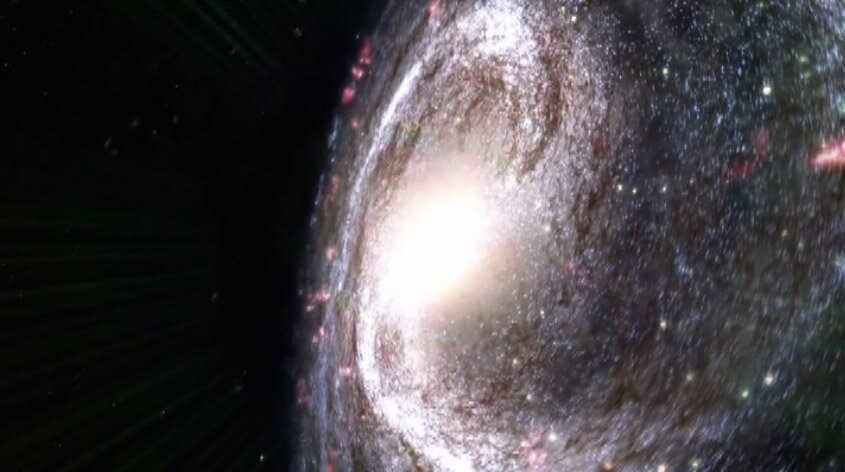
Description of galaxies on Kvant.Space
At Kvant.Space portal, you will be transported to an intriguing and captivating realm of outer space. Delve into the intricacies of the Universe and acquaint yourself with the composition and structure of renowned galaxies. By perusing articles about our very own galaxy, we gain a deeper understanding of the celestial phenomena that grace our night sky.
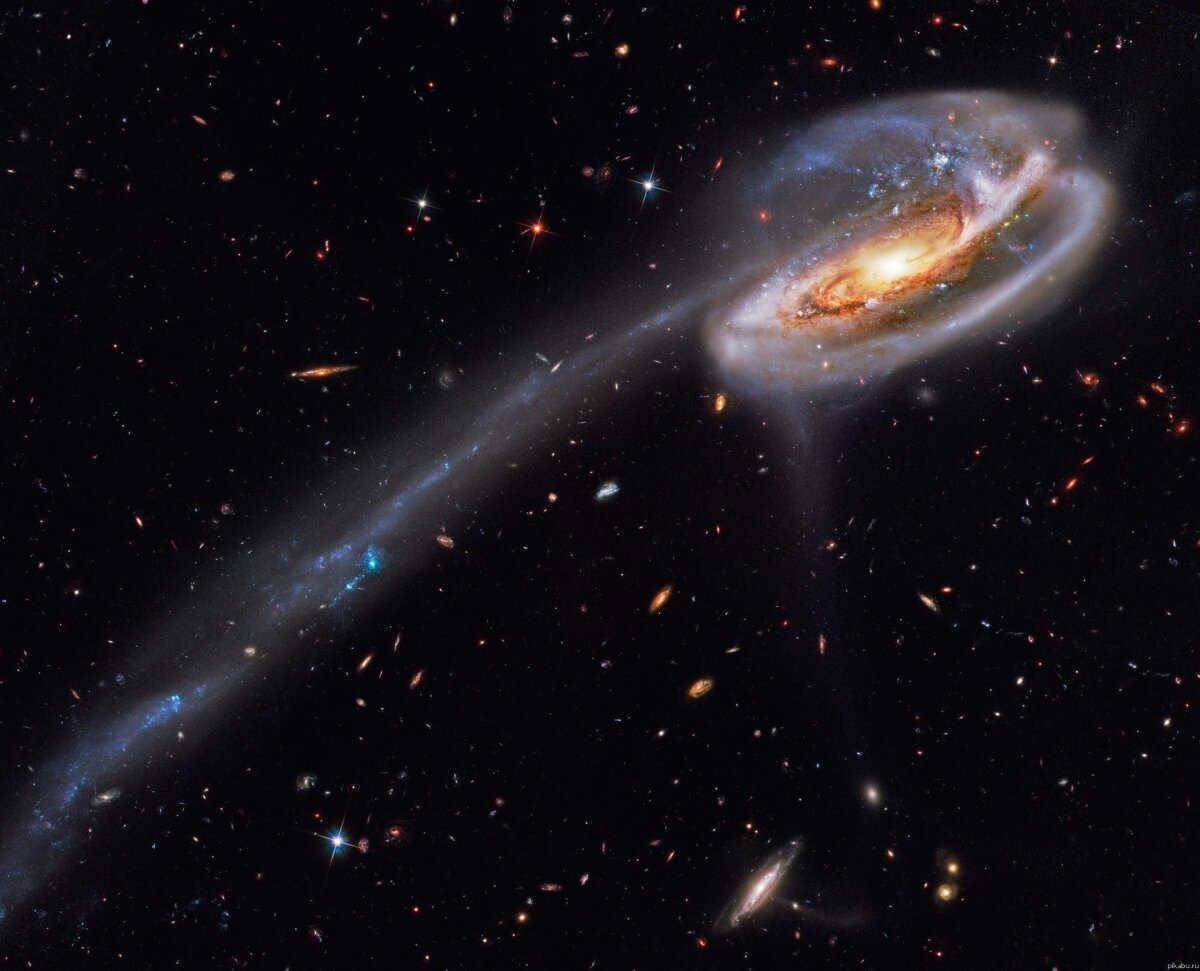
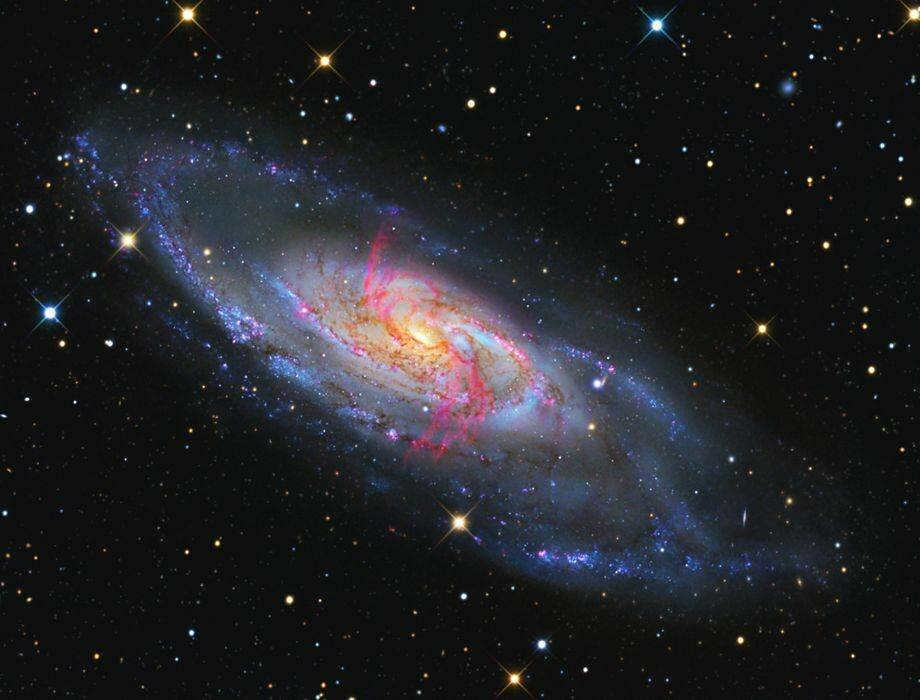
Currently, scientists worldwide are grappling with the enigma of the role played by dark matter in the formation of galaxies, a substance that only reveals itself through gravitational interaction. In certain massive galaxies, it accounts for approximately 90% of the overall mass, while in dwarf galaxies, it may be completely absent.
The development of galaxies
Experts hold the view that the origin of galaxies is an inherent part of the progression of the cosmos, which occurred due to the impact of gravitational forces. About 14 billion years in the past, the creation of protoscatter commenced within the primary substance. Subsequently, as a result of diverse dynamic mechanisms, clusters of galaxies became distinct. The multitude of galaxy configurations can be accounted for by the assortment of initial circumstances in their formation.
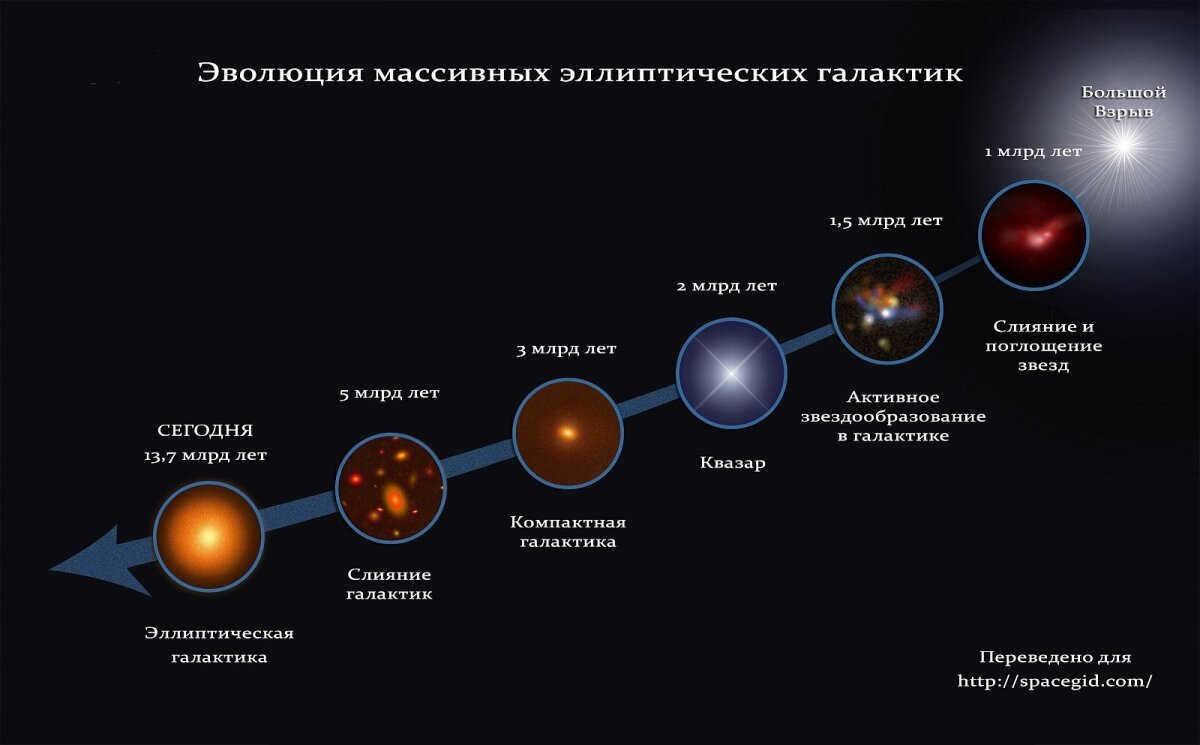
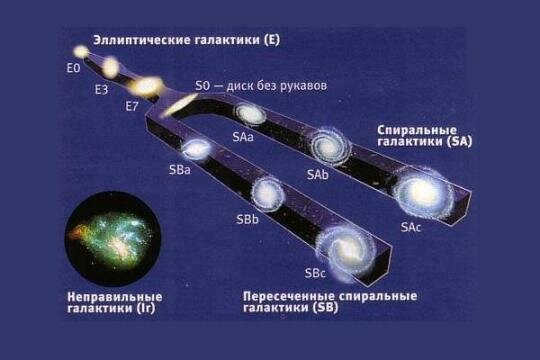
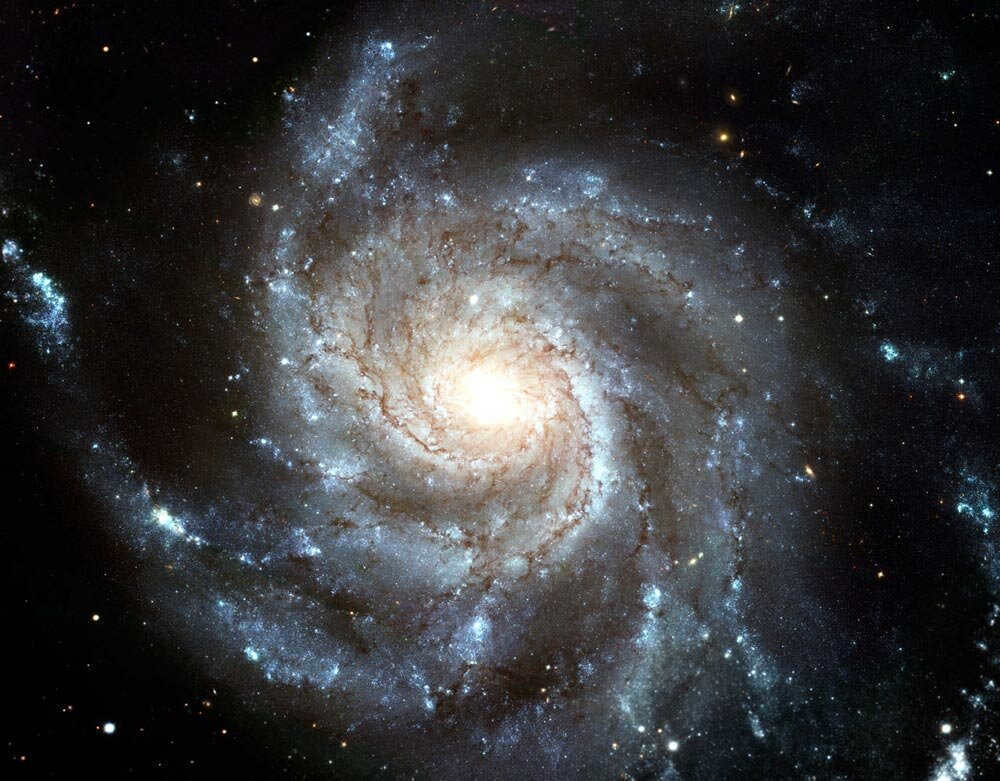
Discover a wealth of captivating content on the exploration of galaxies at the Kvant.Space portal. Immerse yourself in a world of uncharted space with our collection of fascinating news, scientific insights, and original articles. Experience the wonders of the cosmos through high-quality satellite and telescope imagery, as well as thrilling videos that are bound to leave a lasting impression. Join us on this journey of discovery!
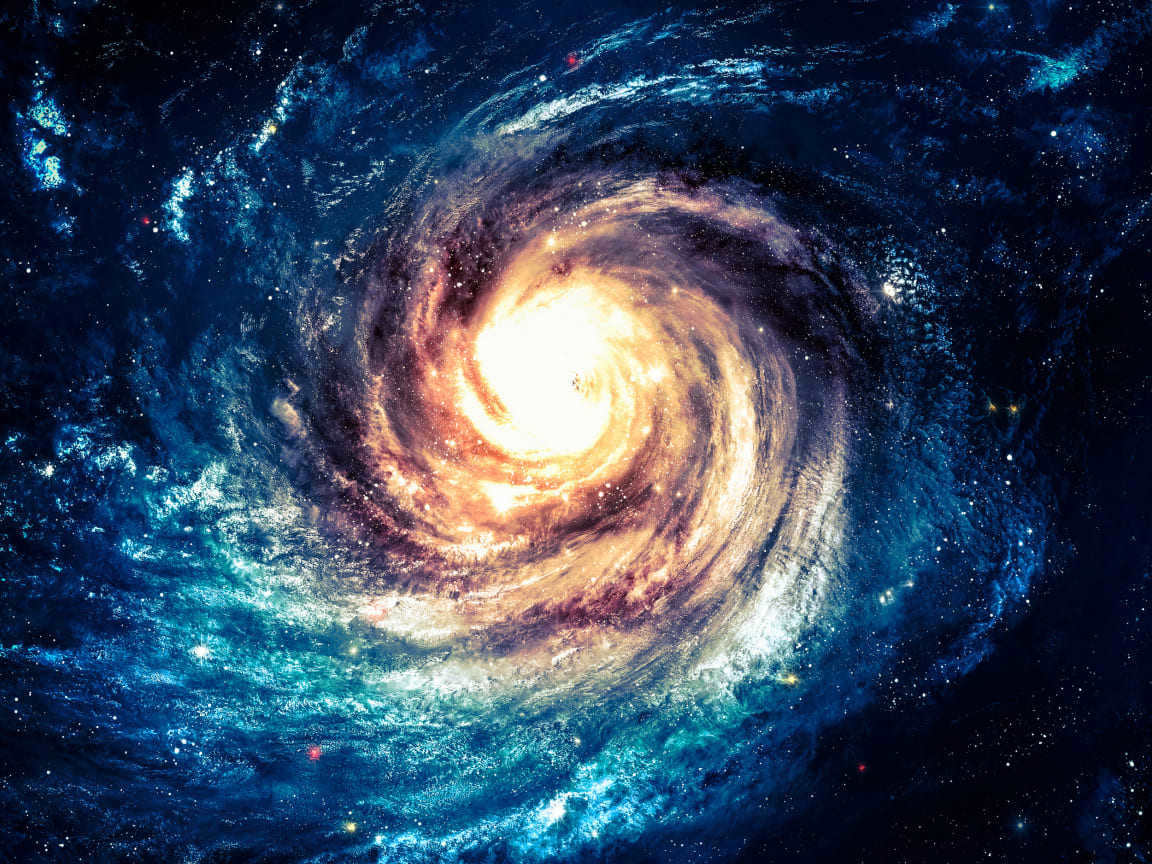
A galaxy is essentially a collection of stars, remnants of stars, and other celestial objects that are held together by the force of gravity. Galaxies come in different shapes and sizes, and each one orbits around its own center of mass.
Our understanding of galaxies, including our own Milky Way, has evolved over time. It started with the philosophical ideas of Aristotle in the 5th century BC and has since been shaped by groundbreaking discoveries like those made by Edwin Hubble in the early 1920s. In the late 20th and 21st centuries, there have been significant scientific advancements in our knowledge of galaxies.
It is estimated that there are at least two trillion galaxies in the observable universe. Each galaxy has its own unique characteristics and can vary in shape and size.
In order to accurately study individual galaxies, astronomers and researchers utilize a morphological classification called the Hubble sequence, which was developed by Edwin Hubble.
This classification method was later adjusted by French astronomer Gerard de Vaucouleur in 1959. Using these classifications and a number of other distinguishing features, we will now examine the various types of galaxies.
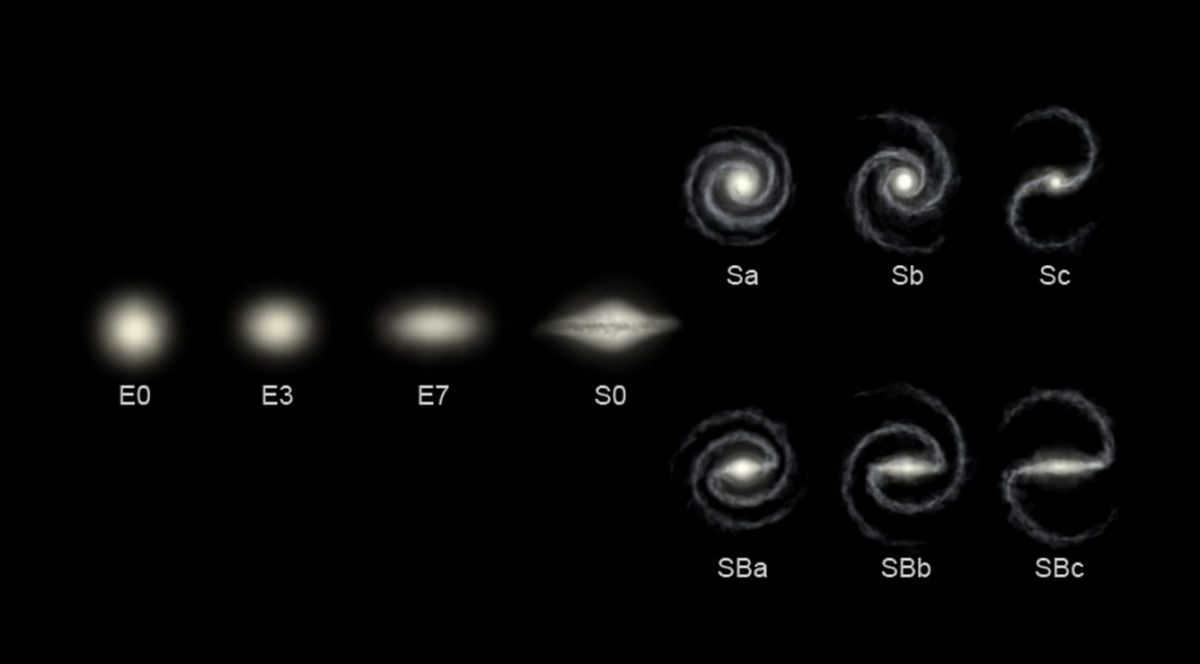
In 1926, Edwin Hubble introduced the Hubble classification, which was the first ever morphology-based scheme to categorize galaxies. This classification system distinguishes three primary types of galaxies: Elliptical, spiral, and lenticular. To further classify galaxies, Hubble’s system employs the Chamberlain diagram, which subdivides these broad categories.
Elliptical galaxies
Elliptical galaxies are characterized by their smooth and featureless appearance. In the Hubble classification system, these galaxies are categorized based on their level of ellipticity, ranging from E0, which is nearly spherical, to E7, which is highly elongated.
One distinctive characteristic of elliptical galaxies is their lack of open clusters, which are groups of a few thousand stars. These galaxies also have low levels of star formation and are primarily composed of older, more evolved stars.
The largest galaxies in the observable Universe are elliptical in shape. Some of these galaxies can span over 700,000 light-years and have masses equivalent to about 10^13 solar masses, or 1,000,000,000,000,000,000,000,000,000,000,000,000,000 solar masses.
Notable examples of elliptical galaxies include: Messier 87, IC 1101, and Maffei 1 (the nearest elliptical galaxy).
Spiral galaxies: a unique phenomenon in the universe
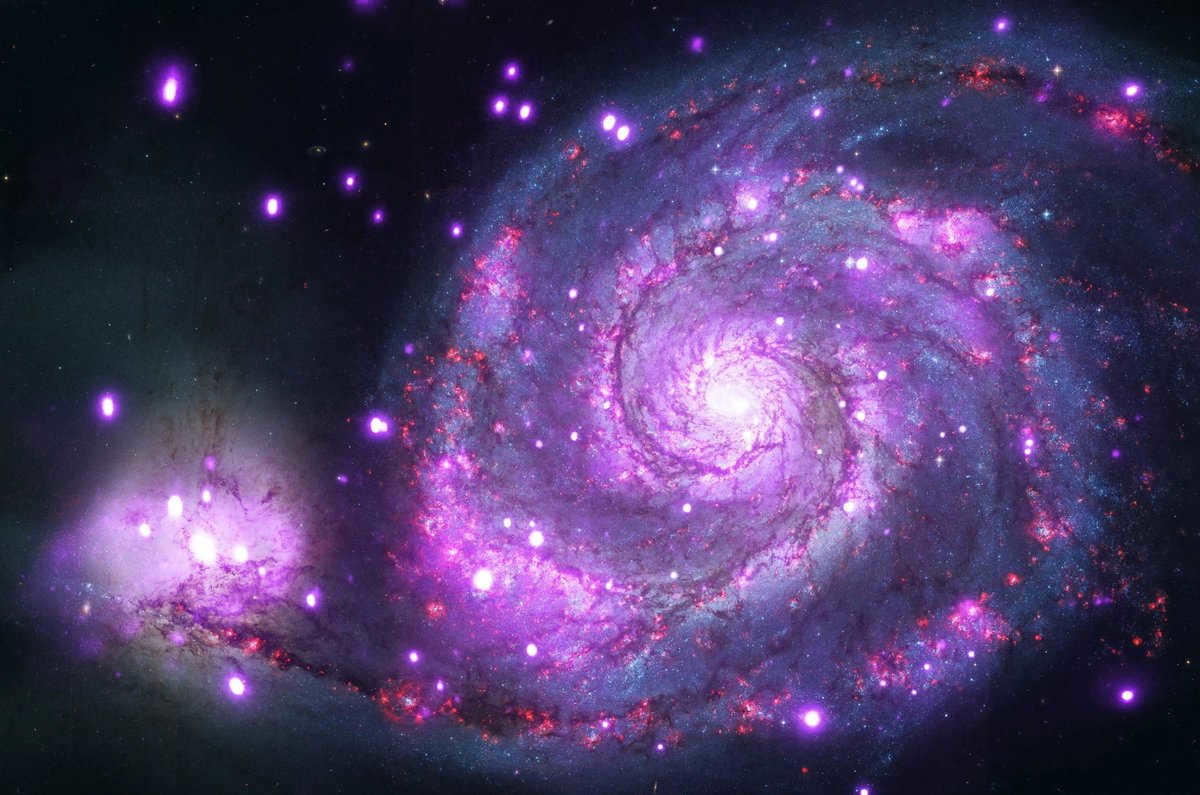
Spiral galaxies can be easily identified by their vibrant spiral arms, typically two in number, and a central bulge that is predominantly populated by aging stars. According to the Hubble classification system, spiral galaxies are labeled with the English letter “S” followed by an “a”, “b”, or “c” to indicate the degree of closeness between the spiral arms (with “a” representing a close proximity).
The spiral arms of a galaxy are easily distinguishable due to the abundance of young stars that are still in the process of formation.
An SB galaxy, also known as a jumper spiral galaxy, is a unique type of spiral galaxy that features a bar-like structure stretching outward from its center. These galaxies make up more than half of all observed spiral galaxies. Hubble assigns them the designation SB, followed by lowercase letters a, b, or c, similar to the classification system for regular spiral galaxies.
The bar structures in jumper spiral galaxies are believed to be temporary, gradually decaying over time. They are thought to be caused by either energy released from the galactic core or by intense gravitational interactions with neighboring galaxies.
The Milky Way, home to two billion stars including our Sun, was initially classified as a regular spiral galaxy but has now been confirmed as a junction spiral galaxy.
Examples of junction spiral galaxies: Milky Way, Andromeda Galaxy, and Whirlpool Galaxy.
Lenticular (lens-shaped) galaxy
In the Hubble system, at the point where the two branches of spiral galaxies split, there exist intermediate galaxies categorized as S0.
Lenticular galaxies, like the ones mentioned above, possess a prominent bulge at their core and exhibit an elliptical shape. However, unlike spiral galaxies, lenticular galaxies lack spiral arms and do not undergo substantial star formation.
Some examples of lenticular galaxies include: Cartwheel, NGC 2787
The De Vaucouleurs galaxy classification system
is a system used to classify galaxies based on their visual appearance. It was developed by the French astronomer Gerard de Vaucouleurs in the 1950s and has since become widely adopted in the field of astronomy. The system categorizes galaxies into different types, including elliptical galaxies, spiral galaxies, and irregular galaxies. Each type is further divided into subclasses based on various characteristics, such as the shape of the galaxy’s bulge, the presence of a bar, and the tightness of the spiral arms. This classification system has been instrumental in understanding the diversity of galaxies and studying their formation and evolution.
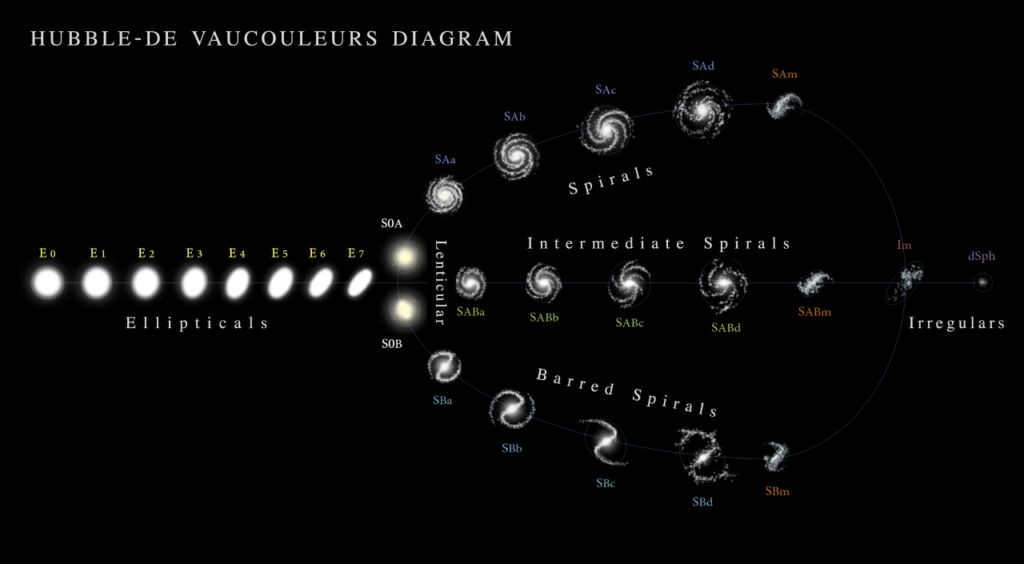
French astronomer de Vaucouleur expanded on the Hubble sequence to create a more comprehensive classification system for galaxies. He argued that the existing Hubble classification was inadequate and did not fully capture the diversity of galaxies.
De Vaucouleur’s system maintains the core classifications of galaxies, including elliptical, spiral, lenticular, and irregular, but also introduces a more detailed classification that takes into account features such as rings, bars, and spiral arms.
There are also other types of galaxies that can be classified based on their morphology.
Unusual galaxy: An unusual galaxy, as its name implies, is a galaxy with an odd shape, size, and composition that is not yet fully understood. Only a small fraction of all discovered galaxies fall into the category of unusual galaxies. Astronomers currently identify two types of unusual galaxies: AGNs (active galactic nuclei) and interacting galaxies.
These types of galaxies are believed to result from a gravitational struggle between two galaxies when they come into close proximity to each other. The affected areas of the galaxies develop distinctive visual characteristics due to the intense tidal interaction.
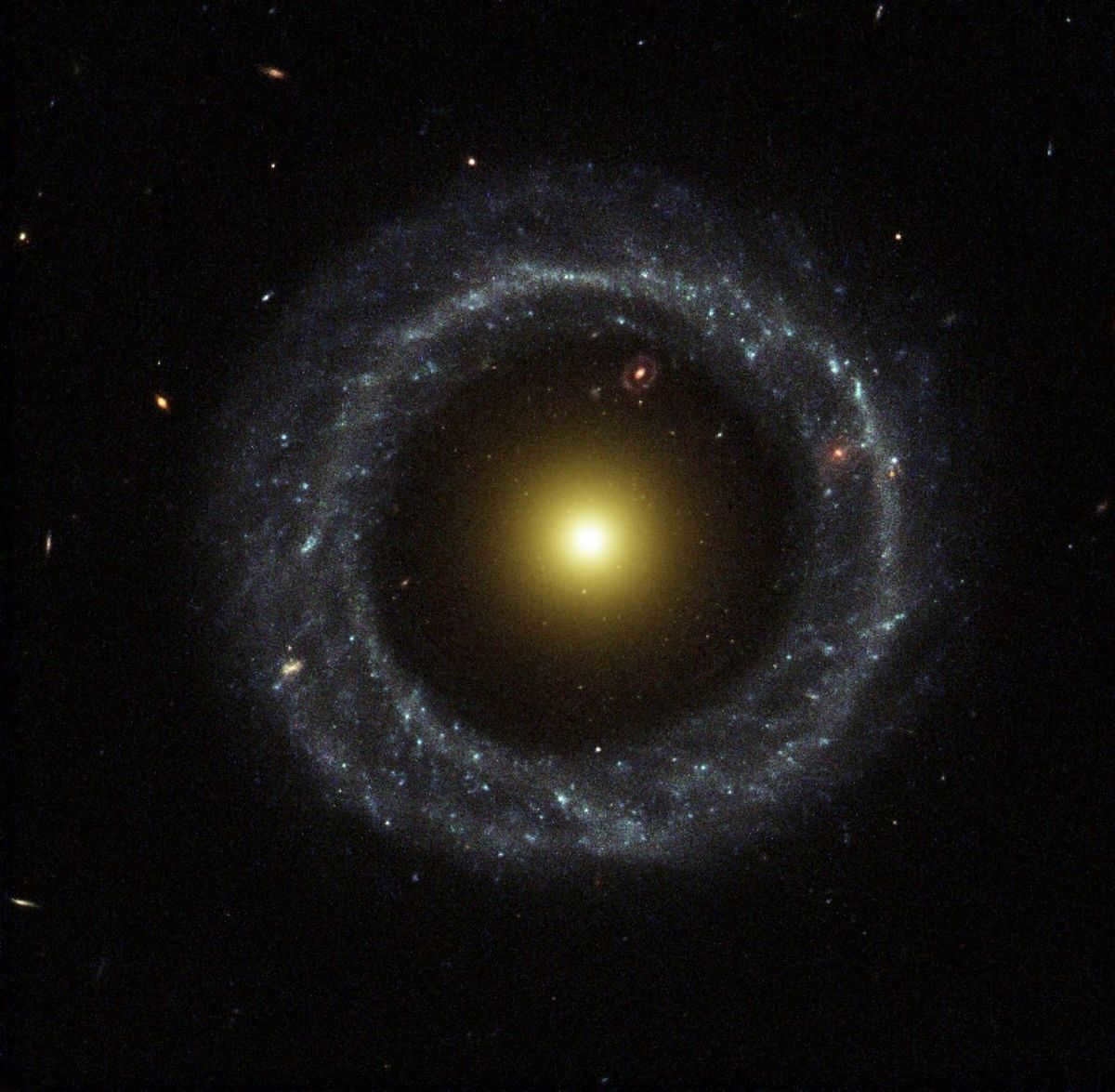
A type of galaxy known as a ring galaxy consists of numerous young, massive, and luminous stars that encircle a relatively dimmer core. A prime example of a ring galaxy is Hog’s object, which can be found approximately 600 million light-years away in the Serpent constellation.
One prevailing explanation for the formation of ring galaxies involves the gravitational collapse that occurs when a smaller galaxy passes near the core of a larger galaxy.
Irregular galaxies: Irregular galaxies are galaxies that defy classification as either elliptical or spiral. They possess a disorderly appearance and lack both spiral arms and a central bulge. Irregular galaxies can be further categorized into three subtypes: irr-I galaxies, irr-II galaxies, and dI galaxies, none of which conform to the Hubble diagram.
Active galaxies
In the previous section, we discussed galaxies based on their morphology or appearance. However, if a galaxy contains an active galactic nucleus, it can also be classified as an active galaxy, regardless of its shape.
So, what exactly is an active galactic nucleus? Well, it is a compact region near the center of a galaxy that emits a higher-than-normal amount of light across the entire electromagnetic spectrum.
Active galaxies can be divided into two categories: radio-quiet AGNs and radio-loud AGNs. Radio-quiet AGNs, like the Seyfert galaxies, exhibit narrow and sometimes broad emission lines, occasional strong X-ray emission, and weak radio jets. Other types of radio-quiet AGNs include LINER, Quasar 2, and radio-quiet quasars.
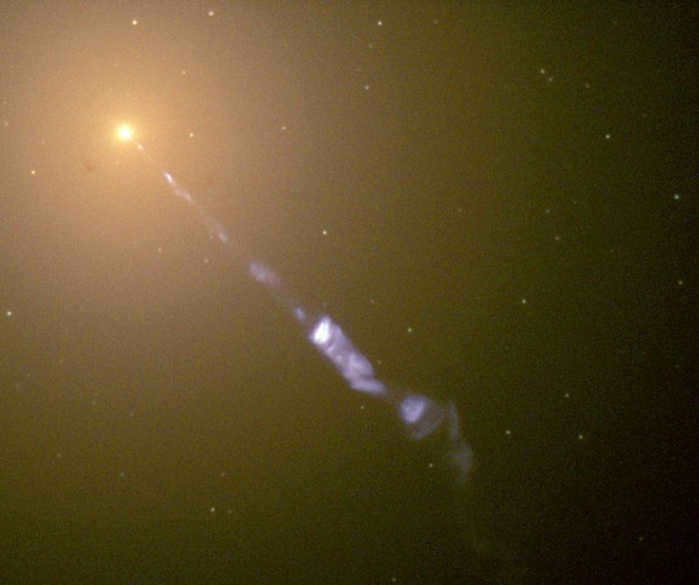
However, there is a stark contrast when it comes to Blazars, which are a specific type of radio-loud active galaxies. Blazars stand out due to their high levels of X-ray and radio emissions, as well as the presence of powerful jets. These characteristics set them apart from other types of radio-loud active galaxies, such as optically strong variable quasars and radio galaxies.
A galaxy experiencing a burst of star formation
Starburst galaxies are known for their ability to produce new stars at an incredibly rapid rate. This rate of star formation is so intense that starburst galaxies tend to exhaust their entire reservoir of star-forming gas much quicker than other types of galaxies. Most observed starburst galaxies are either in the midst of a galactic merger or are on the verge of colliding with another galaxy.
Over the years, astronomers have developed various classifications for star-forming galaxies based on their distinct visible characteristics. These classifications include blue compact galaxies, luminous infrared galaxies, and Wolf-Rayet galaxies. One specific example is detailed below.
Luminous infrared galaxies: Infrared galaxies are probably individual gaseous spirals that get their infrared brightness from either a dense population of stars in a small area or from an active galactic nucleus. Luminous infrared galaxies are estimated to have a luminosity that exceeds 100 billion times that of the Sun.
There is a widespread belief that certain luminous infrared galaxies produce approximately 100 new stars each year, in contrast to the Milky Way’s production of only 7 stars annually. This is how they sustain their exceptionally high levels of brightness.

